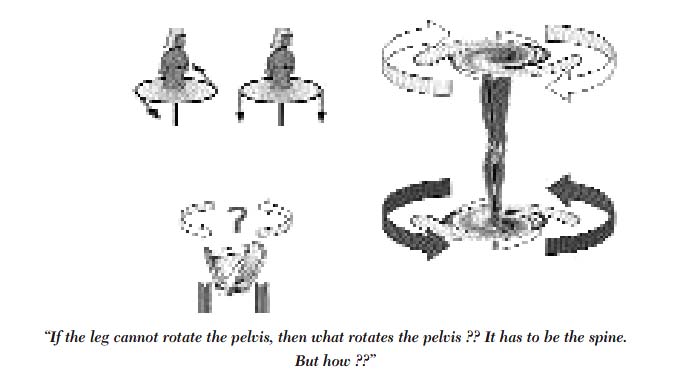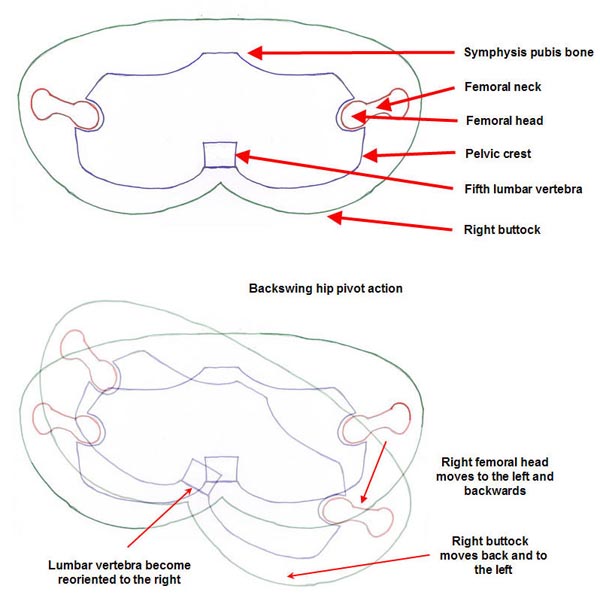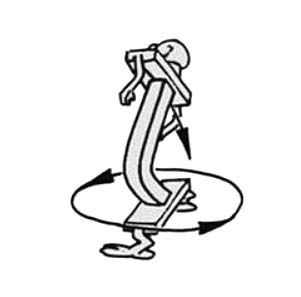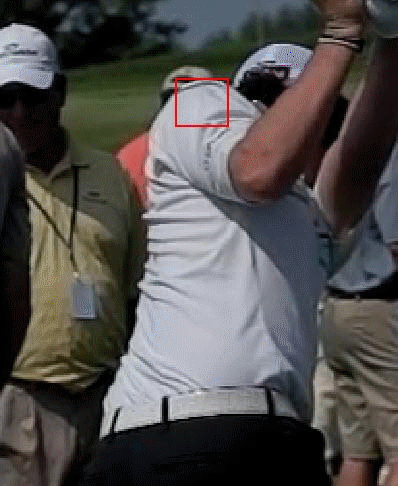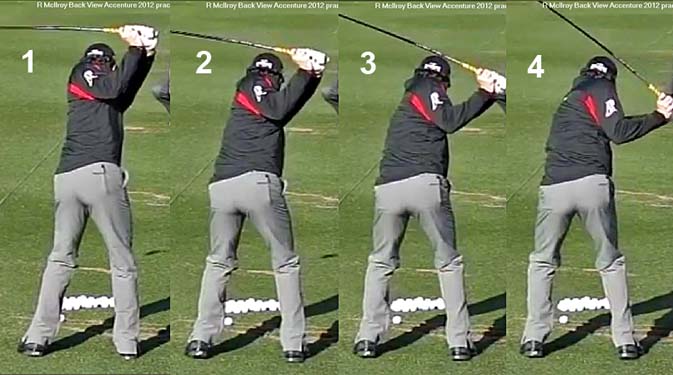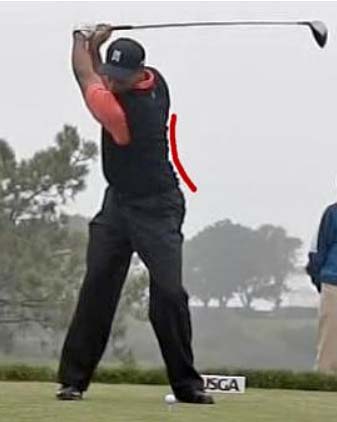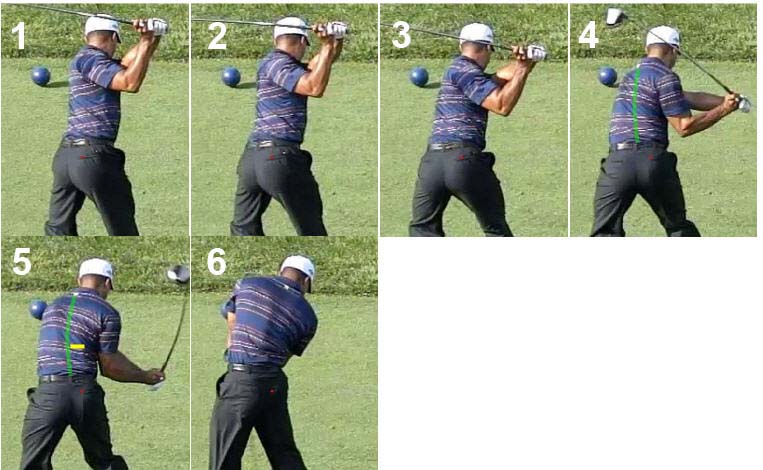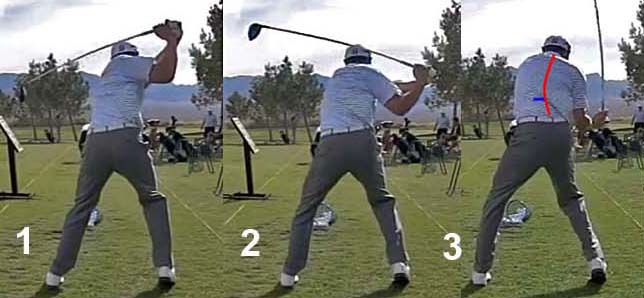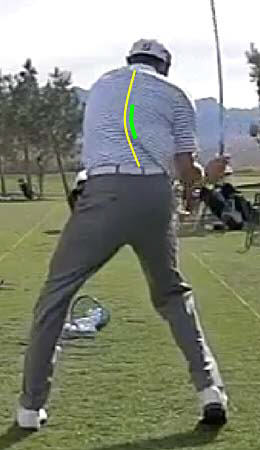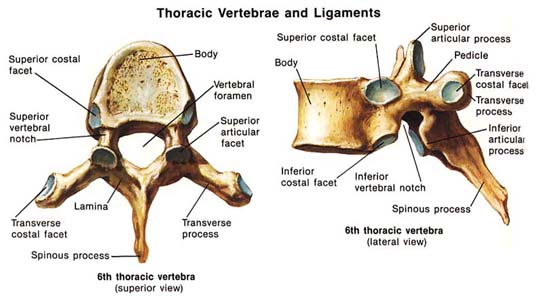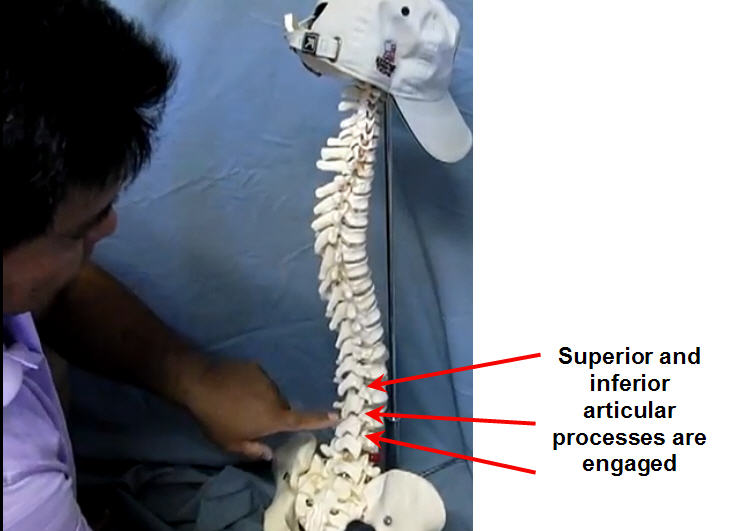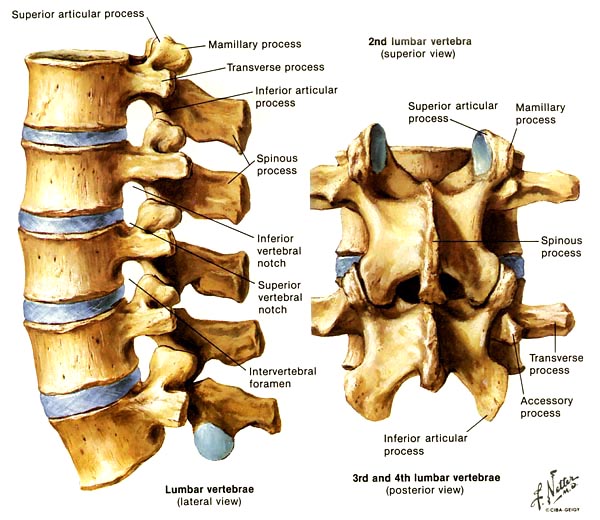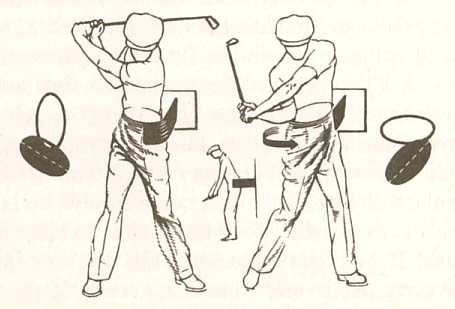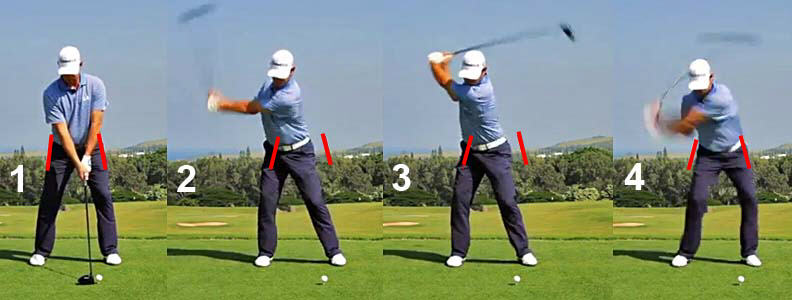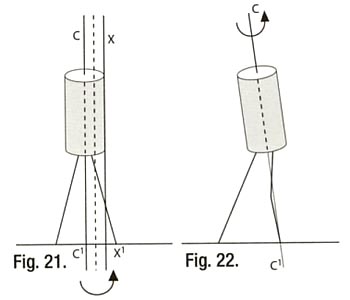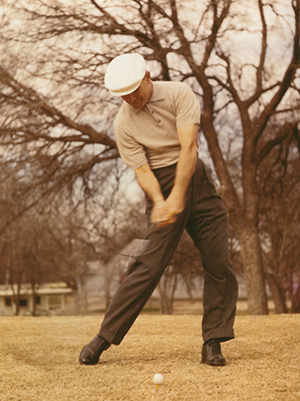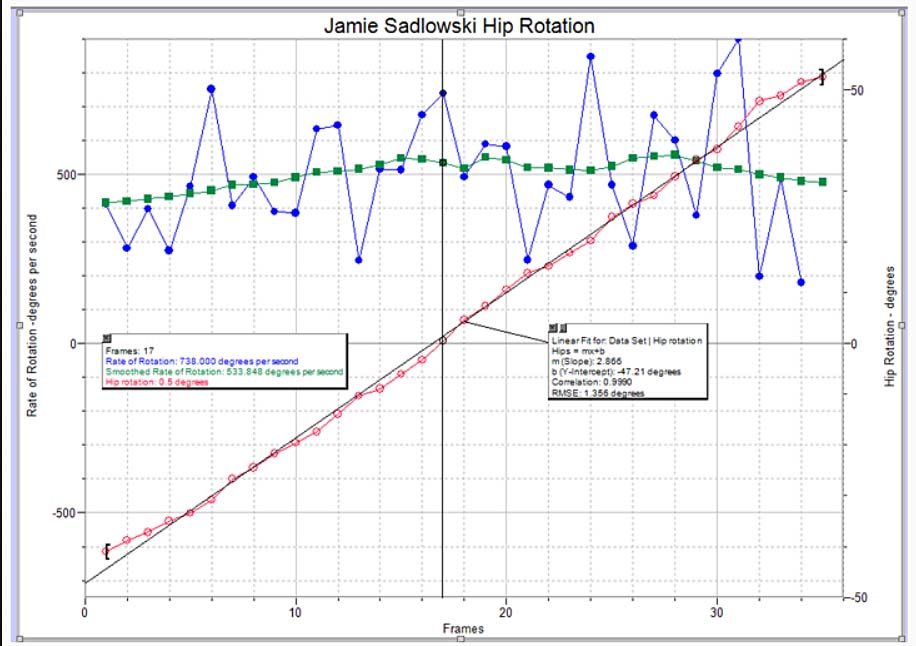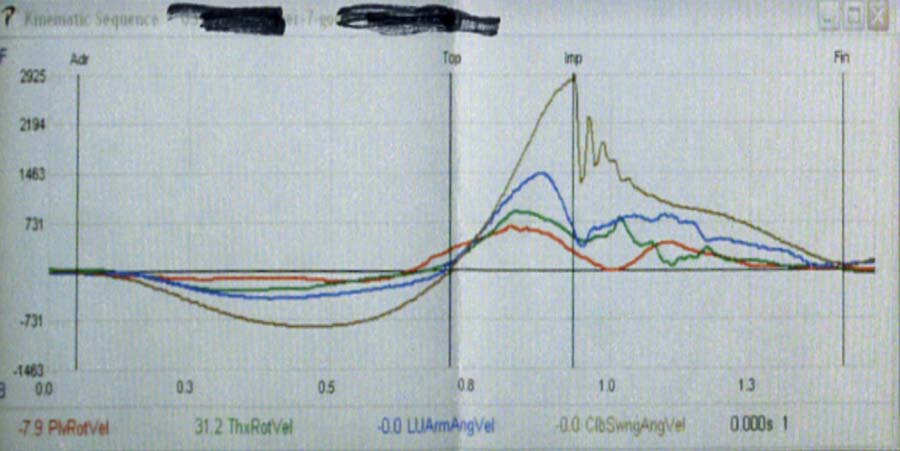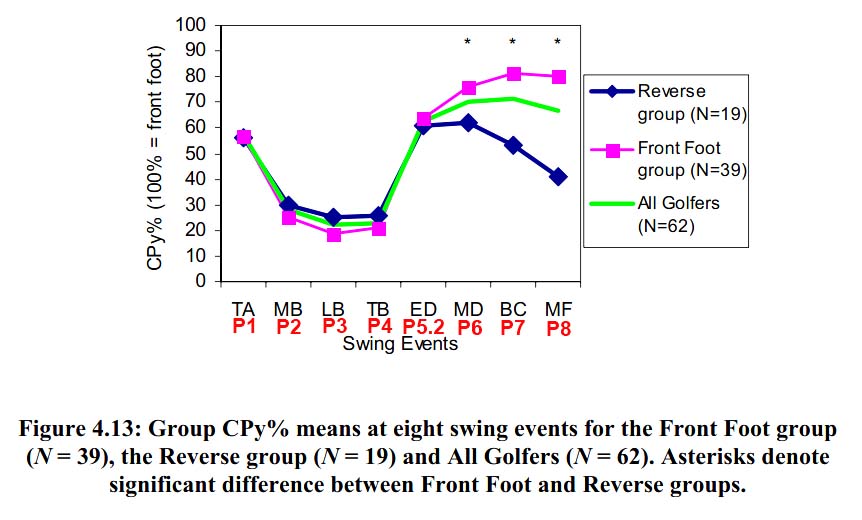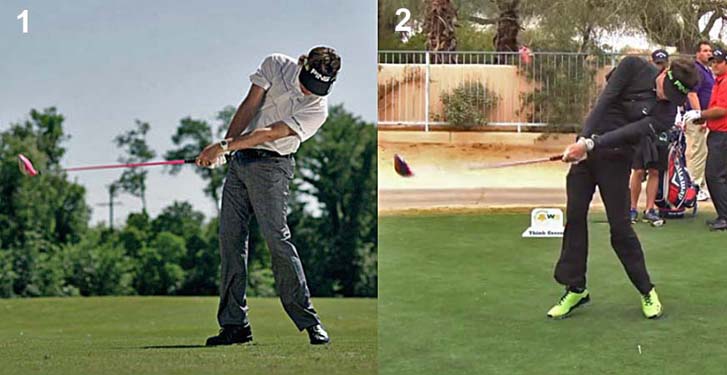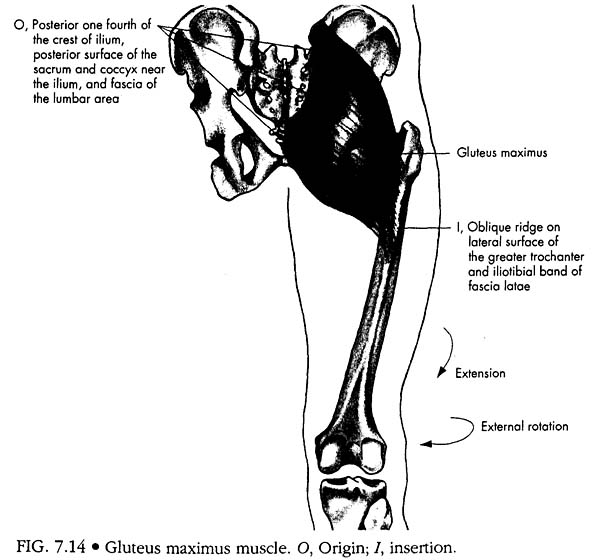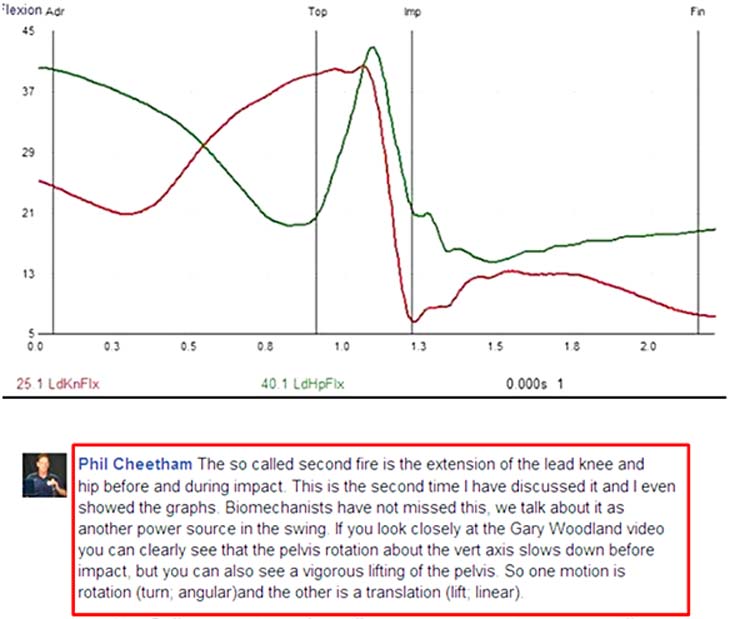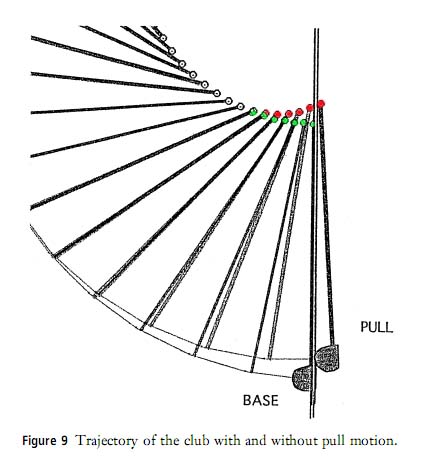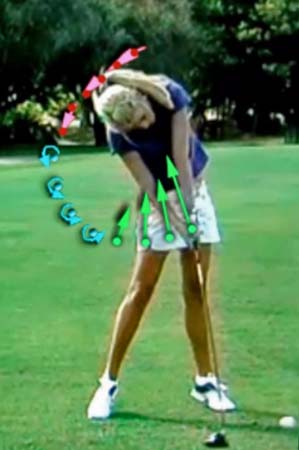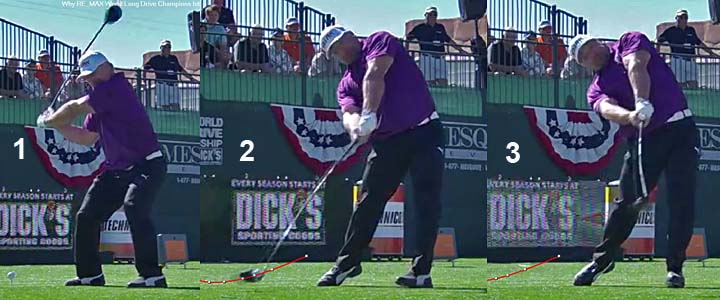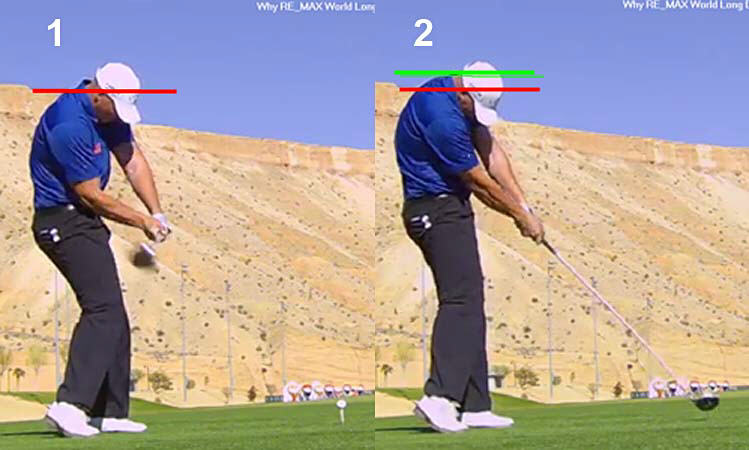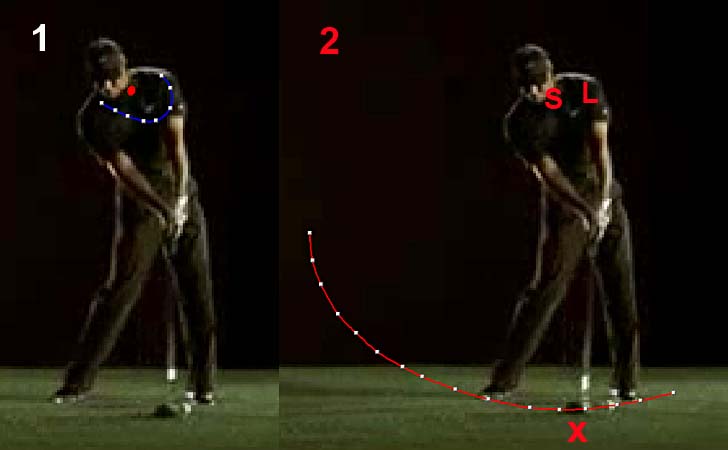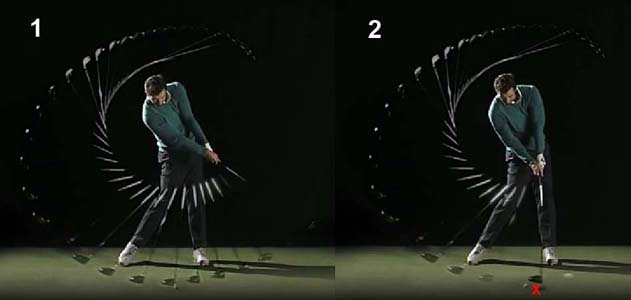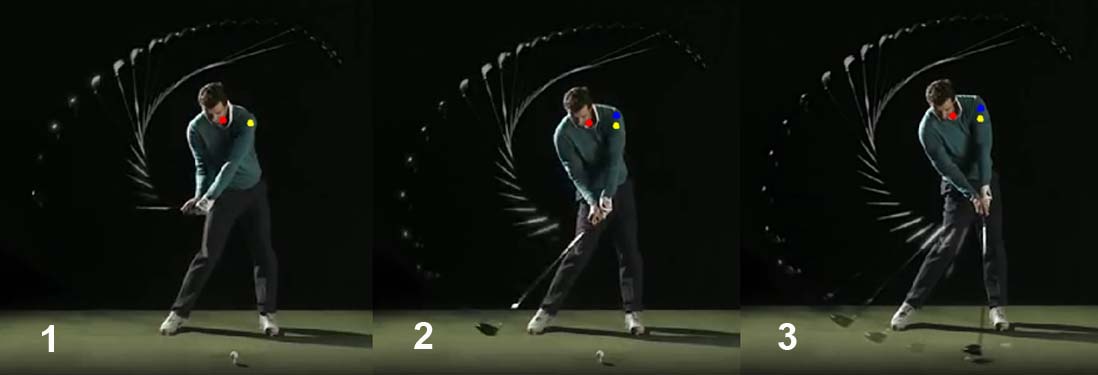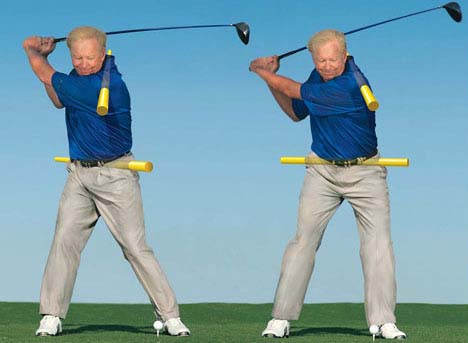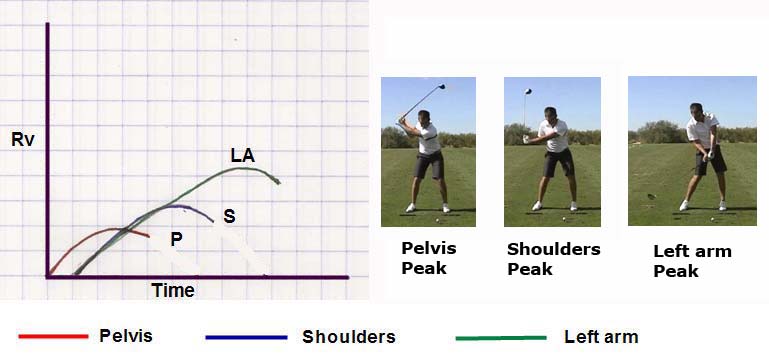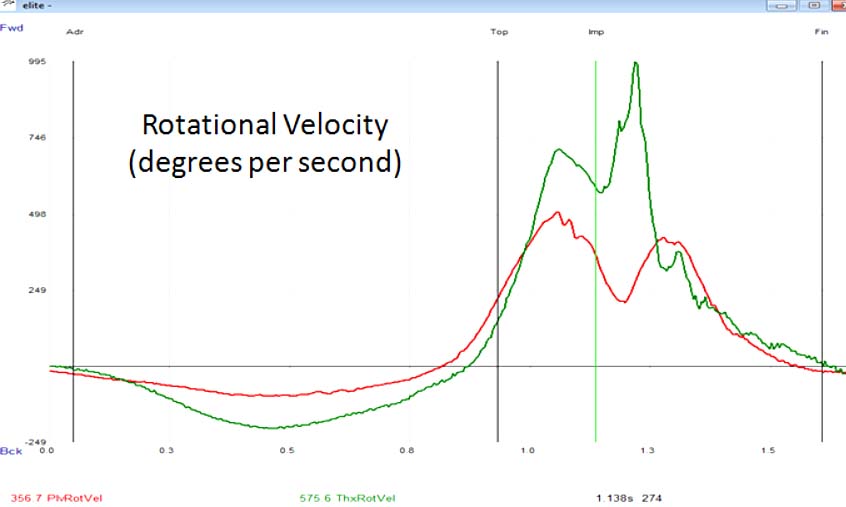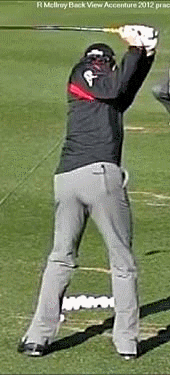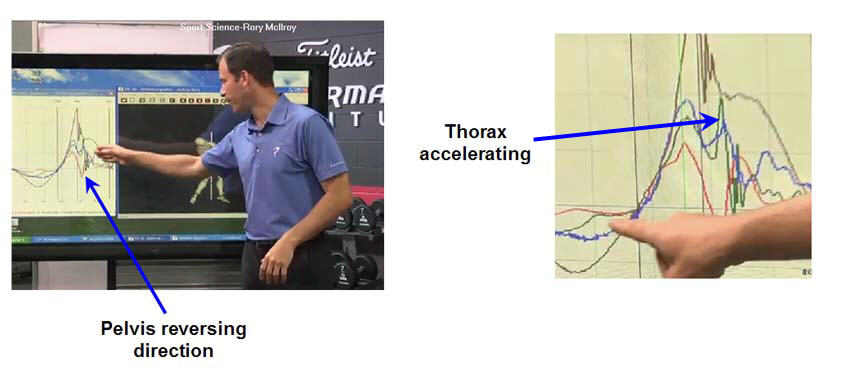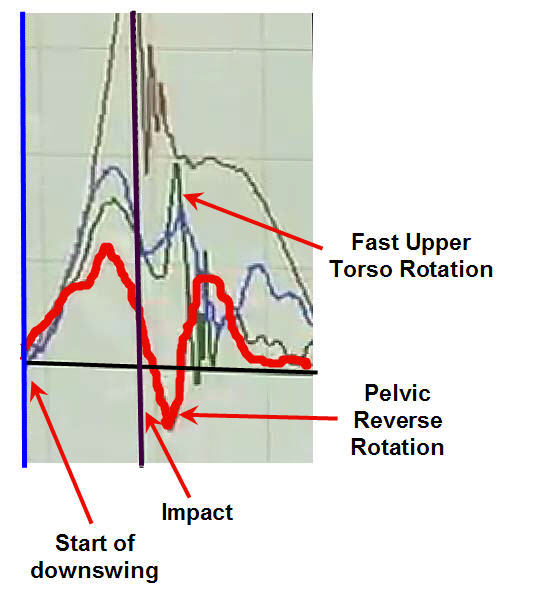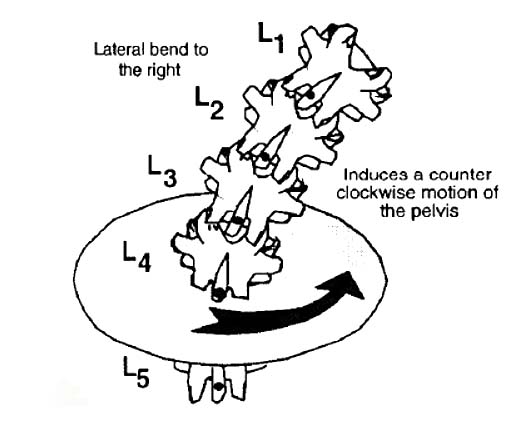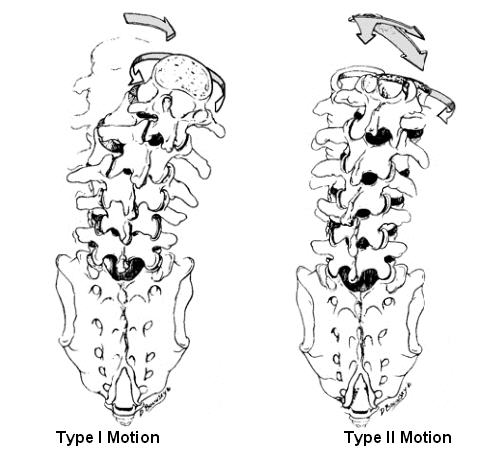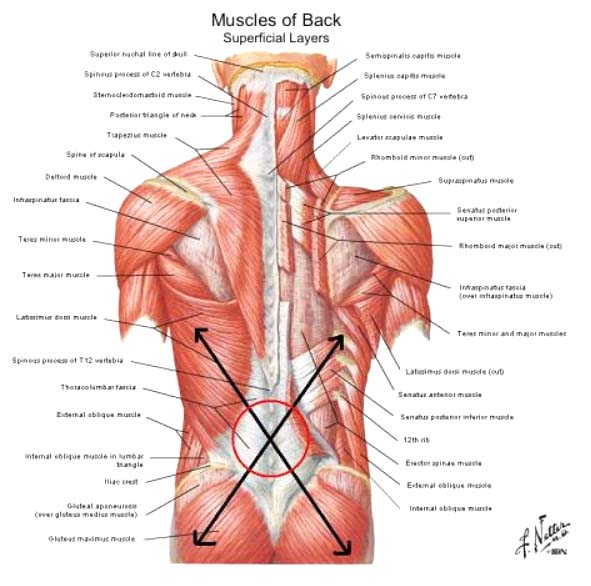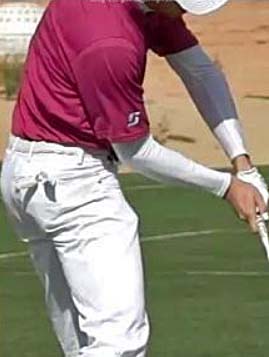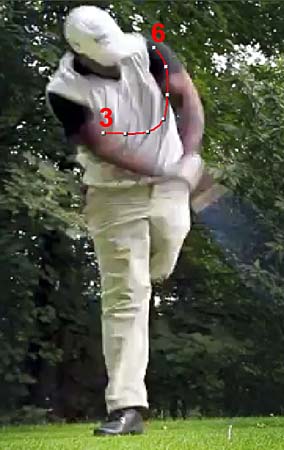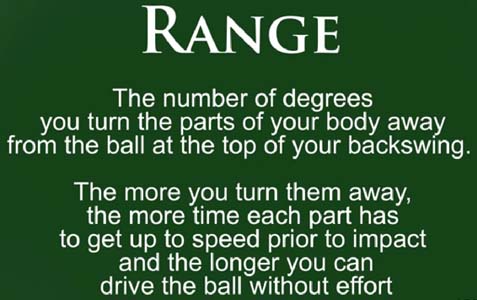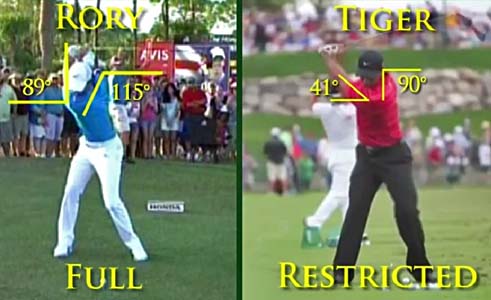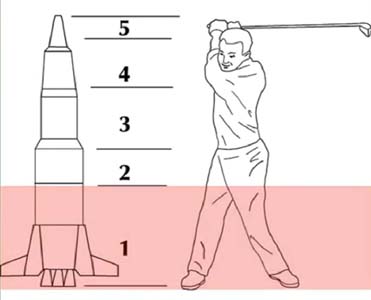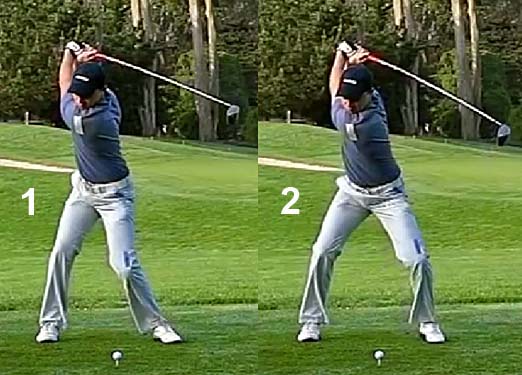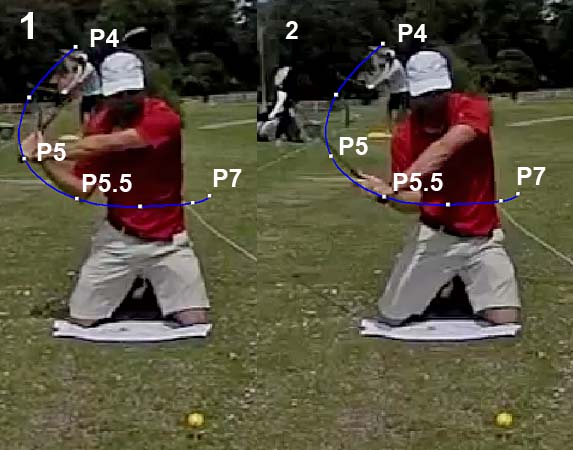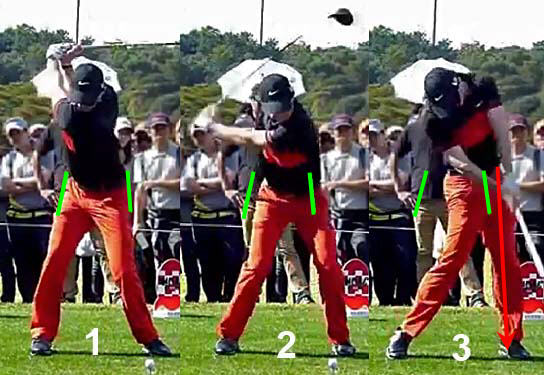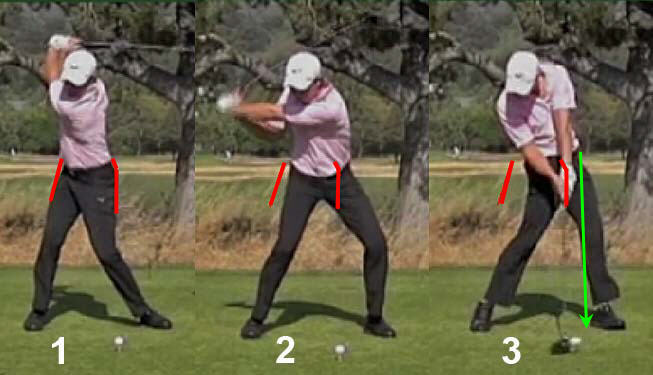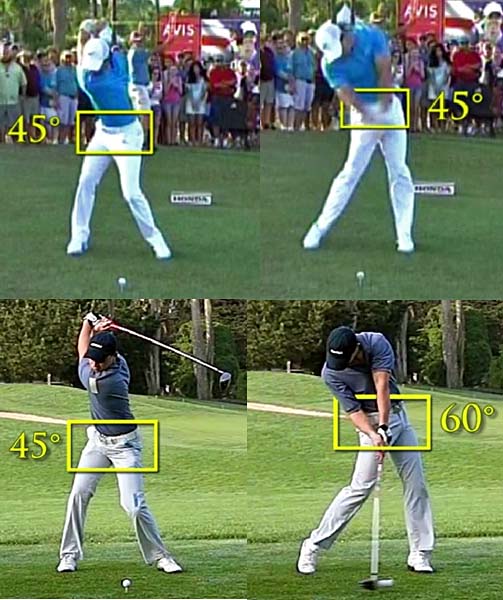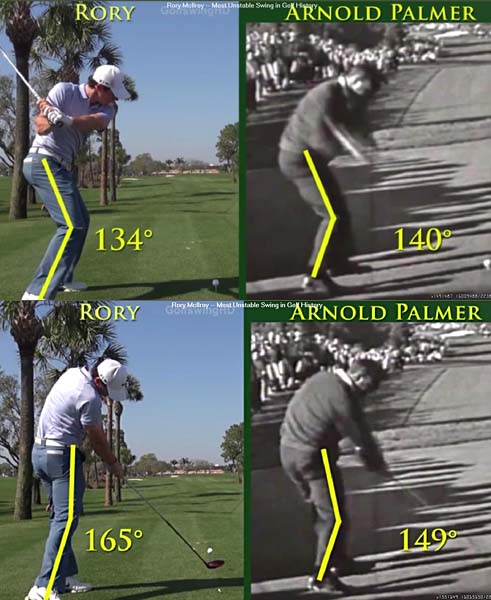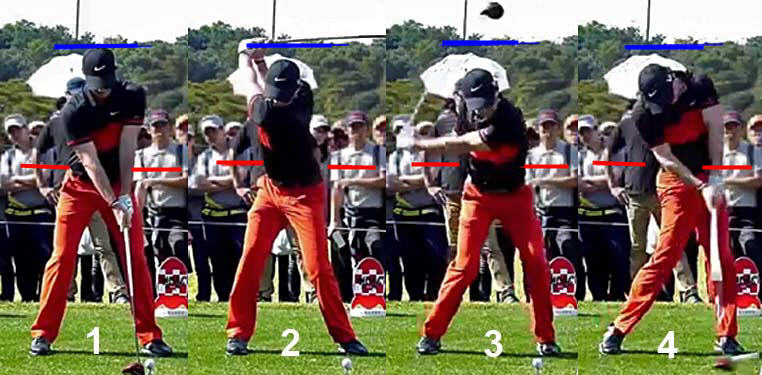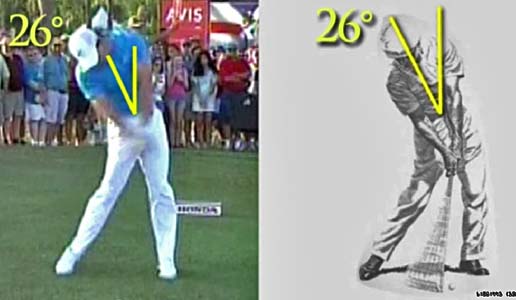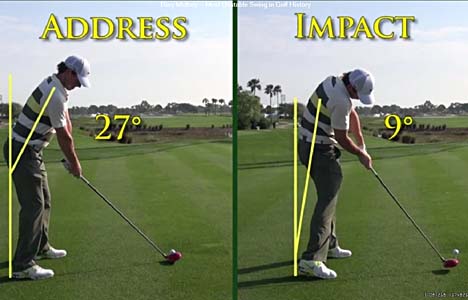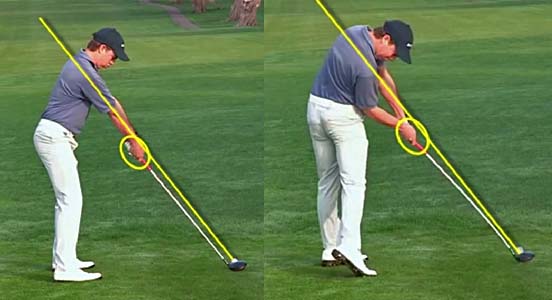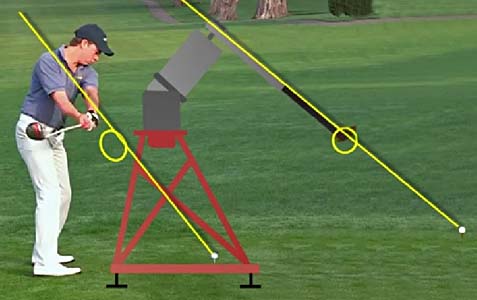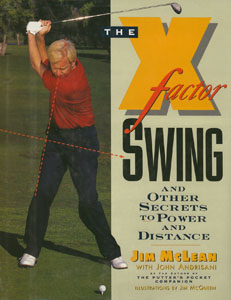Critical analysis of theories/opinions regarding optimum spinal and pelvic motion in the full golf swing
Click here to go back to the home page.
Introduction:
In this review paper I will be critically analysing a number of theories (and opinions) that golf instructors have arbitrarily promoted regarding the optimal biomechanical performance of spinal motion and pelvic motion in the full golf swing. Many golf instructors have very didactic beliefs regarding the issue of how best to perform spinal and/or pelvic motions in the full golf swing, and I will be critically dissecting and critiquing their opinions in order to demonstrate a multiplicity of flaws in their personal thinking. During my critical analysis, I will be simultaneously expressing my own (updated) personal opinions regarding multiple topics related to spinal and pelvic motions in the full golf swing, and these topics will also include side-issues related to the coordination of upper torso (shoulders) relative to lower torso (pelvic) motions. These updated opinions will reflect my personal thinking as of 2015, and readers will be able to compare my updated opinions to my previous opinions that were expressed in my many review papers that were written prior to 2015.
Topic number 1: Is the "spine engine" responsible for inducing pelvic rotation during the early downswing time period?
The downswing's active pivot action usually starts with a rotary pelvic motion. What causes this rotary pelvic motion? According to the "spine engine" theory (as it has been theoretically applied to the full golf swing by Kelvin Miyahira), the primary biomechanical engine is the "spine engine", which through a combination of right lateral bend and lumbar lordosis, induces the pelvis to rotate in the early downswing. I totally disagree with this opinion, and I will be thoroughly dissecting the "spine engine" theory in order to demonstrate that it cannot possibly be playing any role in inducing pelvic rotation during the early downswing (between P4 and P5).
Kelvin Mihyahira (a golf instructor based in Hawaii) has promoted the "spine engine" theory in a number of review papers [1]. Kelvin Miyahira derived his ideas regarding the "spine engine" from a book [2] that Serge Gracovetsky wrote regarding this topic. Serge Gracovetsky is not a spinal biomechanist, or a medical professional, but he was a nuclear physicist who became interested in this topic. His "spine engine" ideas have not been widely endorsed by biomechanists and medical professionals who specialise in the field of spinal biomechanics, but he has acquired a limited following among alternative medicine practioners who believe in the validity of his "spine engine" and "fascia theories" [3]. Before I discuss Kelvin Miyahira's ideas regarding the relevance of the "spine engine" to the rotary pelvic motion in the full golf swing, I will first briefly discuss Serge Gracovetsky's "spine engine" theory.
Serge Gracovetsky basically believes that the motion of the spine is primarily responsible for inducing pelvic rotation when a person locomotes and he even seemingly implies that it is the primary engine that allows a person to locomote [4]. In that interview paper [4], Serge Gracovetsky uses this image to ask the basic question-: "What is causally responsible for causing pelvic rotation?"
Image from reference number [4]
In that image, he has a diagrammatic image of an able-bodied person standing erect with the feet together, and Serge Gracovetsky states "if the leg cannot rotate the pelvis, then what rotates the pelvis?? It has to be the spine. But how??" Serge Gracovetsky is seemingly claiming that a person can only rotate the pelvis when standing erect by using a primary motion of the upper torso (and therefore the thoracic spine), which will then cause the pelvis to secondarily rotate. That biomechanical sequence of events is certainly possible, but that scenario is artificial and not relevant to a full golf swing. In a full golf swing, a golfer stands partially erect, but with the feet separated apart by a finite distance, and in that scenario the golfer can easily cause the pelvis to rotate by primarily using his pelvic girdle muscles, rather than secondarily inducing pelvic rotation via a primary motion of the upper torso and thoracic spine.
It is even possible to use the legs to help rotate the pelvis if a golfer adopts the standard address position with the feet spread apart to approximately shoulder width and if the knees are also slightly flexed at address. Then, if one straightens the right knee it will straighten the right leg and drive the right femoral head backwards (away from the ball-target line) and also leftwards towards the target - as demonstrated in this next diagram.
Typical backswing pelvic motion
If a golfer straightens the right knee while at address, it will cause the right femoral head (and therefore the right hip joint's acetabular socket) to move to the left and backwards, and this will cause the pelvis to rotate clockwise.In that interview paper, Serge Gracovetsky states-: "I consider the spine to be the "primary" engine, in the etymological sense of the word. This primary engine, so obvious in our ancestors the fish, has not travelled towards the lower limbs over time, although its role has become more obscure and may appear to be secondary to the role of the lower limbs. However, this logic is faulty, as we are able to "walk" on our knees with relatively little adaptation, which demonstrates that our legs are not truly essential to human locomotion. A wooden leg is just as effective. It would be conceivable to cut the femur one centimeter above the knee without significantly affecting walking. This therefore raises the question: how far can we cut the femur before affecting human locomotion. The answer is that the lower extremity can be completely removed without interfering with the primary movement of the pelvis. This statement may appear somewhat excessive, but it is supported by the facts. ---- It is obviously preferable to have legs, but they only amplify the movements of the pelvis, and their functional role remains secondary".
I can accept Gracovetsky's "belief" that the spine is the primary engine of locomotion in fish and snakes and eels, but I cannot fathom why he believes that it "has not travelled towards the lower limbs over time" (in an evolutionary/etymological sense) - considering the fact that many mammals (vertebrates), like horses and deer and humans, use their legs as their primary engine of locomotion. His second argument (expressed in that same paragraph) is that one could amputate the lower limbs of a human being without affecting the primary movement of the pelvis. This is a totally different, tangential, argument that shifts to a discussion of the topic of the "primary movement of the pelvis" rather than the "primary topic of human locomotion". It is ridiculous to conclude that "our legs are not truly essential to human locomotion" simply because a person can still rotate the pelvis even after the legs are completely removed. The legs may may only have a secondary functional role when it comes to amplifying rotary movements of the pelvis, but they have a critical primary role in the efficient performance of human locomotion.
Serge Gracovetsky seemingly derived his "spine engine" idealogy from an observation of this person locomoting.
Human individual locomoting without the use of lower limbs - from reference number [4]
This individual (who lacks lower limbs) can only locomote by rocking his body back-and-forth in a rotary fashion, which will allow him to move forward along the floor by shifting from one ischial tuberosity to the opposite ischial tuberosity in a sequential pelvic rotary manner. During this locomotory motion, he will need to bend his thoracic spine laterally while keeping his lumbar spine in its natural state of lordosis. Serge Gracovetsky seemingly believes that the lumbar spine interfacet joints become like "interlocking gears" secondary to the acquisition of lateral bend, which will then allow the side-bending motion of the upper torso to create a force that is then transmitted by the "interlocking lumbar interfacet joints" to the pelvis in such a manner that it secondarily induces pelvic rotation. However, I believe that the lumbar interfacet joints are always engaged (connected) when the lumbar spine is in its state of natural lordosis, and it will naturally/automatically transmit a rotary torque force down to the pelvis when that individual rocks his upper torso from side-to-side. I can certainly understand how that individual locomotes via a twisting/side-bending motion of his upper torso that secondarily causes his pelvis to rotate, but that atypical scenario doesn't apply to an able-bodied individual who can use his legs to locomote and who can simultaneously use his pelvic girdle muscles to rotate his pelvis while walking.In his "spine engine" article [1a], Kelvin Miyahira used the same type of image to describe his perception of how right lateral bending can cause pelvic rotation during a golfer's early downswing action.
Image of a right lateral bending person - copied from reference number [1a]
Kelvin Miyahira stated [1a] regarding this image's applicability to a full golf swing-: "Lateral bend, although it seems simple, is really quite complicated. Simplistically, it is just a side bending like the picture above. But add in that this must be done at a while you're at the top of your backswing with shoulders turned, while in the absence of downswing shoulder rotation (if for a brief moment), while your spine is being bent to the right, your shoulder is pulled down behind you while increasing lumbar lordosis (explained later) --- So when does lateral bending occur? It should start during transition."Kelvin Miyahira is claiming that right lateral bend must start during the transition, and that it must even happen before the upper torso (shoulders) start turning, so that a golfer can acquire enough right lateral bend to induce an "interlocking gears" phenomenon, and he seemingly believes that this combined biomechanical phenomenon will allow a golfer to biomechanically induce pelvic rotation during the early downswing.
Kelvin Miyahira posted this animated gif image of Rory McIlroy in his article [1].
Rory McIlroy's early downswing motion - copied from reference number [1]
Kelvin Miyahira made the following comments regarding this animated gif image-: "Here's an animation of Rory's right shoulder moving down in transition. This was shot at 300 frames per second and but I'm showing it as 150 frames per second so as to cut down on the amount of stills needed. Approximately 24 frames of 300 fps video or .08 seconds worth of lateral bending occurs without any shoulder rotation at this point. This gives the spine facets some time to connect before any rotation begins."Note that Kelvin Miyahira is stating that the "interlocking interfacet joint" phenomenon (secondary to the acquisition of right lateral bend) is happening during Rory's early downswing (between P4 and P4.5) - even though Rory has only acquired a minimal amount of right lateral bend at that time point in his early downswing. How is that biomechanically possible?
Here is a back-view swing video of Rory McIlroy's swing - https://www.youtube.com/watch?v=S_BUc-V_9QU
Here are capture images of Rory McIlroy between P4 and P5 (end of the early downswing).
Rory McIlroy's early downswing action - capture images from a swing video
Image 1 shows Rory McIlroy at the end-backswing (P4) position - note that he has a small degree of left lateral bend due to his use of an *arch-extension maneuver during the P3 to P4 time period.(* I discussed the biomechanical phenomenon of an arch-extension maneuver in this you-tube video - http://www.youtube.com/watch?v=BPd5hSGuikg )
Note how that small degree of left lateral bend disappears in his early downswing (images 2 and 3) and note that he only manifests a very small degree (<10 degree) of right lateral bend by the end of his early downswing (image 4). That minimal amount of right lateral bend is too small to induce any "interlocking gears" phenomenon of the interfacet joints of the vertebra that are located in the compressed/concave side-bend area of the right lateral bend. Also, note that any right lateral bend only involves the lower thoracic spine area, and not the lumbar spine area. Finally, note that Rory McIlroy has a natural amount of lumbar lordosis (in the sagittal plane) in those 4 images and that it hasn't increased in amount during his early downswing action.
In his article [1], Kelvin Miyahira asserts that the "spine engine" induces pelvic rotation via the biomechanical combination of i) right lateral bend and ii) lumbar lordosis. However, he wrongly labels a concave-appearance of the lateral side of the mid-torso as being reflective of lumbar lordosis.
Here is an image from his article, where he attempts to demonstrate that Tiger Woods has a marked degree of lumbar lordosis at his end-backswing position.
Tiger Woods at the end-backswing position - image copied from reference number [1b]
Kelvin Miyahira has drawn a concave-curved red line along the left lateral border of Tiger Woods' mid-torso, and he is seemingly implying that it indicates the "fact" that Tiger Woods is manifesting a significant degree of lumbar lordosis. However, this implied assertion is obviously wrong because any concave-appearance of the lateral border of Tiger Woods' left mid-torso is merely reflective of the fact that Tiger Woods has rotated his upper torso more than his pelvis during his backswing's pivot action, and the concave-appearance of the lateral border of his left mid-torso is reflective of the degree of torso-pelvis separation (static X factor) that Tiger Woods has acquired during his backswing's pivot action. One cannot see Tiger Woods' lumbar spine in that face-on image, and there is no evidence that Tiger Woods increases his natural degree of lumbar lordosis (which should always be measured in the sagittal plane) during his late backswing or early downswing.Here are back-view images of Tiger Woods' early-mid downswing action.
Back view of Tiger Woods' early-mid downswing action - adapted from images in a Kelvin Miyahira paper
Image 1 shows Tiger Woods at the end-backswing position - note that he has a small degree of left lateral bend (due to the use of a small degree of arch-extension of his thoracic spine that happens during his P3-P4 backswing time period, and it happens while he is simultaneously performing a rightwards-centralised backswing pivot action). Note that he has a concave-appearance of the left lateral border of his mid-torso due to the fact that he has rotated his upper torso (shoulders) more than his pelvis during his backswing's pivot action and due to the fact that he is simultaneously performing an arch-extension maneuver that tilts his upper thoracic spine leftwards. Note how that concave-appearance of the lateral border of his left mid-torso disappears during his early downswing (images 2, 3 and 4) and note that his natural degree of lumbar lordosis (in the sagittal plane) doesn't increase during his early downswing.Image 4 shows Tiger Woods at the end of his early downswing (P5 position) and the green line reflects the likely position of his thoracic-lumbar spine - note that he only has a minimal degree of right lateral bend at this time point of his downswing action. Image 5 shows Tiger Woods at the P5.5 position and one can clearly see that he has acquired a small degree of right lateral bend during his mid-downswing. However, note that the right lateral bend only involves the thoracic spine area (which is the green line above the yellow horizonal line) and it doesn't involve the lumbar spine area (which is represented by the green line below the yellow horizontal line). Also, note that there is no change in his degree of lumbar lordosis (in the sagittal plane) between P4 and P5.5.
Image 6 shows Tiger Woods at impact and he has obviously acquired a significant degree of right lateral bend during his mid-late downswing action - but it is not happening to any significant degree during his early downswing action. If a significant degree of right lateral bend is not happening during his early downswing action, then the "spine engine" (which is based on the "belief" that a significant degree of right lateral bend is necessary to induce interlocking lumbar interfacet joints) cannot possibly be powering his pelvic rotation that is happening between P4 and P5 - note that his pelvis has rotated about 45 degrees counterclockwise between his P4 position (image 1) and his P5 position (image 4).
Kelvin Miyahira wrongly believes that a significant degree of right lateral bend is happening in a skilled professional golfer's early downswing. However, I believe that he wrongly misinterprets capture images to acquire this wrongheaded belief.
Consider this image of Ryo Ishikawa that Kelvin Miyahira posted in his "spine engine" article [1a].
Ryo Ishikawa at the start of his early downswing action - copied from reference number [1a]
Kelvin Miyahira wrote: "Here's young Ryo Ishikawa showing his lateral bend. I've drawn a red line where his shoulder is at the top of the backswing. Then notice in the second picture how his right shoulder has dropped. --- From this view, we can see that his shoulder has dropped AND his right side is arching away from the ball. If you'll look very closely at the left side of his body in the second picture, you'll see a slight outward protrusion of his left side/rib cage area outwards to the ball."
Note that Kelvin Miyahira has drawn a concave-appearing curved red line along the right side of Ryo Ishikawa's mid-torso and he seemingly believes that it is reflective of right lateral bend. However, that assertion is obviously not truly reflective of reality! I believe that the lateral border of the right mid-torso acquires that concave-appearance in Ryo Ishikawa's early downswing i) due to the dropping/downward movement of the peripheral end of his right clavicle and right shoulder socket and ii) due to lateral movement of the right scapula and associated right periscapular muscles across the back of the right chest wall and iii) due to a "bulging" of the upper latissimus dorsi muscle and subscapular muscles just below the right shoulder socket (that naturally happens during an active right upper arm adduction action) - without the presence of any significant amount of right lateral bend between P4 and P5.
Here is further visual proof that a significant amount of right lateral bend of the thoracic spine is not present in the early downswing - even though the lateral border of the right mid-torso acquires a definite concave-appearance - using Dustin Johnson as an example.
Dustin Johnson swing video - https://www.youtube.com/watch?v=vrvDVkoU2X0
Here are capture images from the swing video.
Dustin Johnson's downswing action between P4 and P5.5 - capture images from his swing video
Image 1 shows Dustin Johnson at the end-backswing (P4) position. I have drawn a horizontal blue line to delineate the level of his right pelvic crest and a horizontal red line to delineate the top of his right shoulder. Note that Dustin Johnson has left lateral bend at the P4 position, which causes the lateral border of his right mid-torso to be convex-appearing. Note how his right pelvic crest remains at the same level between P4 (image 1) and P5.5 (image 5) while his right shoulder drops down to a much lower level - thereby giving the right side of his mid-torso a 'crunched-up' concave appearance by P5.5. During this P4 => P5.5 time period, his thoracic spine has moved from being in state of left lateral bend at P4 to being in state of minimal right lateral bend at P5.5. It is impossible to clearly see his thoracic spine between P4 and P4.5 (images 1, 2 and 3) because it is obscured by his retracted right scapula and right peri-scapular muscles. Note that his right scapula moves laterally across the back of his chest wall during his early downswing and that the likely location of his thoracic spine only becomes more clearly discernible by P5 (image 4) and definitely discernible by P5.5 (image 5).Here is close-up image of Dustin Johnson's back at the P5.5 position.
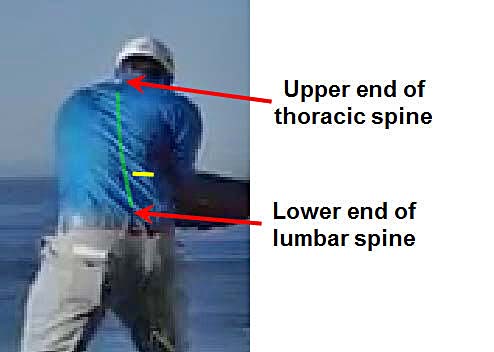
Note that there is white mark on his shirt just below the center of the back of his shirt collar, which indicates the likely position of the upper end of his thoracic spine. The lower end of his lumbar spine is located just above his natal cleft ("butt crack"), which is a point midway between the two belt loops on the central-back portion of his trousers. I have drawn a curved green line to delineate the likely positional alignment of his thoracic-lumbar spine, and a horizontal yellow line to delineate the top of his lumbar spine. Note that he only has a minimal amount of right lateral bend at this time point of his downswing. Also, note that he doesn't increase the natural degree of lordosis of his lumbar spine (when measured in the sagittal plane) between P4 and P5.5.
In other words, there is no evidence that most professional golfers acquire a significant degree (>30 degrees) of right lateral bend during the early downswing, and I think that a small degree (5-15 degrees) of right lateral bend of the thoracic spine cannot cause enough side-compression of the interfacet joints of the thoracic vertebra on the concave/compressed side of the right lateral bend area to produce an "interlocking gears" phenomenon in that side-compressed area.
Consider another golfer-example that clearly demonstrates that the compressed/concave area of the right lateral bend is located at the level of the lower thoracic spine, and not at the level of the lumbar spine.
Jamie Sadlowski swing video - https://www.youtube.com/watch?v=5gekd_JMFT4
Here are capture images from the swing video.
Jamie Sadlowski's early-mid downswing - capture images from his swing video
Image 1 shows Jamie Sadlowski at the P4.5 position and image 2 shows him at the P5 position - one cannot clearly discern the location of his thoracic spine in those two images because it is obscured by his retracted right scapula and his bulging right peri-scapular muscles.Image 3 shows Jamie Sadlowski at the P5.5 position and the likely location of his spine is now more clearly discernible. Note that he has a small degree of right lateral bend of his thoracic spine, but it doesn't involve his lumbar spine (red line area below the horizontal blue line).
Here is close-up image of Jamie Sadlowski at the P5.5 position.
Jamie Sadlowski at the P5.5 position - capture image from his swing video
The yellow line delineates the likely position of Jamie Sadlowski's thoracic-lumbar spine, and the green line represents the compressed/concave side of the right laterally bent spine. Note that the green zone involves the lower thoracic spine, and not the lumbar spine. This "fact" is important because the interfacet joints of the thoracic vertebra are incapable of interlocking (like cogged gears).Here is an artist-rendered image of a thoracic vertebra.
Artist-rendered image of a thoracic vertebra - copied from reference number [5]
The interfacet joint of a thoracic vertebra involves the articulation of the superior articular facet of one thoracic vertebra with the inferior articular facet of the neighbouring thoracic vertebra (located just above). Note that the articular surface of the superior and inferior articular facets are flat and therefore incapable of interlocking. They align like shingles on a roof, and they allow for a sliding motion of the superior articular facet relative to the inferior articular facet. Right lateral bend of the thoracic spine occurs if there is more sliding motion of the inter-articular facet joints on the right side of the involved thoracic vertebra (relative to the left side). However, the thoracic interfacet joints cannot interlock (like interlocking cogged gears) because the articular facet joints are flat.Consider this instructional video that Kelvin Miyahira produced on the topic of the "spine engine" (and which represents his personal interpretation of "how the spine works").
https://www.youtube.com/watch?v=Vtfy6Km3kvY
I think that Kelvin Miyahira makes two major errors in his video presentation of how the "spine engine" works.
At the 21-second time point of the video, he points at the lumbar spine and he asserts that the lumbar spine interfacet joints are not yet connected.
Here is a capture image of Kelvin Miyahira pointing at the lumbar spine.
Capture image from Kelvin Miyahira's video on how the "spine engine" works
Note that Kelvin Miyahira is pointing at the lumbar spine and he claims that the lumbar interfacet joints are not yet connected (engaged). However, the lumbar spine is in a natural state of lumbar lordosis in that image and under those conditions the lumbar interfacet joints are fully connected (engaged). It is only possible to partially disengage the lumbar interfacet joints if one hyperflexes the lumbar spine, but those lumbar interfacet joints are sufficiently well connected (engaged) when the lumbar spine is in its natural state of lumbar lordosis.Here is an artist-rendered image of the lumbar vertebra.
Artist-rendered image of the lumbar spine - from reference number [5]
Note that the lumbar interfacet joint surfaces are vertically aligned, which allows for unimpeded motion of the lumbar vertebra in the sagittal plane of lumbar flexion-extension. However, the cup-shaped interfacet joints have prominent bony processes on the medial side of the inferior articular process and the lateral side of the superior articular process (mamillary process) that prevents/resists any side-to-side motion when the interfacet joints are engaged. Note that these interfacet joints are fully engaged when the spine is in its natural state of lumbar lordosis. These joints can only become significantly disengaged/disconnected if the lumbar spine is driven into a state of marked hyperflexion, and that biomechanical phenomenon never happens in a professional golfer during his backswing-downswing action.Starting at the 21-second time point of his instructional video, Kelvin Miyahira attempts to demonstrate how the "spine engine" works and he claims to be adding right lateral bend that he then asserts causes engagement of disconnected lumbar interfacet joints. However, look at what he is actually doing in that video presentation. He is actually pulling the upper spine backwards and driving the lumbar spine into a state of hyperlordosis, and he is not bending the mid-upper spine sideways into a condition of right lateral bend. If a golfer executes a right lateral bend action (involving the thoracic spine) in his early-mid downswing, then it will not necessarily cause the lumbar spine to become more lordotic, and even if the lumbar spine became more lordotic between P4 and P5, it would not cause the lumbar interfacet joints to become more engaged (like interlocking gears)! The "real life" reality is that the lumbar interfacet joints are always engaged (connected) in a golfer at address, and also during the entire backswing and entire downswing, because the lumbar spine is usually in its natural state of lumbar lorsdosis during the backswing-downswing time period - and under those conditions the "interlocking gears" phenomenon involving the lumbar spine can be deemed to always be operant even if the golfer has no right lateral bend. A golfer's lumbar spine doesn't become more hyperlordotic during the early downswing and the lumbar interfacet joints don't become more engaged/connected (more interlocked). I believe that most professional golfers' lumbar spine interfacet joints are well engaged (connected) during the entire backswing and entire downswing, and that accounts for the "fact" that the lumbar spine and pelvis always rotate to the same degree during a golfer's pivot action - even if a golfer acquires a variable degree of torso-pelvic separation (static and/or dynamic X-factor) at variable time points during either the backswing or downswing. I have never seen a golfer who has his lumbar spine rotated significantly more than his pelvis at any time point during either the backswing or downswing.
I believe that the "spine engine" theory as presented by Kelvin Miyahira has no biomechanical validity, and there is no reason to believe that the rotary pelvic motion that happens in the early downswing between P4 and P5 is causally due to right lateral bend of the thoracic spine that i) secondarily induces an interlocking gears phenomenon of either the thoracic or lumbar spine vertebrae that ii) then secondarily causes pelvic rotation.
Topic number 2: Which muscles cause pelvic rotation in the early downswing?
Many golf instructors use Ben Hogan as their role model when it comes to the topic of how best to perform the downswing using an active pivot action. Ben Hogan described how best to perform the downswing's pivot action in his golf instructional book [6] and he asserted that the downswing's pivot action should start with a rotary pelvic motion. Ben Hogan used this artist-drawn image to demonstrate how one should start the downswing.
Ben Hogan simulating his early downswing's pelvic motion - from reference number [6]
Note that Ben Hogan uses an imaginary elastic band attached to the front of his left pelvis (which becomes stretched during the backswing action) to causally induce a counterclockwise rotary movement of his pelvis during his early downswing - by allowing the stretched elastic band to abruptly shorten at the start of the downswing and thereby pull his left pelvis back towards the tush line (and away from the ball-target line) in a counterclockwise rotary manner. Note that there is no linear left-lateral translational motion of his pelvis in a targetwards direction in that image, and Ben Hogan is describing a pure rotary motion of the pelvis where the pelvis remains roughly centralised between the feet during the pelvis' rotary motion.If a golfer performs a rotary pelvic motion during his early downswing between P4 and P5 (in the manner described by Ben Hogan), then the fundamental question becomes "which muscles are used to perform this action?" In other words, how can a golfer best learn how to perform a pelvic rotary motion (in the manner described by Ben Hogan)?
I think that a golfer can best learn how to perform the early downswing's rotary pelvic motion if he better understands the underlying biomechanics and if be better understands which muscles are involved in the active rotation of the pelvis.
If you look carefully at that artist-drawn image of Ben Hogan at his end-backswing position (left-most image), you will note that his pelvis has rotated about 45 degrees clockwise during his backswing action. However, note that his right femur has only rotated clockwise to a very small degree so that his right femur is in a state of internal rotation at his end-backswing position. In other words, his right hip joint is in state of internal rotation at his end-backswing position not because he rotated his right femur internally (relative to his pelvis), but because he rotated his pelvis clockwise more than his right femur, thereby driving his right hip joint into a biomechanical state of internal rotation by his end-backswing position. Note that his left femur is externally rotated at his end-backswing position and that is due to the fact that his pelvis rotated about 45 degrees during his backswing action while his left femur only rotated clockwise to a much smaller degree.
Now consider what happens during his early downswing action. Note that Ben Hogan's right hip joint becomes externally rotated during his early downswing (right most image), and that is due to the fact that his pelvis rotates more counterclockwise than his right femur. What muscle action causes the pelvis to rotate counterclockwise more than his right femur? If you look at that diagram, you could imagine that it is the rotary "pulling back" motion of the left hip joint towards the tush line that causes the entire pelvis to rotate counterclockwise, and that this counterclockwise rotation of the entire pelvis (away from the internally rotated right femur) causes the right hip joint to become externally rotated during the early downswing. In other words, you could imagine that the active muscular forces causing the pelvis to rotate counterclockwise must be located on the left side of the pelvis (eg. pelvic girdle muscles located in the left buttocks area). However, that's only partially true! Although there is definite involvement of pelvic girdle muscles located in the left buttocks area, I actually believe that most of the muscular force causing the pelvis to rotate counterclockwise during the early downswing is most likely generated by the active muscular contraction of pelvic girdle muscles located in the right buttocks area. Before I describe the underlying biomechanics in greater detail, consider how a baseball pitcher rotates his pelvis at the start of his pitching action.
Tim Lincecum's pitching action.
You-tube swing video - https://www.youtube.com/watch?v=UsIdxPfYT2E
Here are capture images from the video.
Tim Lincecum's pitching action - capture images from his video
In image 1, Tim Lincecum has his pelvis and upper torso square to the ball-target line (line between the pitcher and the batter).Image 2 shows how he loads his body in preparation for a right-handed throw action. Note that he turns his pelvis and upper torso clockwise, and he adducts his left thigh so that his left leg/foot crosses over to beyond the right side of his body. Note that he rotates his pelvis clockwise much more than his right femur, and that means that his right hip joint becomes internally rotated. Note that he is bearing all of his body weight on his right leg/foot.
Image 3 - note that he starts his pitching action with a swaying (linear translation) motion of his pelvis towards the target (batter) and he simultaneously lowers his pelvis so that his right thigh becomes more angulated relative to the ground. Note that he has not yet rotated his pelvis or upper torso counterclockwise.
Image 4 shows how he rotates his pelvis counterclockwise while simultaneously swinging his unweighted (airborne) left left leg in a targetwards direction. Note that he has not yet started to rotate his upper torso counterclockwise. Note that his pelvis rotates counterclockwise much more than his right femur, and his right hip joint becomes externally rotated (blue arrow) due to the counterclockwise rotation of his pelvis away from his right femur (which is still bearing all of his body's weight because he hasn't yet planted his left foot). Note that his left hip joint becomes externally rotated (red arrow) during the same time period because his left femur is rotating counterclockise much more than his pelvis. Which muscles cause the counterclockwise rotation of his pelvis?
There are 6 lateral pelvic rotator muscles that produce pelvic rotation - obturator externus, obturator internus, piriformis, gluteus minimus, superior and inferior gemullus, and quadratus femoris.
Here is a diagram showing those 6 lateral pelvic rotator muscles. These muscles lie deep within the buttocks and they are situated deep below the gluteus major muscle, which forms the bulk of the muscle mass in the buttocks area.
Lateral pelvic rotator muscles
Here is link to an online textbook describing the action of those lateral pelvic rotator muscles - http://www.columbia.edu/itc/hs/misc/kinesiology/chapter7.pdf - see page 115.When these muscles contract they cause the ipsilateral femur to rotate externally (relative to the pelvis). However, that only happens if there is no significant impedance to rotation that will prevent it from easily rotating externally. So, for example, in that Tim Lincecum pitching example, contraction of the 6 lateral pelvic rotator muscles on the left side will cause the left femur (which is unweighted because the left leg is ungrounded and free-floating in space) to externally rotate (in the direction of the red arrow). If the left leg rotates externally with a great deal of force, it can cause the left pelvis to also passively/secondarily rotate counterclockwise. However, it is actually the active muscular contraction of the lateral pelvic rotator muscles in the right buttocks area that primarily causes the pelvis to actively rotate counterclockwise - because if the right femur is "fixed" in space, then contraction of the right lateral pelvic rotator muscles will cause the pelvis to rotate away from the "fixed" (immobile) right femur. Tim Lincecum has all of his body weight on his right leg/foot during the early phase of his pitching action and he is generating a considerable amount of weight-pressure down into the ground below his right foot. In that biomechanical scenario, the right leg can be deemed to be relatively immobile, and relatively "fixed" in space (from a rotary perspective), and contraction of the lateral pelvic rotator muscles in the right buttocks area will cause the pelvis to rotate away from the right femur (see blue arrow) thereby causing the right hip joint to change from a biomechanical condition of internal rotation to a biomechanical condition of external rotation.
Try a simple experiment. Get into a baseball pitching position - like Tim Lincecum in image 2. Then only contract the lateral pelvic rotator muscles in your left buttocks while keeping the right lateral pelvic rotator muscles quiescent. You will note that it causes your left femur to externally rotate, and your pelvis will then secondarily/passively rotate counterclockwise. Then repeat the experiment by actively contracting the lateral pelvic rotator muscles in your right buttocks, and you will note that the pelvis rotates counterclockwise with a greater degree of counterclockwise rotary force. Then repeat the experiment by contracting both the left and right lateral pelvic rotator muscles simultaneously, and you will note that you can then efficiently rotate your pelvis counterclockwise with the maximum degree of rotary force.
What is the relevance of this simple experiment to the rotary pelvic motion that happens at the start of a golfer's early downswing? I think that it has a great deal of relevance because it can make a golfer realise that he can most efficiently induce counterclockwise pelvic rotation at the start of the downswing i) if he generates a lot of weight-pressure down the right leg into the ground under the right foot at the start of the early downswing (thereby "fixing" his right femur in space) while ii) simultaneously contracting the lateral pelvic rotator muscles in his right buttocks area. In other words, if a golfer performs the pelvic rotation move as described by Ben Hogan (in that Ben Hogan diagram), it may "feel" like the pelvis is rotating counterclockwise due to an active contraction of the lateral pelvic rotator muscles in the left buttocks area, but it is actually primarily due to an active contraction of the lateral pelvic rotator muscles in the right buttocks area - presuming that the golfer is generating a lot of weight-pressure down the right leg into the ground under the right foot during the early downswing, thereby temporarily "fixing" (= temporarily immobilising from a rotary perspective) the right leg in space. A golfer may not consciously sense the active contraction of the lateral pelvic rotator muscles in the right buttocks area when performing Ben Hogan's "left hip-clearing action" because it "may feel" like all of the rotary pelvic motion is happening on the left side (when the left hip joint is pulled back towards the tush line due to the counterclockwise rotation of the pelvis). However, this biomechanical phenomenon (involving the right lateral pelvic rotator muscles) is likely happening if a skilled golfer (who is weight-pressure loading his right leg/foot) performs his rotary pelvic motion in a maximally efficient manner.
Now, if an efficient rotary pelvic motion at the start of the early downswing requires contraction of the lateral pelvic rotator muscles in the right buttocks area (and not only the left buttocks area), while the golfer is simultaneously weight-pressure loading the right leg/foot, what is the best biomechanical method of achieving that goal?
To answer that question, a golfer needs to understand that professional golfers generally use three different techniques of performing a pelvic motion during the backswing - which I will arbitrarily label i) center-loading, ii) right-loading and iii) left-loading.
Presume that a golfer has his pelvis centralised between his feet at address. If a golfer then performs a clockwise rotary motion of his pelvis during his backswing, while simultaneously keeping the pelvis centralised between his feet, then that represents the pelvic motion scenario of center-loading. If a golfer sways his pelvis rightwards during his execution of the backswing's rotary pelvic motion so that his pelvis is located closer to the right foot (versus the left foot) at the end-backswing position, then that represents the pelvic motion scenario of right-loading. If a golfer sways his pelvis leftwards during the execution of his later backswing action, so that the pelvis is located closer to his left foot at the end-backswing position, then that represents the pelvic motion scenario of left-loading (which is frequently seen in S&T golfers and VJ Trolio's idiosyncratic pelvic motion).
VJ Trolio is a big proponent of left-loading and he wrote a book devoted to that topic [7]. In that book, VJ Trolio claimed that Ben Hogan used a left-loading pelvic motion technique during his backswing action, but the evidence that he presents to support that "belief" is very weak. He only used a single set of capture images from Ben Hogan's later career (after he fractured his pelvis in an automobile accident) and he doesn't include evidence from Ben Hogan's early-mid career (when he didn't manifest a left-loading pelvic motion technique). More importantly, what biomechanical justification does VJ Trolio provide in his book to support his "belief" in the value of a left-loading pelvic motion technique?
In his book [7], VJ Trolio provides a number of arguments, and I find all of them very unconvincing. His first argument is based on the belief that a centered pelvis, and/or adding left-lateral linear translational motion to a rotating pelvis, will produce flaws in swing performance.
VJ Trolio states on page 27 of his book-: "If the average golfer starts to turn his hips with his weight centered, he completely opens up the left side of the golf course because his center of gravity is behind the ball and his left shoulder may or may not get ahead of the ball. The tendency for an average player is to come over the top and pull the ball left; a better player will hit a hook". I think that his argument has zero merit, and many professional golfers use a center-loading technique without being predisposed to a hooking problem. Sam Snead is the prototypical golfer who used a center-loading pelvic motion technique, and Jamie Sadlowski also uses the same center-loading pelvic motion technique.
Here is a series of capture images showing Jamie Sadlowski's center-loading technique of performing the pelvic motion during both his backswing and downswing.
Jamie Sadlowski swing video - http://www.youtube.com/watch?v=ep-qidwgCII
Capture images from the swing video.
Jamie Sadlowski's centered pelvic rotary motion - capture images from his swing video
Image 1 demonstrates that Jamie Sadlowski's pelvis is roughly centered between his feet at address.Image 2 shows that Jamie Sadlowski's pelvis is still roughly centered between his feet at his end-backswing position, which demonstrates that he uses the center-loading pelvic motion technique during his backswing action. Note that Jamie Sadlowski maintains some flex in his right knee during his backswing action and he also maintains roughly the same degree of right thigh slant-angulation, and that keeps his pelvis relatively centered between his feet.
Images 3, 4 and 5 demonstrate that Jamie Sadlowski's pelvis remains centered between his feet during his downswing action, and his COG and left shoulder remain well behind the ball during that downswing time period. However, that doesn't predispose him to an OTT move or a hooking problem. I think that it is a fallacy to believe that a "pure" pelvic rotational motion, where the pelvis remains centralised between the feet during both the backswing and downswing, will predispose to a hooking problem - if the golfer avoids spinning the upper torso in a too-horizonal manner. Note that Jamie Sadlowski's shoulders do not rotate too horizontally during his downswing action, and his right shoulder moves appropriately downplane (rather than roundhousing) because i) his pelvis leads his upper torso from a rotational perspective and ii) because he acquires the desirable combination of secondary axis tilt and right lateral bend during his mi-downswing that makes it biomechanically easy from him to move his right shoulder downplane.
In his book [7], VJ Trolio then continues to argue that for a golfer to avoid spinning the upper torso (shoulders) in a too-horizontal manner, that the golfer (with a centered pelvis) will then have to use a left-lateral pelvic slide motion during his downswing action. So, VJ Trolio continued his argument as follows in the same paragraph of his book-: "To counteract this tendency and to get the weight over the left foot earlier in the swing, better players will slide the hips forward at the beginning of the downswing before rotating them. However, it is difficult to slide and then turn the hips repeatedly and accurately at the beginning of the downswing unless you have the coordination of touring pro, and even then this will occasionally fail. It requires tremendous coordination in order to consistently move the center of mass forward when the hips are turning, so players stop turning their hips, and they tend to hold the clubface open to prevent the pull-hook". Again, I think that his argument has zero merit. First of all, I think that it is relatively easy to time the left-linear translational motion of the pelvis during the early downswing if the pelvis only moves a few inches left-laterally, and I also think that it doesn't mean that a golfer is necessarily moving the body's COG forward (targetwards) during that time period. A golfer can easily slide the pelvis forward and appropriately weight-load his left foot during his downswing action without moving his mid-upper torso's COG forward - by ensuring that he acquires secondary axis tilt (+/- right lateral bend) during his downswing action while keeping his head stationary.
Consider a professional golfer - Gary Woodland - who uses a right-loading pelvic motion technique during his backswing action, and who therefore has a small degree of targetward sliding of his pelvis during his downswing action.
Gary Woodland's pelvic motion during the backswing and early downswing - capture images from a swing video
Image 1 shows Gary Woodland at address. I have drawn red lines along the outer border of his left and right upper thighs (which delineates the outer border of his pelvis). Note that his pelvis is centered between his feet at address.Image 2 shows Gary Woodland at the P3 position - note that he is swaying his pelvis right-laterally to a small degree while he rotates his pelvis clockwise.
Image 3 shows Gary Woodland at the end-backswing position - note that his pelvis has shifted rightwards and it is closer to his right foot, which means that he is using a right-loading pelvic motion technique.
Image 4 shows Gary Woodland at the P5 position (end of the early downswing) - note that his pelvis is again centered between his feet and that his pelvis is now square to the ball-target line, which means that he has shifted his pelvis left-laterally while he was simultaneously rotating his pelvis counterclockwise. The amount of left-lateral linear translational motion of the pelvis that is happening between P4 and P5 is only a few inches, and I think that it is very easy to time. Many professional golfers choose to use a right-loading pelvic motion technique and they perform the requisite pelvic motion with considerable swing-to-swing consistency. I think that it is a fallacy to believe that the right-loading pelvic motion technique is suboptimal if the degree of left-lateral pelvic slide is small (only a few inches). The great advantage of using a right-loading pelvic motion technique during the backswing action is that it allows a golfer to optimally weight-pressure load the right leg at the P4 position, and it also helps him to maintain that weight-pressure loading during the P4-4.5 transitional downswing time period so that contraction of the right lateral pelvic rotator muscles can very efficiently induce a counterclockwise pelvic rotation away from the weight-pressure loaded right leg. Note how Gary Woodland's right hip joint changes from being internally rotated at P4 (image 3) to being externally rotated at P5 (image 4). Also, note that he keeps his stationary head and mid-upper torso's COG well behind the ball during his early downswing action - even though his pelvis has slid a few inches left-laterally. By keeping his head stationary, while allowing his pelvis and lower lumbar spine to move targetwards by a few inches, he automatically/naturally acquires greater degree of secondary axis tilt. That allows him (when biomechanically combined with a finite degree of right lateral bend) to more easily move his right shoulder downplane (and avoid roundhousing).
I believe that a right-loading (or center-loading) pelvic motion technique is used by the majority of professional golfers with great success - despite VJ Trolio's personal bias against those pelvic motion techniques.
VJ Trolio produces a final argument in another section of his book in order to justify his "belief" in the value of a left-loading pelvic motion technique.
On page 53 of his book, VJ Trolio uses the following diagram.
VJ Trolio's conception of the pivot axis - from reference number [7]
Figure 21 shows a vertical pivot axis (C-C1) which VJ Trolio wrongly claims will be used by a golfer who uses a center-loading pelvic motion technique. He wrongly claims that a golfer (who uses a center-loading pelvic motion technique during the backswing) will rotate around that vertical C-C1 axis during his downswing action [or around another vertical axis (X-X1) if he shifts his pelvis left-laterally at the start of his downswing]. However, that claim is obviously incorrect because a center-loading golfer can easily acquire increasing secondary axis tilt (+/- right lateral bend) during the downswing that causes the pivot axis going down the center of the mid-upper torso to be right-slanted, and not vertical - see the Jamie Sadlowski images.Figure 22 represents VJ Trolio's mental conception of the pivot axis of a golfer who uses VJ Trolio's left-loading pelvic motion technique. Note that the C-C1 pivot axis is slanted and it passes down the entire length of the spine (and down through the center of both the lower and upper torso) and down through the longitudinal axis of the left lower leg. VJ Trolio implies that if a golfer pivot-rotates around this right-slanted pivot axis, that it will produce a more "pure" rotary-pivot motion that will be theoretically free of wobble or any lateral pelvic slide motion.
There are a number of problems with VJ Trolio's over-simplistic conception of a "pure" rotation of the entire torso around that slanted axis C-C1. First of all, the lower torso (pelvis) and upper torso are not necessarily rotating around the same axis in a "real life" golf downswing. Secondly, the pelvis can only rotate around that slanted C-C1 axis in a "pure" rotary manner if the golfer can avoid any left-lateral sliding during that "pure" pelvic rotary motion. However, I believe that a left-loading golfer cannot biomechanically execute a "pure" rotary motion of the pelvis in the early downswing because a left-loading pelvic posture (during the P4-P4.5 time period) makes it very difficult to biomechanically use either the right or left lateral pelvic rotator muscles in an efficient manner. Consider my biomechanical reasoning.
According to VJ Trolio, a left-loading golfer should have 80% of his weight-pressure over the left leg/foot at the end-backswing position, which means that he can only have 20% of his weight-pressure going down the right leg into the ground under his right foot at the start of the downswing. Under those conditions of minimal weight-pressure loading of the right leg, it would be impossible (or very difficult) for the golfer to use the lateral pelvic rotator muscles in the right buttocks to cause the pelvis to rotate counterclockwise away from a "fixed" (immobile) right leg - as previously described for a right-loading (or center-loading) golfer, who can much more easily weight-pressure load the right leg during the P4-4.5 time period and therefore keep it "fixed" in space. If a golfer cannot immobilise the right leg and keep it "fixed" in space, then he cannot efficiently use an activation of the right lateral pelvic rotator muscles to induce pelvic rotation away from the right leg. Therefore, the golfer would be totally dependent on using only the lateral pelvic rotator muscles in his left buttocks to rotate the pelvis and left thigh counterclockwise. However, if the degree of weight-pressure loading of the left leg/foot is ~80% at the start of the downswing, thereby "fixing" the left leg in space (from a rotational perspective), it will be very difficult to rotate the pelvis or left thigh counterclockwise because the pelvis will tend to rotate away from an immobilised ("fixed") leg - and therefore the pelvis would rotate away from (rather than towards) the target - if the lateral pelvic rotator muscles in the left buttocks are activated. In other words, a left-loading pelvic motion technique (where the lead leg/foot is weight-pressure loaded) markedly hampers a golfer's ability to effectively use either the left-or-right lateral pelvic rotator muscles to rotate the pelvis (or left thigh) counterclockwise at the start of the downswing. If you are skeptical of my claim, try a simple experiment. Mimic VJ Trolio's left-loading pelvic motion technique (where 80% of your weight-pressure is directly over the lead leg/foot at the P4 position) and then try and rotate your pelvis counterclockwise using only your right and left lateral pelvic rotator muscles. You will probably find it very difficult, or near-impossible!
Most importantly, although VJ Trolio claims to be "purely" rotating around his left leg during his downswing action, video evidence demonstrates that he is actually using an assertive pelvic slide motion - just like a S&T golfer.
Consider VJ Trolio's personal video presentation on the difference between a center-loading (or right-loading) pelvic motion technique versus the S&T's pelvic motion technique versus his personal left-loading pelvic motion technique.
https://www.youtube.com/watch?v=cov8R5Axt4k
Here are capture images from that video presentation.
Capture images from VJ Trolio's video
Images 1, 2 and 3 are capture images from his personal demonstration of a S&T swing, while images 4 and 5 represent capture images from his personal demonstration of his left-loading swing action.Image 1 shows VJ Trolio at address. He has drawn yellow lines alongside the outer borders of his thighs, which are also reflective of the outer border of his pelvis. The two lower red dots roughly represents the two swing centers - lower and upper swing centers - which are vertically-stacked above each other.
Image 2 shows VJ Trolio demonstrating a S&T style backswing action where he keeps the upper swing center and head (top red dot) stacked vertically above the lower swing center - by using a "left-lateral extension of the upper thoracic spine" manuever (arch-extension maneuver) during his backswing action. Note that he is also using a left-loading pelvic motion technique during his backswing action where 70-80% of his weight-pressure loading is supposedly over the left leg at the P4 position.
Image 3 shows how he has to use an assertive left-pelvic slide motion (what the S&T golfers call a "tuck the butt-under the spine" pelvic slide maneuver) in order to perform the downswing's pelvic motion. Note how this assertive left-lateral pelvic slide motion causes the outer border of his left pelvis to move outside the outer boundary of his left foot.
Image 4 shows VJ Trolio at his end-backswing position when he uses his left-loading pelvic motion technique during the latter half of his backswing action. His pelvic motion/position is identical to that seen in image 2 - but he maintains a rightwards-tilted spine (because he doesn't use the S&T's "left-lateral extension of the upper thoracic spine" maneuver).
Image 5 shows VJ Trolio at impact. Although VJ Trolio implies in his video demonstration that he is performing a "pure" rotary pelvic motion around a pivot axis that slants from his head down to his left foot (like the C-C1 pivot axis drawn in figure 22 above), you can see how much his pelvis is sliding left-laterally during his downswing action by noting that the outer border of his left pelvis is well outside the outer border of his left heel in image 5. In fact, there is no visual difference in the degree of left-lateral pelvic slide motion seen in his S&T downswing demonstration and this personal "left-loading" downswing motion - and they both represent a "tuck the butt-under the spine" type of pelvic slide motion. I believe that VJ Trolio is forced to use this assertive left-lateral pelvic slide motion to induce some pelvic rotation because a left-loading pelvic motion technique makes it very difficult to efficiently only use the lateral pelvic rotator muscles to induce a "pure" pelvic rotation between P4 and P5 (as seen in Jamie Sadlowski's downswing action).
I also think that VJ Trolio is wrong to imply that Ben Hogan used this "tuck the butt-under the spine" type of left-lateral pelvic slide motion, where the outer border of his left pelvis gets oustide the outer border of his left foot during the late downswing action. I have personally never seen an image of Ben Hogan where the outer border of his left pelvis is well ouside the outer border of his left foot at impact (or near-impact).
Here is a capture image of Ben Hogan near-impact.
Ben Hogan near-impact - from reference number [8]
Note that if you draw a vertical line down from the outer border of his left pelvis, that the vertical line will hit the ground at a point that is well inside his left foot. Note that his pelvis is near-centered between his feet near-impact - while VJ Trolio's pelvis is shifted well to the left at impact. I think that Ben Hogan performed a much more centered-rotary pelvic motion during his downswing action - compared to VJ Trolio's video demonstration of his personal left-loading swing technique!
Here are series of capture images from a pre-accident 1953 film (when Ben Hogan was at his prime).
Ben Hogan's downswing action - capture images from a swing video made from a 1953 film
Image 1 shows that Ben Hogan's pelvis was centered between his feet at the end-backswing position, and he was not using a left-loading pelvic motion technique during his backswing action. A center-loading pelvic motion technique during the backswing action (where the golfer "turns into" the right hip joint while avoiding any rightwards pelvic slide/sway motion) enables a golfer to weight-pressure load the right leg at the start of the downswing, and thereby use the lateral pelvic totator muscles in the right buttocks to cause the pelvis to rotate counterclockwise away from the "fixed" right leg ("fixed" in a rotary sense and not "fixed" in terms of the degree of slanting of the right femur towards the target) during the P4-P5 time period. The degree of slanting of the right thigh towards the target will obviously be increased if there is a lot of left-lateral pelvic slide motion happening during the downswing.Images 2-7 demonstrate that Ben Hogan rotated his pelvis counterclockwise while simultaneously sliding his pelvis left-laterally, and he had no difficulty performing a dual slide-rotary pelvic motion during his downswing action. Note that the outer border of his left pelvis is still well inside the outer border of his left foot at impact, and he doesn't look like VJ Trolio in image 5 of his demonstration of a left-loading pelvic motion swing technqiue (where the outer border of his left pelvis is well outside the outer border of his left foot at impact).
Consider the rotary pelvic motion of two very famous professional golfers - Arnold Palmer and Jack Nicklaus.
Birds-eye swing video - https://www.youtube.com/watch?v=StKkT9sTTtQ
Here are capture images from that video.
Arnold Palmer's pelvic motion - capture images from the swing video
Image 1 shows Arnold Palmer at address. I have drawn red lines alongside the outer border of his pelvis as reference points. Note that Arnold Palmer's pelvis is slightly closer to his left foot at address.Image 2 shows Arnold Palmer at his end-backswing position. Note that he had a much greater than 45 degrees pelvic rotation during his backswing action, but it is nearly a "pure" pelvic rotation with no significant amount of pelvic swaying motion in either direction. The pelvis apppears to be slightly closer to his left foot, but that is simply due to the fact that the right femoral head/hip acetabulum has moved targetwards during his clockwise pelvic rotation. I would classify him as a center-loading pelvic motion golfer. He has "turned-into" his right hip joint using a vertical-centralised backswing action and he is in a perfect end-backswing position to allow him to have most of his weight-pressure directed down into his right leg/foot as he transitions into the downswing, and he is perfectly positioned to activate the lateral pelvic rotator muscles in his right buttocks.
Image 3 shows Arnold Palmer at the end of his early downswing (P5 position). Note that he has rotated his pelvis counterclockwise with very little pelvic slide motion in a targetwards direction.
Image 4 shows Arnold Palmer at impact with an open pelvis. I have drawn a green arrow vertically down from the outer border of his left pelvis, and it is directed at a point on the ground that is inside the outer border of his left foot.
Note that he didn't use an assertive left-lateral pelvic slide motion during his downswing's pelvic motion - as seen in S&T golfers. Note that the outer border of his left pelvis is no closer to the target - compared to its position at address.
Jack Nicklaus' pelvic motion - capture images from the swing video
Image 1 shows Jack Nicklaus at address. I have drawn red lines alongside the outer border of his pelvis as reference points. Note that his pelvis is roughly centralised between his feet at address.Image 2 shows Jack Nicklaus at his end-backswing position. Note that he had a greater than 45 degrees pelvic rotation during his backswing action, but it is nearly a "pure" pelvic rotation with no significant amount of pelvic swaying motion in either direction. I would classify him as a center-loading pelvic motion golfer, although his pelvis is slightly closer to his left foot, which is secondary to the fact that he has pushed his right femoral head/hip acetabulum targetwards to a small degree. He has "turned-into" his right hip joint using a rightwards-centralised backswing action and he is in a perfect end-backswing position to allow him to have most of his weight-pressure directed down into his right leg/foot as he transitions into the downswing, and he is perfectly positioned to activate the lateral pelvic rotator muscles in his right buttocks.
Image 3 shows Jack Nicklaus at the end of his early downswing (P5 position). Note that he has rotated his pelvis counterclockwise with very little pelvic slide motion towards the target.
Image 4 shows Jack Nicklaus at impact with an open pelvis. I have drawn a green arrow vertically down from the outer border of his left pelvis, and it is directed at a point on the ground that is inside the outer border of his left foot.
Note that he didn't use an assertive left-lateral pelvic slide motion during his downswing's pelvic motion - as seen in S&T golfers.
To summarize my personal opinion regarding pelvic motion during the downswing action, I believe that pelvic rotation during the early downswing is primarily due to activation of the lateral pelvic rotator muscles (especially the right lateral pelvic rotator muscles, which will cause the pelvis to rotate counterclockwise away from the right leg if the right leg/foot is significantly weight-pressure loaded during the P4-4.5 time period) and I believe that it is perfectly acceptable to manifest a small degree of left-lateral pelvic slide motion during the downswing as long as the pelvis remains between the feet during the entire downswing action. I also believe that a *center-loading, or right-loading, pelvic motion technique during the backswing is the optimum way of getting to an end-backswing position where one can efficiently weight-pressure load the right leg/foot during the P4-4.5 time period.
(* although I personally favor a center-loading, or right-loading, pelvic motion technique because it allows for the most efficient use of the lateral pelvic rotator muscles, I also think that it is perfectly acceptable for a golfer to use a left-loading pelvic motion technique if he can perform it as well as VJ Trolio or a skilled S&T golfer)
Topic number 3: When should the angular velocity of the downswing's pelvic rotary motion reach its maximum value and how open should the pelvis be at impact?
I am frequently amazed to discover that many golfers believe that a skilled golfer could hit the ball further if the golfer continued to rotate the pelvis very actively, and very fast, during the later downswing and also maintain that very fast pelvic rotation all the way into impact. Jeff Martin (an avid swing disciple of Kelvin Miyahira) previously harbored this "belief" and he wrongheadedly attempted to prove his theory using Jamie Sadlowski as an example [9]. Jeff Martin correctly opposed the wrongheaded "belief" (expressed by Brian Manzella, a New Orleans-based golf instructor) that a golfer needs to deliberately decelerate the pelvis in the mid-late downswing in order to "snap the kinetic chain". The concept of "snapping the kinetic chain" is a ridiculously foolish kinetic link theory that postulates that a golfer must deliberately stall his rotary pelvic motion during the later downswing in order to transfer energy to the left arm and/or club (like a lion tamer snapping his circus whip). I believe that a skilled golfer must never deliberately stall his rotary pelvic motion during the downswing, but I also believe that it is biomechanically natural/automatic for the rotary pelvic motion to stall during the later downswing due to natural biomechanical phenomena (which I will discuss shortly). Jeff Martin stated a post in his forum's thread [9] that an elite golfer will avoid stalling his pelvis during the mid-late downswing and that he would continue to actively rotate the pelvis very fast during the later downswing time period between P6.2+ and impact. He used Jamie Sadlowski as an example of an elite golfer, and he attempted to prove that Jamie Sadlowski manifested a second pelvic firing phenomenon that would prevent any rotary pelvic stalling phenomenon during the mid-late downswing.Jeff Martin used this swing video as the basis for his measurements - https://www.youtube.com/watch?v=Q7H9U56kHcQ
That video represented a short extract derived from this origial you-tube video - https://www.youtube.com/watch?v=bBKi3reRk-Y
Jeff Martin attempted to measure the amount of pelvic rotation that was happening per unit time during the downswing (by taking measurements from sequential 2-D images derived from that video) and he produced this graph.
Jeff Martin's graph of measurements of Jamie Sadlowski's pelvic rotation - sharpened image adapted from Jeff Martin's original graph [9]
The blue graph features his crude angular velocity measurements of Jamie Sadlowski's downswing pelvic rotation, and the green graph represents his "best fit" graph. His angular velocity measurements suggest that Jamie Sadlowski's pelvic angular velocity didn't stall during the later downswing and it implies that he maintained a near-constant speed of pelvic rotation throughout his downswing. In a post in that thread [9] Jeff Martin stated with reference to this graph-: "So, what does this tell us? The first thing that is obvious is Jamie's hip rotational velocity does not peak when the hips are square (the vertical black line) and then rapidly drop off by a third or a half like the TPI/kinetic sequence model: there is, in fact, a second velocity peak (reflecting a second phase of acceleration) and velocity is maintained until the very last frames before impact, when his hips are nearly 60 degrees open and the upper body/arms/club moment of inertia is at its maximum."The bold-highlighted statement implies that there was a second phase of rotary pelvic acceleration, which Jeff Martin referred to as a 2nd pelvic firing phenomenon. Jeff Martin then made the following statement later in his post-: "Second, we know that to maintain this velocity Jamie must be exerting increasing amounts of pelvic torque in the downswing. As the club and arms extend in the downswing, the upper body moment of inertia increases, putting a higher load on the body's torque generators (rotational acceleration = torque divided by moment of inertia; if MOI goes up, torque must also go up or velocity will drop). So, from a biomechanical perspective, he is increasing his applied torque throughout the downswing, reflected in the second period of acceleration. That strongly suggests that his biomechanical intent is to accelerate the hips during the entire downswing."
That bold-highlighted claim by Jeff Martin asserts that Jamie Sadlowski is exerting an increased amount of rotary pelvic torque in the second-phase of his downswing in order to produce a second pelvic rotary acceleration phenomenon - although he never explained how this is biomechanically possible.
With the passage of time, Jeff Martin conceded that his angular velocity measurements of pelvic rotation were wrong and he finally conceded that this next AMM-3D graph of Jamie Sadlowski's pelvic rotation is likely to be more accurately reflective of reality.
Kinematic Sequence - sharpened image derived from the original AMM-3D graph [9]
The red graph plots the angular velocity of Jamie Sadlowski's pelvic rotation. Note that Jamie Sadlowski first starts to rotate his pelvis counterclockwise in his late backswing (before he even reaches the top of his backswing) and that the angular velocity of his counterclockwise pelvic rotation reaches its maximum value in the "mid-downswing-to-early phase of the late downswing" time period, and that his pelvic rotation slows down between ~P6.5 and impact. I am not surprised by this fact, and I think that it applies to virtually all professional golfers who use the lateral pelvic rotator muscles to actively rotate the pelvis during the downswing time period. Consider a number of factors that will affect the speed of pelvic rotation during the downswing.The first major biomechanical factor relates to the efficient use of the lateral pelvic rotator muscles, which are the primary muscles used to rotate the pelvis during the early downswing. I believe that a skilled golfer can optimise his loading of the lateral pelvic rotator muscles by using i) either a center-loading, or right-loading, pelvic motion technique during the backswing and ii) by maximally stretching the right lateral pelvic rotator muscles by ensuring that the right pelvis rotates much more than the right thigh during the backswing thereby driving the right hip joint into a condition of internal rotation (biomechanical phenomenon of "turning into one's right hip joint") and by iii) maximally stretching his left lateral pelvic rotator muscles by allowing his left thigh to become more internally rotated during the later backswing (which naturally happens if one allows the left heel to elevate off the ground - as seen in Arnold Palmer's and Jack Nicklaus' backswing action => see image 2 of Arnold Palmer's swing sequence and image 2 of Jack Nicklaus' swing sequence).
Presuming that a skilled golfer has optimally pre-stretched his lateral pelvic rotator muscles during the backswing, then he needs to maximally activate both his right-and-left lateral pelvic rotator muscles during the early downswing time period - as described in subtopic a above. If these right-and-left lateral pelvic rotator muscles contract with maximum efficiency during the early downswing, then they will likely reach their maximally contracted state in the mid-downswing, or early phase of the late downswing, so one would reasonably expect that pelvic rotational speed would naturally/automatically slow down after that time period. Jeff Martin implied in reference number [9] that a golfer could generate a second-phase of rapid rotary pelvic motion in the later downswing, but he never explained how this is biomechanically possible. Which pelvic rotary muscles did he think could be used to induce a second pelvic firing phenomenon? He never discussed this issue, and I * know of no other pelvic girdle muscles that can causally produce a second pelvic firing phenomenon (other than the left gluteus major muscle which can play a minor secondary role during the P6-to-P7 time period, which I will discuss later).
(* Addendum added in February 2016: I was wrong to assert that there is no other pelvic girdle muscle that can cause a continued counterclockwise rotation of the pelvis during the mid-late downswing because contraction of the left adductor magnus muscle and the right gluteus maximus muscle can contribute to the rotary pelvic motion during the mid-late downswing - see my newer review paper on How to Optimally Rotate the Pelvis During the Downswing for further details)
A second major factor that can also affect the timing of maximum pelvic rotational speed (presuming that a golfer has maximally contracted his lateral pelvic rotator muscles with optimal efficiency) is a biomechanical factor that can produce progressive impedance to continued pelvic rotation during the later downswing - and that biomechanical factor is due to a variable degree of weight-pressure loading of the left leg/foot during the later downswing. I discussed this weight-pressure loading issue in topic number 13 of my "2014 Revisions and Refinements in My Thinking Regarding Golf Swing Mechanics/Biomechanics" review paper. Here is a graph from that review paper.
Weight-pressure loading COP-measurements over the lead foot - from reference number [10]
Kevin Ball discovered in his PhD dissertation's research study that golfers fall into two distinct groups when it comes to weight-pressure loading of the lead leg/foot during the late downswing (especially between P6 and impact) - i) front foot group golfers whose COP-measurement under the front foot increases from ~60% at the P5.2 position to ~80% by impact and reverse group golfers whose COP-measurement under the front foot decreases from ~60% at the P5.2 position to ~50% at impact.I think that Jamie Sadlowski is very representative of a reverse group golfer - where the golfer acquires a lot of secondary axis tilt during the mid-late downswing that moves the overall COP-measurement location backwards (away from the target), and therefore decreases the amount of weight-pressure being exerted on the front foot from ~60% at P5.2 to ~50% at impact. If the amount of weight-pressure being exerted down on the front foot diminishes during the later downswing, then it becomes to easier to continue to rotate the left thigh and pelvis counterclockwise (given the same amount of lateral rotator muscle power generation). Therefore, it is not surprising that a reverse group golfer (like Jamie Sadlowski) will have a more open pelvis at impact - compared to a front-foot golfer who has ~80% of his weight-pressure over his front foot at impact (even if they both theoretically generate the same amount of pelvic rotary power using their lateral pelvic rotator muscles).
Another, more minor, factor that can decrease the impedance to the counterclockwise rotation of the left thigh and pelvis in a reverse group golfer during the later downswing, and that will result in a more open pelvis at impact, is the type of foot action commonly manifested by a reverse group golfer - called a floating front foot action. Consider an example - Bubba Watson.
Here is a composite image showing Bubba Watson at the P8 position (from two different swings).
Bubba Watson at the P8 followthrough position - capture images from swing videos
Note that Bubba Watson (a lefty golfer) has a lot of secondary axis tilt, which is characteristic of a reverse group golfer, and it would not be surprising to discover that his COP-measurement under his lead foot is ~50% at impact. Note that his lead foot is only contacting the ground in the forefoot area and that his lead heel is raised off the ground. Also, note that his lead foot's heel has rotated away from the target and that biomechanical phenomenon represents a floating front foot action.
Here is a swing video showing Bubba Watson's front foot action in the late downswing and through impact - https://www.youtube.com/watch?v=KMqzcz-NA00
Here are capture images from the swing video showing Bubba Watson's foot action.
Bubba Watson's foot action - capture images from his swing video
Image 1 shows Bubba Watson at address. Note that his front foot (right foot) is only minimally turned outwards (targetwards) at address.Image 2 shows Bubba Watson at the P4 end-backswing position. Note how much he raises his front foot's heel and that allows him to adduct and internally rotate his lead thigh by a greater amount, which usefully allows him to maximally preload-stretch the lateral pelvic rotator muscles in his right (lead) pelvis.
Image 3 shows him at the P5 position. He has activated the lateral pelvic rotator muscles in his lead pelvis during his early downswing, and that has caused his lead thigh to externally rotate and abduct, and he has also replanted his lead heel.
Image 4 is at P6.5, and at this time point his pelvis is slightly open to the ball-target line, which causes his rear heel to elevate slightly as his rear knee moves more targetwards. Note that his lead heel is sightly off the ground and he has most of his lead foot's weight-pressure over his lead forefoot. Note that his lead thigh and lead leg are slightly more rotated clockwise (targetwards) relative to image 3.
Image 5 is at impact. Note that there is very little difference in the degree of clockwise rotation of his lead thigh/leg compared to the P6.5 position, and his lead heel has not yet rotated away from the target.
Image 6 is at P7.5. Note that his lead heel has rotated significantly away from the target as he spins his lead forefoot clockwise against the ground and this biomechanical phenomenon represents the floating front foot phenomenon. Note that his lead thigh/leg has rotated significantly more clockwise between impact and P7.5.
I think that it is perfectly acceptable for a golfer to manifest this floating front phenomenon through impact, and I believe that it facilitates the targetwards rotation of the lead leg/thigh through impact. However, it doesn't increase clubhead speed because it is a minor biomechanical phenomenon that is happening mainly after impact. The fact that this floating front phenomenon is mainly seen in reverse group golfers makes sense, because the front foot's heel is less weight-pressure loaded in that group of golfers who only have ~50% of their overall COP-measurement located over their front forefoot at impact. It is less frequently seen in front foot group golfers who have ~80% of their overall COP-measurement located over their front foot at impact - especially if most of their front foot's weight-pressure is located over the lead heel area (rather than the lead forefoot area) at impact, which makes it more likely that the lead forefoot will float-rotate towards the target (rather than the lead heel float-rotating away from the target).
Consider a front-foot group golfer whose lead forefoot rotates targetwards through impact - Gary Woodland.
Gary Woodland's foot action - capture images from a swing video
Image 1 shows Gary Woodland at address. His left foot is flared slightly towards the target.
Image 2 shows Gary Woodland at his end-backswing position. Note that he doesn't rotate his pelvis clockwise very much during his backswing (when compared to Bubba Watson) and he doesn't lift his lead foot's heel (like Bubba Watson) because he doesn't adduct and internally rotate his lead thigh very much. Therefore, he is not likely pre-stretching (loading) the lateral pelvic rotator muscles in his lead buttocks as much as Bubba Watson.
Image 3 shows Gary Woodland at the P5 position. He has squared his pelvis and both feet appear solidly grounded. He probably has 50% of his overall weight-pressure located over his front foot at this time point of his downswing.
Image 4 shows Gary Woodland at impact. Note that he doesn't have much secondary axis tilt (compared to a reverse group golfer like Bubba Watson) and he probably has 80% of his overall COP-measurement over his front foot at impact. Note that he has rotated his pelvis to an open position and he appears to have most of his lead foot's weight-pressure over his lead heel area (and not over his lead forefoot as occurs with Bubba Watson). His rear (right) heel is still grounded, and it isn't elevated off the ground (as happens in Bubba Watson's late downswing action).
Image 5 shows Gary Woodland at the P8 position. Note that his pelvis is more open than it was at impact - even though he is not manifesting a floating front foot phenomenon (like Bubba Watson). In fact, you can see that his left forefoot has rotated slightly targetwards while his left heel remains solidly grounded.
Gary Woodland can drive a ball as far as Bubba Watson - despite i) having less pelvic rotation in his backswing; ii) having less pre-stretching loading of the lateral pelvic rotator muscles in his lead buttocks during his backswing; iii) having a much shorter backswing; iv) having a less open pelvis at impact and v) not manifesting a floating front foot action through/after impact. I suspect that Gary Woodland, who uses a right-loading pelvic motion technique, is mainly using the lateral pelvic rotator muscles in his right buttocks to actively rotate his pelvis counterclockwise during his early-mid downswing and that he is doing it super-efficiently. Note that the outer border of his left pelvis is well inside the outer border of his left foot at impact (image 4) and that demonstrates that his pelvic action is nearly a "pure" rotary motion between P5 and impact, and that a small degree of left-lateral pelvic slide motion only happens between the P4 position and the P5 position.
Although it is not surprising that reverse group golfers are more likely (on average) to have a more open pelvis at impact (compared to front foot golfers), there is no known correlation between a more open pelvis at impact and an ability to generate more clubhead speed at impact.
Consider the downswing's rotary pelvic motion in another front-foot golfer, who is also one of the longest drivers on the PGA tour - Rory McIlroy.
Rory McIlroy's swing video - https://www.youtube.com/watch?v=H4_BRVrUOHU#t=44
Here are capture images from his swing video.
Rory McIlroy's downswing action - capture images from his swing video
Image 1 shows Rory McIlroy at his end-backswing position. Note that he has maintained some flex in his right knee and he is resisting any clockwise rotation of his right thigh during his backswing action. Note that he has "turned into" his right hip joint because his pelvis has rotated clockwise more than his right femur, and that he is also using a center-loading pelvic motion technique during his backswing action. He is presumably weight-pressure loading his right leg/foot to a large degree at his end-backswing position and he is pefectly poised to start his downswing using his right lateral pelvic rotator muscles to rotate his pelvis counterclockwise away from his "fixed" right leg.
Images 2 and 3 shows his early downswing action. He is rotating his pelvis counterclockwise while keeping his right femur relatively "fixed" in space - note that his right femur is not rotating counterclockwise in his early downswing as he rotates his pelvis counterclockwise away from his "fixed" right femur. His right hip joint, which was internally rotated at the P4 position, becomes externally rotated by P5 (image 3) due to the counterclockwise rotation of the pelvis away from his right femur.
Image 4 shows that Rory McIlroy's pelvis is slightly open at the P6 position. Note that he has elevated his right heel and "kicked-in" his right knee and he has significantly less right hip joint flexion (compared to his P5 position) - and all these biomechnaical features suggest that * he is isotonically contracting his right gluteus maximus muscle. Note that his left femur is now more internally rotated and it is very likely that his * left adductor magnus muscle is isotonically active, thereby pulling his left inferior pubic ramus closer to his left thigh, and thereby contributing to the continued counterclockwise rotation of his pelvis between P5 and P6.
( * I have discussed the role of the right gluteus maximus muscle and the left adductor magnus muscle in the continued counterclockwise rotation of the pelvis during the mid-downswing in my How to Optimally Rotate the Pelvis During the Downswing review paper)
Image 5 shows Rory McIlroy at impact. Note that he has far less secondary axis tilt than either Jamie Sadlowski or Bubba Watson, and I would classify him as a front foot group golfer, who likely has 80% of his overall COP-measurement located over his front foot at impact.
Image 6 shows him at the P8 position. Note that he manifests minimal float rotation of his left heel away from the target.
Most importantly, note that Rory McIlroy's pelvis is equally open to the target at P6, P7 and P8, which means that the rotary motion of his pelvis has stalled at P6 and it doesn't continue to rotate counterclockwise between P6 and impact. That doesn't mean that he is deliberately stalling the rotary motion of his pelvis, but it merely reflects the "fact" that his lateral pelvic rotator muscles and right gluteus maximus muscle have probably already contracted to their fully contracted state by ~P6, and he doesn't have enough remaining contractile power in those muscles to rotate the pelvis further counterclockwise against the impedance created by an increasingly weight-pressure loaded left leg between P6 and P7. The "fact" that Rory McIlroy is one of the longest drivers in the PGA tour (despite his small size) demonstrates the "fact" that it is totally unnecesary for him to continue to actively rotate the pelvis counterclockwise between P6 and impact (as originally prescribed by Jeff Martin - "second rotary pelvic firing" phenomenon) in order to maximise his clubhead speed at impact. What makes Rory McIlroy a long driver (by PGA tour standards) is the "fact" that he accelerates his pelvis and upper torso very fast between P4 and P6, and it is not causally related to how open his pelvis becomes by the P6 position.
Consider the following you-tube video presentation on Rory McIlroy's pelvic motion during his downswing action.
https://www.youtube.com/watch?v=CvEzEYl0Re0
As that commentator suggests, Rory McIlroy doesn't have a very high static X factor (very large degree of torso-pelvic separation) by PGA tour standards, but he does have a very fast pelvic rotational speed during his early downswing of ~700 degrees/seconds, which is extremely fast by PGA tour standards. If a golfer can generate a very fast pelvic rotational speed in the early downswing and then secondarily complement that "fact" with a very fast upper torso (shoulder) rotational speed that exceeds the speed of pelvic rotation by the mid-downswing (as seen in Rory McIlroy's downswing), then he can expect to drive the ball a long way (presuming an optimal smash factor secondary to hitting the ball on the sweetspot of the clubface).
Topic number 4: Does straightening of the lead leg in the late downswing, which elevates the lead pelvis, increase clubhead speed?
It is amazing how many golfers, and golf instructors, believe that the straightening action of the left leg in the late downswing, which consequently elevates the left pelvis, can causally increase swing power and clubhead speed. What is equally amazing is the "fact" that they don't bother to explain how elevating the left pelvis in the late downswing, and at impact, can increase clubhead speed.
Straightening of the left leg in the later downswing, and a consequent elevation of the left pelvis, is a very common biomechanical feature in professional golfers.
Robert Baker, in his video presentation on a positive O factor, demonstrates how the left pelvis becomes elevated in the later downswing.
Robert Baker's video presentation - http://www.golf.com/video/o-factor-two-wheels
Here are capture images from the video presentation.
Robert Baker's O factor demonstration using hula hoops - capture images from his swing video
Note how the lower hula hoop around the pelvis becomes tilted upwards on the left side due to the fact that the left pelvis becomes increasingly elevated in the later downswing (as a result of a progressive left leg straightening action), and how this "fact" allows the golfer to acquire more right lateral bend and thereby efficiently direct the right shoulder downplane (along the upper hula hoop path). Acquiring a positive O factor (Robert Baker's original term to describe the fact that the left pelvis becomes elevated in the later downswing) is a very useful biomechanical phenomenon because, in combination with an open pelvis, it allows a golfer to more easily/effectively drive the right shoulder downplane during the later downswing. I would recommend that you watch Robert Baker's video presentation as he demonstrates how Ben Hogan used this very useful technique in his downswing action.What biomechanical factor is responsible for elevation of the left pelvis in the later downswing?
Before I explain the underlying biomechanics, let's first consider two golfer-examples, who demonstrate the "fact" that the left leg becomes straighter during the later downswing action.
Consider Ben Hogan's left leg action in the later downswing.
Ben Hogan's left leg action during his downswing - capture images from a swing video
Image 1 shows Ben Hogan at his end-backswing position. Note that his right pelvis is minimally higher than his left pelvis because his right leg is straighter than his left leg.Images 2 and 3 show his early downswing action where he increases the the degree of flex in his hip joints and both knee joints, which causes his head to drop down by a few inches.
Image 4 shows how his left leg becomes much straighter in his later downswing and note how it causes elevation of his left pelvis through impact (image 5). Note how the acquisition of an elevated left pelvis (positive O factor), in combination with an open pelvis, allows him to more efficiently direct his right shoulder downplane in his later downswing (image 4) and early followthrough (image 5).
Consider another example - Gary Woodland.
Gary Woodland's positive O factor phenomenon during his later downswing - capture images from a back view swing video
Image 1 shows Gary Woodland at address, and his pelvis is more-or-less level.Image 2 shows Gary Woodland at his end-backswing position with a negative O factor due to the fact that his right pelvis is slightly higher than his left pelvis.
Note how his pelvis again becomes level by the end of his early downswing (image 3) and how his left pelvis then subsequently becomes more elevated by impact (image 4) as a result of his left leg straightening action that happens in his later downswing. Note how the acquisition of an elevated left pelvis (positive O factor), in combination with an open pelvis, allows him to more efficiently direct his right shoulder downplane in his later downswing (image 4) and early followthrough (image 5).
I believe that elevation of the left pelvis occurs naturally in the later downswing in a skilled golfer as the left leg straightens due i) to the isotonic contraction of the left knee extensor muscles supplemented by ii) an activation of the gluteus maximus muscle, which extends the left femur at the level of the left hip joint.
Consider a major left knee extensor muscle - the left vastus lateralis muscle - that has been shown in an electromyography study to be very active during the later downswing.
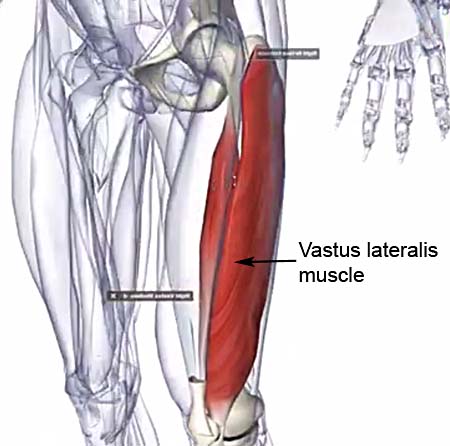
The left vastus lateralis muscle is the biggest muscle in the left thigh's quadriceps group of muscles that are responsible for left knee extension. When that muscle becomes isotonically active it extends the left knee and it also braces the left knee so that it doesn't "buckle-in" at impact. If the left knee extends, it causes the left leg to straighten, which means that the distance between the left femoral head (and therefore the left hip joint) and the left foot must increase. If the left foot is solidly grounded (as it is increasingly weight-pressure loaded during the later downswing), it cannot move further away from the left hip joint, so the left hip joint must move further away from the left foot when the left leg straightens, and that explains why the left side of the pelvis elevates during the later downswing.The left hip joint doesn't only move further away from the ball-target line (in the direction of the tush line) as the left leg straightens, it also moves further away from the target due to the contraction of the left gluteus maximus muscle.
Consider the action of the left gluteus maximus muscle which is described on page 118 of this online textbook - http://www.columbia.edu/itc/hs/misc/kinesiology/chapter7.pdf
Gluteus maximus muscle - image (sharpened) copied from an image on page 118 of the online textbook on biomechanics
Note that the gluteus maximus muscle (which is the major muscle in the buttocks area) has its origin on the posterior 1/4th of the iliac crest and the posterior surface of the sacrum/coccyx and it inserts on the i) oblique ridge that runs along the lateral surface of the greater trochanter and ii) the iliotibial band of fascia lata. Note that contraction of the gluteus maximus muscle causes extension at the level of the hip joint and simultaneously causes external rotation of the femur in the hip joint. One can clearly see that left hip joint extension, combined with a greater degree of external rotation of the left femur, is happening in the later downswing in both Ben Hogan's and Gary Woodland's swing - and that it is causally responsible for the continued counterclockwise rotation of the left hip joint away from the target as the left leg straightens. Note that the left femur externally rotates secondary to contraction of the left gluteus maximums muscle and it may help to cause the pelvis to become even more open through impact.Jeff Martin now refers to this left pelvis elevation phenomenon, that happens routinely in skilled professional golfers, as the 2nd pelvic firing phenomenon [11].
In post #56 in his Jeffy forum thread [11], Jeff Martin states that the downswing starts with a pelvic rotation (which he calls the 1st pelvic firing phenomenon). Jeff Martin rhetorically addresses Prof. Duffey (another forum member), with reference to what biomechanical factor causes pelvic rotation at the start of the downswing, as follows-: "What movement initiates the first fire? The lead hip moving towards flexion (in degrees), powered by contraction of the psoas major/minor and the illicus, which pull the pelvis forward." His personal answer to his own rhetorical question is obviously wrong because contraction of the psoas and iliacus muscles cause increased flexion at the level of the hip joints, which often happens in the early downswing while the pelvis starts to rotate, but those two muscles do not actually cause pelvic rotation, which is primarily due to activation of the lateral pelvic rotator muscles. Jeff Martin then correctly states with respect to pelvis motion in the early-mid downswing-: "Throughout the swing, the pelvis has been lowering; it reaches it's lowest point about the same time the knees reach their maximum separation (in inches)" (which happens at roughly the P5-5.5 position) and Jeff Martin then subsequently states-: "At precisely that time, the gluteus maximus, the most powerful muscle in the body, fires, extending the lead hip, and initiating the second fire, which will lift the pelvis (in degrees). Jeff Martin is correct to describe this as a 2nd pelvic firing phenomenon (in the sense that it happens later in the downswing after the lateral pelvic rotator muscles have fully contracted and it involves a different pelvic girdle muscle), but he is wrong to infer (without providing any proof) that it increases swing power. In that entire thread, Jeff Martin provides no proof that left pelvis elevation can increase clubhead speed and he simply quotes Phil Cheetham, who made a scientifically unsupported claim that the 2nd pelvic firing phenomenon increases swing power in a "facebook-golf-biomechanists" forum.
Here is a copy of Phil Cheetham's "facebook-golf-biomechanists" forum quote that was posted by Jeff Martin in that Jeffy forum thread [11].
Phil Cheetham commenting on Gary Woodland's 2nd pelvic firing phenomenon - copied from reference number [11]
One can clearly discern, from that 3-D graph of Gary Woodland's swing, that Gary Woodland's left pelvis likely becomes elevated during the later downswing due to his i) left leg straightening and ii) left hip joint extension actions, but that graph doesn't provide any additional information that one cannot easily discern from looking at his swing video capture images.Note that Phil Cheetham claims that the 2nd pelvic firing phenomenon (left pelvis elevation) is "another power source" in a full golf swing, but he doesn't explain how this is possible.
I know of only one rational explanation that can possibly explain how i) straightening of the left leg and ii) the subsequent elevation of the left pelvis in the late downswing can increase clubhead speed at impact, and that explanation relates to the phenomenon of parametric acceleration. I discussed the phenomenon of parametric accleration in great detail in my "Critical Review: Brian Manzella's Release Ideas" review paper, and I will only briefly mention some salient points here.
Here is a diagram showing the phenomenon of parametric acceleration.
Parametric acceleration of the clubhead as it nears impact - from reference number [12]
The phenomenon of parametric acceleration of the clubhead can occur near impact if the hub path radius (hand arc path radius) shortens near impact (see red dots) and it can marginally increase a driver's clubhead speed by up to 5% [12]. That may work out to an additional 5-7 yards gained for every 100 yards of driving distance, which means that a professional golfer can hopefully expect to gain an additional 15-22 yards of driving distance if that golfer can routinely drive 300 yards. That small incremental benefit in "driving distance gained" can only be realised if the golfer can still contact the ball on the sweetspot of the clubface as he actively pulls the club upwards through impact, thereby maintaining his *maximum smash factor of ~1.47 (defined as ball speed divided by clubhead speed). If a golfer cannot consistently hit the ball on the sweetspot of his driver's clubface when "pulling up" on the club's handle as he moves his hands through impact, then he may not gain as much distance secondary to incorporating the phenomenon of parametric acceleration in his golf swing. If he hits the ball off-center on his driver clubhead's face, then the distance loss due to an off-center hit may exceed the distance gain derived from utilising the parametric acceleration phenomenon.(* Readers who are interested in elements that affect a golfer's smash factor can read this article by David Tutelman - http://www.tutelman.com/golf/ballflight/smashfactor.php )
How does one "pull-the-handle-of-the-club-upwards" and thereby shorten the hand arc radius in the late downswing? It is not due to any hand manipulation, or any change in length of the straight left arm, and it happens secondary to an increased degree of elevation of the left shoulder socket as the clubhead nears impact. A number of biomechanical factors, working in concert, can potentially elevate the left shoulder socket in the late downswing - for example, i) straightening of the left leg and elevation of the left pelvis; ii) extension of the left-side of the left upper torso between the left pelvic crest and the left clavicle; ii) elevation of the lateral end of the left clavicle; and iv) getting up onto one's tiptoes through impact, or jumping up through impact so that the left foot is a few inches off-the-ground during the late downswing and impact.
Here is an example of a golfer who manifests some of those biomechanical factors that can cause left shoulder socket elevation, and a subsequent shortening of the hand arc radius, in the later downswing as the clubhead approaches impact - Lexi Thompson.
Lexi Thompson at impact - image derived from a Brian Manzell video [13]
Although Lexi Thompson is not "getting up onto her toes" in this particular swing action, i) she has fully straightened her left leg and elevated her left pelvis and ii) she has extended the left side of her mid-upper torso and iii) she has elevated the lateral end of her left clavicle, and these three biomechanical actions (in combination) have significantly elevated her left shoulder socket. Considering the fact that she maintains a very straight left arm throughout her late downswing while she is elevating her left shoulder socket, her hand arc radius will be proportionately shortened (see green dots) as her left hand nears impact, and she can therefore potentially generate a finite amount of parametric acceleration of her clubhead and thereby increase her clubhead speed at impact by up to a theoretical maximum of 5%. If she contacts the ball with the sweetspot spot of her clubface, and maximises her smash factor, then she may gain an additional 10-15 yards of driving distance if she usually drives 260 yards (without parametric acceleration). However, it is interesting to note that although Lexi Thompson is 2nd in the ranking in the LPGA's 2014 "average" driving distance stats (averaging 269 yards driving distance in 2014), she is ranked at the 151st spot when it comes to driving accuracy and she only hits 60% of fairways. I wonder whether the application of parametric acceleration, which causes a necessary change in the clubhead path as the clubhead nears impact, could be a major factor causing her poor driving accuracy stats.Greg Rose, a biomechanist working at the Titleist Performance Institute, obviously believes that "jumping up" through impact can increase one's driving distance. Here is a you-tube video where he discuss the phenomenon of "jumping up" through impact in long-drive competitors.
Greg Rose video - https://www.youtube.com/watch?v=f_GLBg74Ckw
In that video presentation, Greg Rose discusses a number of factors that differentitate long-drive competitors from PGA tour golfers/skilled amateurs, and the one major factor is an ability to rotate the left arm very fast during the downswing (and this left arm motion represents the release of PA#4). I can readily agree with Greg Rose that the speed of left arm motion (speed of release of PA#4) is primarily due to the speed of upper torso (shoulder rotation) combined with the speed of pelvic rotation, and that these two rotary torso motions must be conjoined together by an optimised kinetic sequence. Greg Rose goes further and he states that long-drive competitors can also increase their driving distance by "jumping up" through impact and he believes that the vertical jumping-up motion produced by the legs in the late downswing can contribute to an increased clubhead speed. However, he doesn't discuss the underlying mechanism, which I believe can only be secondary to the use of the parametric acceleration phenomenon in one's late downswing action.
Parametric acceleration can only be deemed to be present in a golfer's late downswing action if there is shortened hand arc radius (which is secondary to left shoulder socket elevation) happening in the later downswing that causes the clubhead to move upwards as it nears impact. Let's look at a few of the long-drive competitors featured in the Greg Rose video.
Example number 1: Jason Zuback.
Jason Zuback's swing action - capture images from Greg Rose's video presentation
Image 1 shows Jason Zuback at the P5 position. Note that he has the typical Sam Snead 'sit-down' look that is due to both thighs being in external rotation with the pelvis being square to the ball-target line, and with both knees being equally flexed.Image 2 shows Jason Zuback at impact. Note how much he has straightended his left leg and elevated his left pelvis, thereby acquiring a significantly positive O factor at impact. Note how much higher his left shoulder socket is at impact - compared to the P5 position. I have traced his clubhead path through impact (in red) and one can clearly see that the clubhead is traveling upwards, and it is easy to believe that that he is applying a significant amount of parametric acceleration in his late downswing, and that the presence of parametric acceleration may significantly contribute to his clubhead speed at impact (by an unknown amount).
Image 3 shows Jason Zuback at the P7.3 position, and it looks like his hand arc path still has an upward component, which is causally related to the "actively elevating left shoulder socket" phenomenon that happens in the later downswing, and that is causally responsible for the generation of parametric acceleration.
Example number 2: Joe Miller.
Joe Miller's late downswing action - capture images from Greg Rose's video presentation
Image 1 shows Joe Miller at the P6 position. Note that has an unsual posture at that P6 time point of his mid-downswing in the sense that his knees have very little flex and he has virtually no spine angle inclination (forward spine bend). I have drawn a red line through his left shoulder socket area to delineate the likely level of his left shoulder socket at the P6 position.Image 2 shows Joe Miller at impact. Note that he straightened his left leg fully, which slightly elevates his left pelvis. The green line shows that his left shoulder socket has elevated a little more and it is now a few inches higher than it was at the P6 position. So, it is very likely that Joe Miller is also applying a certain amount of parametric acceleration in his late downswing (although it may less than the amount being applied by Jason Zuback).
Example number 3: Carl Wolter.
If you watch Greg Rose's video presentation, you will note how he raves about Carl Wolter. Based on his testing at the Titleist Performance Institute, Carl Wolter had the highest score in the vertical jump test, and Greg Rose correctly predicted that he would win that year's ReMax long-drive competition. However, I think that Greg Rose was wrong to infer that it was causally due to his vertical jumping and javelin throwing ability - because Carl Wolter doesn't "jump-up" through impact and he doesn't significantly utilise the parametric acceleration phenomenon in his late downswing action.
Here are capture images of Carl Wolter from Greg Rose's video presentation.
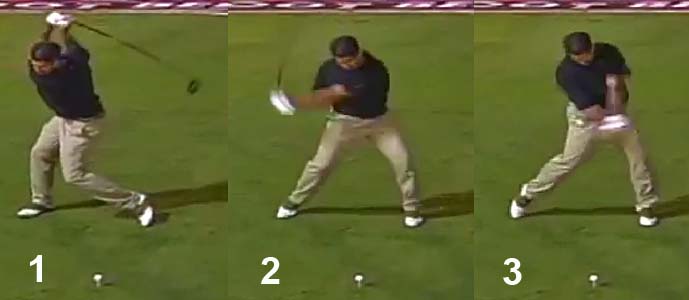
Carl Wolter's downswing action - capture images from Greg Rose's video presentation
Image 1 shows Carl Wolter at the end-backswing position. Note that he is using a right-loading pelvic motion technique in his backswing. Note that he maintains a lot of flex in his right knee and that he "turns into" his right hip joint as he rotates his pelvis far more clockwise than his right thigh during his backswing action. I suspect that he is weight-pressure loading his right leg at the P4 position and optimally stretching (pre-loading) the lateral pelvic rotator muscles in his right buttocks. Note that he has elevated his left heel as he adducts his left thigh during his backswing, thereby optimally stretching (pre-loading) the lateral pelvic rotator muscles in his left buttocks.Image 2 shows Carl Wolter at the P5 position. Note that both thighs are externally rotated and I presume that he has maximally activated his lateral pelvic rotator muscles bilaterally with the optimum degree of efficiency, which allows him to generate a very fast pelvic rotaional speed by P5.
Image 3 shows Carl Wolter nearing impact. Note that his left knee is still flexed and he doesn't fully straighten his left leg (like the two long-drive competitors featured in examples 1 and 2). Note that his left pelvis is near-level and not elevated. Note that his left shoulder socket is not significantly elevated and I can detect no evidence that he has a shortened hand arc radius near impact, which is necessary for the generation of parametric acceleration. In other words, I think that he is not using a significant amount of parametric acceleration in his swing action when he hits 400+ yard drives, and I think that his swing power is primarily secondary to the efficiency of his sequential pelvic and upper torso (shoulder) rotational motions. Note that he doesn't manifest any evidence of a "jumping-up" action through impact.
To confirm that this swing sequence (from the Greg Rose video presentation) is typical of Carl Wolter's standard long-drive swing action, I studied a few more Carl Wolter swing videos.
Here is a you-tube video featuring Carl Wolter's driver swing action - https://www.youtube.com/watch?v=NpfkLDyxEC8
Here are capture images from his swing video.

Carl Wolter's downswing and followthrough action - capture images from his swing video
Image 1 shows Carl Wolter as he approaches the end of his backswing action. Note that he maintains a lot of flex in his right knee during his backswing action and that he "turns into" his right hip joint as he rotates his pelvis far more clockwise than his right thigh. Note that he is appears to be using a borderline right-loading pelvic motion technique in his backswing action.Image 2 shows Carl Wolter at his end-backswing position. Note that his pelvis has shifted a little to the left as he settles into his P4 position, so he looks more like a center-loading pelvic motion technique golfer. I suspect that he is significantly weight-pressure loading his right leg at the P4 position and optimally stretching (pre-loading) the lateral pelvic rotator muscles in his right buttocks. Note that he has elevated his left heel as he adducts his left thigh during his backswing action, thereby stretching (pre-loading) the lateral pelvic rotator muscles in his left buttocks to a small degree (but not as much as seen in the Greg Rose video swing).
Image 3 shows Carl Wolter at the P5 position. Note that both thighs are externally rotated and I presume that he has maximally activated his lateral pelvic rotator muscles bilaterally with the optimum degree of efficiency, which allows him to generate a very fast pelvic rotational speed by P5.
Image 4 shows Carl Wolter in his late downswing (near impact). Note that he still has a significant amount of flex in his left knee and he has not fully straightened his left leg. Note that he has a minimal amount of left pelvis elevation (minimal O factor) as he nears impact. Note that his left shoulder socket is not significantly elevated and I suspect that he is generating very little (if any) parametric acceleration of his clubhead secondary to a shortened hand arc radius near impact.
Note that he is up-on-his-toes at P8 (image 5), but the amount of heel-lifting is not substantial, and he doesn't manifest an overt "jumping-up" action through impact.
I strongly suspect that Carl Wolter can hit 400+ yard drives primarily due to the efficiency of his pelvic and upper torso's rotational motions, and that parametric acceleration plays very little role in his long-driving prowess.
There are also a number of interesting biomechanical features of his downswing action, which contradict those arbitrarily/rigidly promoted by Kelvin Miyahira (and his disciple Jeff Martin) for long-drive competitors - i) He doesn't have a very open pelvis at impact (like Bubba Watson and Jamie Sadlowksi); ii) he doesn't manifest a lot of secondary axis tilt and right lateral bend in his later downswing (like Bubba Watson and Jamie Sadlowski); iii) he doesn't markedly straighten his left leg and markedly elevate his left pelvis (exaggerated 2nd pelvic firing phenomenon) in his late downswing and ii) he doesn't exaggeratedly float-rotate his lead heel rearwards away from the target through impact (like Bubba Watson). I think that these biomechanical differences are mainly due to the fact that Carl Wolter is probably a front foot group golfer, while Bubba Watson and Jamie Sadlowski are reverse group golfers, and I suspect that both of those swing styles are equally suitable for maximising ball flight distance in long-drive competitors. I think, therefore, that individual long-drive golfers should experiment by using both swing styles to determine which swing style works best for them as they strive to reach their personal goal of maximising their driving distance.
I think that Carl Wolter is a good role model for potential long-drive competitors, who agree with my belief that they should mainly concentrate their learning efforts on learning how to optimise their pelvic and upper torso's rotational motion during their downswing, while simultaneously avoiding exaggerated "jumping-up" motions through impact that make it very difficult to consistently hit the ball with the sweetspot of the clubface, which is a necessary requirement if a golfer wants to consistently maximise his smash factor.
Here is an example of another long-drive competition winner, who has a very rotary downswing pivot action with very little elevation of the left pelvis, and left shoulder socket, through impact.
David Mobley swing video - https://www.youtube.com/watch?v=HEeM8PM5Kts
If you watch the first 15 seconds of that video, you will note that he manifests very little positive O factor (left pelvis elevation) in his late downswing and early followthrough, but he has a superb rotary type of pivot action involving both his pelvis and upper torso (shoulders). Note that he is a front foot golfer (like Carl Wolter) and note that he seemingly transfers most of his overall weight-pressure to his left heel in his late downswing and that his left forefoot turns targetwards through impact, while his left heel stays solidly grounded.
Finally, here is a third example of a long-drive competitor who can win the ReMax long-drive competition without "jumping up" through impact (in an attempt to generate vertical ground reaction forces) - Jeff Flagg, who was the winner of the 2014 ReMax long drive competition.
Jeff Flagg swing video - https://www.youtube.com/watch?v=OsRLqnef1Xo
Here are capture images of his downswing action.

Jeff Flagg's downswing action - capture images from his swing video
Image 1 shows Jeff Flagg at his end-backswing position. Note that he has maintained some flex in his right knee as he "turns into" his right hip joint using a center-loading pelvic motion technique.Image 2 shows Jeff Flagg at the P5 position. Note that he doesn't have the 'Sam Snead sit-down' look like Jamie Sadlowski, and his right heel is already significantly elevated off the ground.
Image 3 shows Jeff Flagg at the P6 position. Note that his pelvis is level despite an elevated right heel.
Image 4 shows Jeff Flagg at impact. Note that his pelvis is level and he doesn't have an elevated left pelvis (positive O factor) or an exaggerated elevation of his left shoulder socket. There is no evidence that he is using any parametric acceleration by shortening his hand arc path radius as he nears impact. Note that he "appears" to be a front foot golfer who has most of his weight-pressure located over his front foot at impact. Note how his left foot is rolled outwards and he is not using the floating lead foot technique (like Jamie Sadlowski and other reverse group golfers).
Image 5 shows Jeff Flagg at the P7.3 position. Note that he still has a level pelvis and there is no evidence of him "jumping up" through impact. Also, note that has a bowed/arched left wrist and his clubshaft has not bypassed his left arm, which means that he is using a drive-hold hand release action - and that proves that a golfer doesn't have to let the clubhead bypass the hands immediately post-impact (pro flipping action) in order to generate the maximum clubhead speed at impact. Jeff Flagg (like Carl Wolter) demonstrates that one can win the ReMax long-drive competition using a DH-hand release action!
In summary, Carl Wolter, David Mobley and Jeff Flagg demonstrate that a front foot golfer can hit 400+ yards drives, and win long-drive competitions, without "jumping up" through impact and without manifesting an exaggerated O factor phenomenon.
Now, although I personally disapprove of any exaggerated elevation of the left shoulder socket in the late downswing secondary to a "jumping up" action, I think that a consistent pattern of vertical elevation of the left shoulder socket between P6 and P7 is very useful if a golfer wants to have a consistent low point location. If you study the golf swings of many professional golfers (eg. Tiger Woods and Adam Scott) you will note that the low point of their driver swing is always located at the same spot (just inside their left foot and vertically beneath their left shoulder socket) in swing-after-swing. How do they consistently ensure that the low point of their clubhead arc is always consistently located at the same spot in swing-after-swing?
Consider an example - Tiger Woods driver swing.
Nike commercial swing video of Tiger Woods' driver swing - https://www.youtube.com/watch?v=meVTld5GvbM
Here are capture images from his swing video.

Tiger Woods' backswing and downswing action - capture images from his swing video
Image 1 is at address. I have placed a red dot over his sternal notch area (which roughly reflects the position of the upper swing center).Image 2 is at the end-takeaway P2 position. Note that his sternal notch is moving away from the red dot as he starts to rotate his upper torso around his rightwards-tilted spine.
Image 3 is at the end-backswing P4 position. Note that his sternal notch has moved a fair distance away from that red dot location. Note that I have now placed a white dot over the location of his left shoulder socket, so that I can trace the path of his left shoulder's motion during his downswing action.
Image 4 is at the P5 location. Note that his sternal notch is located some distance away from the red dot. The blue splined path (that connects the white dots) shows the motion of his left shoulder socket between P4 and P5. Note that the left shoulder socket mainly moves targetwards during the early downswing between P4 and P5, and it doesn't move upwards.
Image 5 is at the P5.5 location. Note that the left shoulder socket is still moving targetwards, but it is now also moving slightly upwards.
Image 6 is at the P6.5 position and image 7 is at low point. Note that the left shoulder socket has only moved upwards, and it has not moved targetwards, during this time period. Also, note how Tiger Woods' sternal notch is very close to the red dot location during this late downswing time period between P6.5 and low point.
Consider a more detailed view of his left shoulder socket's motional path and clubhead arc.
Tiger Woods' left shoulder socket's motional path during the downswing (blue) and clubhead arc path (red)
Image 1 shows his left shoulder socket's motional path (in blue) during the downswing. Note that the club has caught up to his straight left arm by low point, and that both his straight left arm and the clubshaft (which is straight-in-line with his left arm) are vertically aligned beneath his left shoulder socket at low point.Image 2 shows the clubhead arc (in red ). The point "X" represents the lowest point (nadir point) of his clubhead arc and it is located vertically beneath his left shoulder socket (point "L") and not vertically below his sternal notch (point "S"). Note that point "X" is located just behind the ball location, which means that the clubhead arc is moving marginally upwards at impact. In other words, by placing his ball at a location that is just ahead of his anticipated low point location, Tiger Woods can ensure that the clubhead is moving very slightly upwards at impact. How does Tiger Woods ensure that the left arm and clubshaft are straight-line-aligned at low point, and also ensure that they are both vertically aligned beneath the left shoulder socket at low point? To get the club to catch up to the left arm by low point requires perfect timing of the release of PA#4 => PA#2 (which releases according to the physics underlying the laws of the double pendulum swing model), but even perfect PA#4 => PA#2 release timing wouldn't ensure that low point is always located at the same spot vertically below his left shoulder socket if he didn't have a consistent pattern of 3-D motion of his left shoulder socket during his late downswing. Let's consider the pattern of Tiger Woods' left shoulder socket motion that is needed during the late downswing in order to ensure a consistent low point location.
Tracing the path of motion of Tiger Woods' left shoulder socket during the later downswing - capture images from his swing video
Image 1 is at the P5.5 position. Note that Tiger Woods' sternal notch is close to the red dot (which was drawn at the sternal notch's location at address). I have placed a yellow dot over the location of his left shoulder socket.Image 2 is at the P6 position. I have placed a blue dot over his left shoulder socket's location. Note that the blue dot is near-vertically above the yellow dot.
Image 3 is at the P6.5 location. I have placed a green dot over his left shoulder socket's location. Note that the three colored dots are close to being perfectly vertically aligned.
Image 4 is at low point. Note that his left shoulder socket is located vertically above the green dot by a miniscule amount. Note that his left shoulder socket's motional path has been vertically upwards between P6 and low point. What biomechanical factors cause the left shoulder socket's motional path to become vertically-aligned in the late downswing between P6 and low point?
Note that his sternal notch (upper swing center) remains very close to the red dot between P6 and low point. Note that he is bracing his left leg so that there is no swaying of his pelvis or upper torso leftwards/targetwards during the P6 to low point time period. Note that the left leg is straightening during this time period, which causes elevation of the pelvis, and that his upper torso is rotating around his stable upper swing center during the same time period - and the synchronous coordination between these two biomechanical phenomena causes the left shoulder socket to only move vertically upwards (and not targetwards) while the club is releasing and progressively catching up to the straight left arm. If the timing of Tiger Woods' PA#4 => PA#2 release is optimised so that the club catches up to the straight left arm by low point, then the "fact" that the left shoulder socket is only moving vertically upwards during this critical catching-up time period makes it much easier to ensure that low point is consistently in the same location vertically beneath the left shoulder socket. Slight variations in the degree of left leg straightening, and therefore the degree of left pelvis elevation, and/or slight variations in the degree of extension of the left side of the upper torso may affect the vertical height of the left shoulder socket at low point, but as long as the motional path of the left shoulder socket is always vertical in the late downswing, then these slight variations will not affect the location of low point. The key learning point for a developing golfer is that he must ensure that his *left shoulder socket moves vertically (or near-vertically) upwards in the late downswing on a consistent swing-after-swing basis, and I think that it is easier to achieve that goal if one better understands the underlying biomechanical factors in play.
(* the fact that the left shoulder socket is moving vertically upwards throughout the late downswing between P6 and P7 doesn't mean that parametric acceleration is being applied because that phenomenon requires a shortening hand arc path radius due to an exaggerated degree of left shoulder socket elevation, which isn't happening to any significant degree in Tiger Woods' driver swing. Note that the motional path of his hands and clubhead path is near-horizontal to the ground during the P6.5-P7 time period)
Consider another example of a golfer who has a consistent low point location - Adam Scott.
Strobe swing video of Adam Scott's driver swing - https://www.youtube.com/watch?v=nxOOuhMW0kA
Here are capture images from the strobe video of Adam Scott's swing.
Adam Scott's clubhead arc - capture images from his swing video
Image 1 shows his clubhead arc.The red "X" in image 2 is the low point (nadir point) of his clubhead arc. Note that Adam Scott places his ball about 2" behind low point and the clubhead is traveling very slightly downwards towards low point at the time of ball impact. Note that his straight left am is straight-line-aligned with his clubshaft at low point, and they are both also vertically aligned below his left shoulder socket at low point (image 2).
Consider the motional path of Adam Scott's left shoulder socket during the late downswing.
Adam Scott's left shoulder socket motion during the late downswing - capture images from his swing video
The red dot represents the position of his sternal notch (upper swing center) at address.Image 1 shows Adam Scott at the P6 position. Note that his sternal notch is located close to that red dot - even though his sternal notch was located well away from that red dot during the P2-P6 time period. I have placed a yellow dot over the location of his left shoulder socket.
Image 2 is at the P6.5 position. I have placed a blue dot over the location of his left shoulder socket. Note that the blue dot is vertically above the yellow dot.
Image 3 is at low point. Note that his left shoulder socket is vertically aligned with the blue/yellow dots and it is minimally higher than the blue dot.
Note that his sternal notch has remained in the same location as the red dot between P6 and low point.
In summary, Adam Scott has ensured that his sternal notch is in a stable location between P6 and low point, while simultaneously ensuring that that his left shoulder socket is only moving vertically upwards during this same time period (during the late downswing's club releasing phase). To achieve that goal he had to get the underlying biomechanical movements perfectly synchronised - and those biomechanical movements primarily include the fact that i) he establishes a stable left leg that progressively straightens during the late downswing and that causes the left pelvis to elevate without any left-lateral swaying motion of the pelvis; ii) and he maintains a stable upper swing center during the P6-to-P7 time period while continuing to rotate the upper torso around that stable upper swing center in such a manner that the left shoulder socket moves vertically upwards (and not targetwards).
Topic number 5: Is dynamic torso-pelvic separation (dynamic X factor) at the start of the downswing mandatory if a skilled golfer wants to generate the maximum degree of swing power when using an active pivot action swing?
Many golf instructors teach their students to start their downswing with an active counterclockwise pelvic rotation and they also teach them to simultaneously "keep their shoulders back" so that can generate an increased degree of torso-pelvic separation (*increased X factor) at the start of the early downswing.
(* Jim McClean apparently originated the term "X factor" and I discussed this topic in a review paper called "Jim McLean's Triple X factor - A Critical Review")
Here is an image from JimMcLean's article [14] where he demonstrates the phenomenon of a dynamic X factor.
Jim McLean demonstrating the dynamic X factor phenomenon - image from reference number [14]
Image 1 shows Jim McLean at his end-backswing position with a finite amount of torso-pelvic separation (static X factor) - where the upper torso (shoulders) have rotated more clockwise than the pelvis during the backswing.Image 2 shows his early downswing action - note that he has rotated his pelvis counterclockwise, while keeping the shoulders back, thereby generating an increased degree of torso-pelvic separation at the start of the downswing (dynamic X factor). Jim McLean believes that generating an increased degree of torso-pelvic separation at the start of the downswing will increasingly stretch the muscles of the mid-upper torso, and thereby allow the golfer to rotate the mid-upper torso at a greater speed when the upper torso (shoulders) subsequently start to rotate fractionally later in the early downswing. Theoretically, that should increase the speed of rotation of the upper torso (shoulders) during the downswing's active pivot action, and that should theoretically allow a golfer to generate an increased amount of clubhead speed at impact.
I was never really sympathetic to Jim McLean's dynamic X factor ideology, but I did include the dynamic X factor phenomenon in my "theoretical kinematic sequence" diagram that I used in my downswing chapter.
Theoretical Kinematic Sequence graph - created by author
Rv = Angular velocity of rotation. P = Pelvic rotational velocity graph. S= Shoulders = Upper torso (thorax) rotational velocity graph. LA = Left arm rotational velocity graph.I created this theoretical kinematic sequence graph by simply copying a standard TPI kinematic sequence graph that Greg Rose/Phil Cheetham use to demonstrate the optimum kinematic sequence, but I exaggerated the degree of delay between the start of the pelvic rotation velocity graph and the uppper torso (shoulders) rotational velocity graph. According to Jim McLean and Phil Cheetham, an optimum kinematic sequence means that the pelvis should start to rotate before the upper torso (shoulders) start to rotate at the start of the downswing, and this biomechanical phenomenon should generate an increased degree of torso-pelvic separation (dynamic X factor) at the start of the early downswing. Then, after a fractional delay, the upper torso (shoulders) and arms should start to rotate together at the same rotational velocity (as shown in the above graph) with the peak rotational speed of the upper torso (shoulders) happening after the pelvis reaches reaches its peak rotational speed.
Here is an animated gif of a golfer - Bubba Watson - who uses this early downswing pattern, where the pelvis rotates first before the upper torso (shoulders) start to turn.
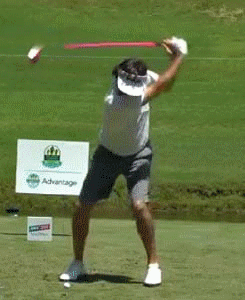
Bubba Watson's early downswing - animated gif created from capture images derived from a swing video
The animated gif consists of 5 sequential captured frames from a Bubba Watson swing video. The 1st frame represents his end-backswing position, and the next 4 frames represent his early downswing action. If you look carefully at the first two frames of his downswing sequence, you will note that he is rotating his pelvis clockwise and simultaneously abducting/externally rotating his lead thigh - before his upper torso (shoulders) start to rotate. In other words, Bubba Watson is prototypical example of a golfer who uses the dynamic X factor technique and many golfers believe that it explains why he is such a long driver of the golf ball. However, although I have no personal objection to using the dynamic X factor technique to start the downswing's pivot action, I increasingly believe that it doesn't necessarily contribute much to swing power (which can be simply defined as a golfer's ability to maximise his clubhead speed at impact). My reason for not being very convinced in the ultimate value of a dynamic X factor technique is that I have discovered that many PGA tour golfers, and long drive competitors, do not use that technique to drive the ball equally as far as their competitor dynamic X factor golfers. Consider a few examples.Gary Woodland is an example of a PGA tour golfer, who hits the ball as far as Bubba Watson, and he starts to rotate his upper torso (shoulders) at the very start of the downswing without any significant dynamic X factor delay.
Gary Woodland swing video - https://www.youtube.com/watch?v=Tb9Q-d9FWjQ
Here are capture images from his swing video.
Gary Woodland's early downswing action - capture images from his swing video
Image 1 shows Gary Woodland in his late backswing a few frames before he reaches his end-backswing position (end-backswing position is defined as the time point in the backswing just before the club first starts to move in the opposite direction). I have drawn red lines alongside the outer border of his pelvis/upper thighs as reference points.Image 2 is his end-backswing position (which is the video frame just before his club reverses its direction of motion, and which indicates the start of the downswing). Note that he has already started to shift his pelvis left-laterally and that he has also started to rotate his pelvis counterclockwise. I have drawn a yellow line along the outer border of his left upper torso and I have placed a yellow dot over his right shoulder.
Image 3 is the very start of his downswing action - captured as soon as his clubhead starts to reverse its direction of motion. Note that you can see some blue shirt left of the yellow line indicating that he is starting to rotate his upper torso counterclockwise, and note that his right shoulder has moved downwards and away from the target (I have placed a green dot over his right shoulder's location and it has moved away from the yellow dot). Note how little the clubhead has moved in this image - compared to image 2 - and it indicates that Gary Woodland already has started to rotate his upper torso (shoulders) as soon as the downswing starts and that there is no "keeping-the-shoulders-back" delay phenomenon as seen at the start of Bubba Watson's downswing action.
In other words, these capture images demonstrate that Gary Woodland has minimal torso-pelvic separation at the start of his downswing action.
Here is a 3-D graph of Gary Woodland's downswing action.
Gary Woodland's pelvic and upper torso (thorax) rotational velocity graphs - copied from an image in reference number [11]
Top = End-backswing position, which is depicted by the vertical black line. The light green vertical line represents impact.The red graph plots Gary Woodland's pelvic rotational velocity and the green graph plots his upper torso's (thorax's) rotational velocity. The horizontal thin black line represents zero rotational speed in a counterclockwise direction, and when the two graphs cross above that horizontal (zero) line, they indicate a finite degree of positive rotational speed in a counterclockwise direction by an amount that is greater than zero.
Note that the pelvic graph crosses that horizontal (zero) line during the late backswing indicating that the pelvis is already rotating counterclockwise before his golf club reaches its end-backswing position. Note that his upper torso (thorax) graph also shows evidence of crossing the horizontal (zero) line before the end-backswing position and there is minimal delay between the counterclockwise of his upper torso (thorax) relative to the counterclockwise rotation of his pelvis, which means that he has minimal dynamic X factor happening in his swing action. Note that his upper torso's rotational velocity soon exceeds the rotational velocity of his pelvic rotation and that it happens in his early downswing. Interestingly, note that both his pelvis and upper torso reach their peak rotational velocity at roughly the same time (and not sequentially - as seen in a standard TPI kinematic sequence graph). This 3-D graph reflects what I actually see visually when I examine Gary Woodland's swing videos using a swing analyser program that allows me to examine the video frame-by-frame - that i) Gary Woodland has minimal delay with respect to the rotation of his upper torso (relative to the rotation of his pelvis) when he starts his downswing and ii) that his upper torso's rotational speed soon exceeds the speed of his pelvic rotation. These two facts contradict Phil Cheetham's optimum kinematic sequence "belief" (which forms the basis of the K vest's recommended swing parameters). Gary Woodland demonstrates that a golfer can efficiently drive the ball a long distance without using an overt dynamic X factor technique (like Bubba Watson) and without ensuring that the pelvis reaches its peak rotational speed before the upper torso reaches its peak rotational speed. I think that it is a fallacy to believe that the pelvis must rotate first and the upper torso second using a dogmatically-prescribed kinematic sequence pattern that is primarily based on using an arbitrary amount of dynamic torso-pelvic separation at the start of the downswing. Professional golfers vary considerably in the amount of dynamic torso-pelvic separation (dynamic X factor) that they manifest at the start of the downswing, and there is no sound scientific evidence to support the ideology that a golfer must maximise his dynamic X factor in order to maximise his clubhead speed at impact.
Consider another golfer who is a long driver by PGA tour standards - Rory McIlroy.
Rory McIlroy back view swing video - https://www.youtube.com/watch?v=S_BUc-V_9QU
Here is an animated gif created from the first few frames from the start of his downswing action.
Rory McIlroy's early downswing - animated gif created from capture images from his swing video
Rory McIlroy, in contrast to Gary Woodland, doesn't start to rotate his pelvis counterclockwise during the late backswing time period, and he only starts to rotate his pelvis counterclockwise at the very start of the downswing. However, like Gary Woodland, he doesn't significantly use the dynamic X factor technique like Bubba Watson, and he manifests minimal dynamic torso-pelvic separation at the start of his downswing.Consider a 3-D graph of Rory McIlroy's swing, which I obtained from the following you-tube video - https://www.youtube.com/watch?v=UeF9-U5r3So
I noted that when Greg Rose was talking about Rory McIlroy's "reverse pelvic motion" phenomenon (which I will discuss later) that there was a 3-D graph in the background, and I have captured that graph in this next image.
Greg Rose discussing Rory McIlroy's "reverse pelvic motion" phenomenon - capture image from the swing video
If you look at the vertical line depicting the start of the downswing (which is just to the right of Greg Rose's right index finger in image 2), you will note that the red graph (depicting Rory McIlroy's pelvic rotational velocity) only crosses the horizontal zero line at the start of the downswing, and that the green graph (depicting the rotation velocity of his upper torso [thorax]) starts to become positive at exactly the same time. Consider a modified version of that 3-D graph.
Modified version of the TPI graph - capture image from the swing video
I have modified that graph by bold-highlighting in red the pelvic rotational velocity graph. I have also drawn a vertical blue line that represents the start of the downswing and a black vertical line that represents impact. The black horizontal line represents the zero point, and if the rotational velocity graph is above that horizontal line then it represents a positive counterclockwise rotational velocity of a finite magnitude.Note that Rory McIlroy's pelvis starts to rotate counterclockwise at the start of the downswing, and the slope of the red graph is very steep indicating a very fast rate of pelvic acceleration. Note that his pelvis reaches its peak rotational velocity (of ~700 degrees/second according to Greg Rose) at roughly the start of his late downswing and it then decelerates fast.
The green graph represents his upper torso's (thorax's) rotational velocity - note that his upper torso (thorax) also starts to rotate very fast at the start of the downswing and that there is a minimal amount of dynamic torso-pelvic separation (dynamic X factor) in his downswing action. Note that his upper torso (thorax) rotates faster than his pelvis by the time he reaches his mid-downswing and that the peak rotational velocity of his upper torso (thorax) occurs at roughly the same time as his pelvis reaches its peak rotational velocity. In other words, his downswing pattern is very similar to Gary Woodland's downswing pattern - and they both manifest a minimal amount of dynamic torso-pelvis separation (dynamic X factor), and they both accelerate their upper torso very fast in the early-mid downswing so that their upper torso's rotational speed peaks at roughly the same time as the peak rotational speed of their pelvis.
Both Gary Woodland and Rory McIlroy are long drivers of the ball (by PGA tour standards) and it demonstrates that a skilled golfer doesn't need to i) use a significant amount of dynamic X factor and/or ii) have the pelvis reach its peak rotational velocity well before the upper torso (thorax) reaches its peak rotational velocity (as seen in a standard TPI graph).
I would encourage golfers to try a i) minimal, or ii) intermediate, or iii) maximum degree of use of the dynamic X factor phenomenon at the start of their early downswing action to see what works best for them, because all these three options are biomechanically sound and they are all successfully used by many professional PGA tour golfers and long-drive competitors.
Topic number 6: Does the "spine engine" increase counterclockwise lumbar spine and pelvic rotation in the late downswing when a golfer has acquired a lot of right lateral bend, and is it dependent on the golfer's lumbar spine being in a state of lumbar lordosis?
When I discussed the potential role of the "spine engine" (which is based on the biomechanical combination of right lateral bend + lumbar lordosis) in inducing pelvic rotation at the start of the downswing, I took the position that it could not possibly play a significant role because i) the amount of right lateral bend that is present between P4 and P5 is too small in magnitude and ii) that the compressed/concave area of the right lateral bend only occurred at the level of the lower thoracic spine (whose vertebra are incapable of interlocking), and not at the level of the lumbar spine.
However, what about the later downswing, when the degree of right lateral bend is greater and the concave/compressed area of the right lateral bend can also involve the upper lumbar spine.
Consider the appearance of Tiger Woods in his late downswing.
Tiger Woods' downswing action - adapted from inages in a Kelvin Miyahira paper
Note that Tiger Woods has virtually no right lateral bend at the end of his early downswing position - image 4. Note that he acquires a very small degree of right lateral bend in his mid-downswing (image 5) but note that it doesn't involve the lumbar spine area (which is below the yellow line).
Note that Tiger Woods acquires a much greater degree of right lateral bend during his later downswing and he certainly has a lot of right lateral bend by impact (image 6). I personally do not doubt that the compressed/concave area of the right lateral bend zone also involves the upper lumbar spine, and not only the thoracic spine, during the late downswing.
Therefore, I have no problem partly agreeing with Kelvin Miyahira's following diagram.
Right lateral bend in the later downswing time period - copied from an image in reference number [15]
Note that the lumbar interfacet joints on the concave/compressed side of the right laterally bent area of the lumbar spine "appear" to be more interlocked, so that any counterclockwise rotation of the thoracic and lumbar spine will cause the lumbar spine to more easily continue to rotate counterclockwise during the later downswing - when the golfer is actively rotating his mid-upper torso counterclockwise during the P6 to P7 time period. However, I differ from Kelvin Miyahira because I believe that the lumbar spine may automatically/naturally continue to rotate counterclockwise during the late downswing if the mid-upper torso is actively rotating counterclockwise - even if the lumbar spine is not significantly lordotic. In other words, I believe that the lumbar spine interfacet joints are always interlocked if the lumbar spine is either i) hyperlordotic, or ii) neutral (minimally lordotic), or iii) even slightly flexed (straightened lumbar spine condition) and I believe that the lumbar interfacet joints only become unlocked if the lumbar spine is hyperflexed, which doesn't happen in any professional golfer during the P6 to P7 time period. I also believe that the lumbar interfacet joints are automatically/naturally interlocked in those three lumbar spine postural states even in the absence of right lateral bend and I believe that a skilled golfer can easily continue to rotate the lumbar spine counterclockwise during the P6 to P7 time period if the mid-upper torso's active counterclockwise rotation is secondarily inducing a counterclockwise rotation of the thoracic and lumbar spine - even if right lateral bend is not present. Although I can readily agree with a "belief" that adding right lateral bend to the mix may make it easier to rotate the lumbar spine and pelvis counterclockwise in the later downswing (via a "coupling motion" phenomenon), I do not believe that right lateral bend is a mandatory biomechanical requirement.By contrast, Kelvin Miyahira implies that if the lumbar spine is not lordotic, and if it becomes straightened in the later downswing as the golfer approaches impact, that the presence of right lateral bend will actually cause the lumbar spine to rotate clockwise (away from the target), rather than counterclockwise (towards the target), thereby promoting a stalling of the counterclockwise rotary motion of the lumbar spine and pelvis. In other words, he argues that in the presence of right lateral bend the lumbar spine's vertebra will turn in opposite directions depending on whether the lumbar spine is straight or lordotic. This coupling phenomenon, where adding right lateral bend of the spine automatically/naturally induces a secondary induced rotary motion of the spine affected by the side-bending phenomenon, is referred to as a coupling motion. According to Kelvin Miyahira, the direction of the coupling motion (direction of rotary motion of the vertebra affected by the side-bending phenomenon) is dependent on the postural alignment of the lumbar spine - being ipsilateral if the spine is straight and contralateral if the spine is lordotic.
Jeff Martin (Kelvin Miyahira's swing disciple) has made the same claim when debating in golf forums [16]. He asserted that Serge Gracovetsky got this coupling motion idea from research performed by Fryette in 1918.
Here is a link to a blog article by a physiotherapist who describes the origin of Fryette's laws - http://koushikphysio.blogspot.com/2011/11/fryettes-laws.html
To quote directly from the blog article-: "Harrison M Fryette(1876-1960) was an early ‘pioneer’ osteopath who researched spinal motion over a number of years, with a seminal paper on the principles of spinal motion delivered to the American Osteopathic Association in 1918. However, it was some time before his ideas gained ground, until they were eventually revisited and relabelled as ‘laws’ as late as 1956 by T Edward Hall in the yearbook of the Osteopathic Institute of Applied Technique. The original principles were: Principle I: When the spine is in neutral, sidebending to one side will be accompanied by horizontal rotation to the opposite side. Principle II: When the spine is flexed or extended (non-neutral), sidebending to one side will be accompanied by rotation to the same side."
Here is a diagram showing Freyette's laws, which are still used by some chiropractors.
Fryette's laws - copied from reference number [17]
Note that in a type I motion, that sidebending causes rotation of the vertebra to the opposite side (convex side) and that result is predicted if the spine is neutral.Note that in a type II motion, that sidebending causes rotation of the vertebra to the same side (concave side) and that result is predicted if the spine is not neutral.
What type of research formed the basis for Fryette's predictions, that decades later became established as laws of osteopathy?
To quote again from the blog article-: "On what basis were these ideas formulated? Fryette drew heavily on earlier work conducted by Lovett in 1905. The research methodology consisted of cadaveric study and in vivo research via the application of gummed paper stickers to the spinous processes of a small number of student volunteers. The results were obtained by observing relative motion of these gummed paper stickers, and inferring as a consequence, the nature of the underlying spinal motion which had occurred."
That description represents a very inexact method of clinical research, and the author of the blog article then stated-: "Over the last century kinematic research has progressed from direct observation, cadaveric study, radiological analysis, cineradiology, CT, MRI, Steinman pins, implanted Gallium balls, to computer modelling. The more we are able to visualise and research living spinal motion, the more complex and unpredictable is the precise combination of individual joint rotation and translation for each region and segment. Rather than definitive ‘laws’ it appears that there are substantial individual and regional variations with, as yet, no accurate model for predicting all of the motion behaviour. With all this uncertainty why do some of us still persist in promoting a model for physiological motion based on work conducted over 100 years ago? The work of Fryette must be applauded for it’s longevity and insight, and celebrated as part of our osteopathic heritage and history, but the ‘laws’ can no longer be viewed as such, nor do they serve as a viable explanation of physiological motion behaviour."
Jeff Martin obviously disagrees with that blog author's conclusion and in post #698 of that golf forum thread [16] he stated-: "Fryette's laws are still considered valid by biomechanists. --- Much research has been done since the days of Fryette. More recent research states that lordosis is a prerequisite for contralateral rotation from lateral bending of the lumbar spine, and that flexion of the lumbar spine and lateral bend will cause rotation in the same direction (ipsilateral rotation)."
Does more recent research indeed show that lordosis is a prerequisite for contralateral rotation of the lumbar vertebra secondary to the imposition of right lateral bend, and does it show that lumbar flexion (straightening of the lumbar spine) during the imposition of right lateral bend will cause lumbar spine rotation in the same (ipsilateral) direction?
Not according to a research review article that I discovered!
Here is a link to a literature review article that discusses all the research studies performed with respect to lumbar spine coupling motions-:
http://www.shelbournephysio.ca/images/uploads/79/coupledmotions.pdf
In that literature review article ("Lumbar spine coupled motions: A literature review with clinical implications"), the author defines coupling motions as follows-: "Paris and Loubert defined coupled motions as combined motions that are mechanically forced to occur. Kaltenborn et al proposed a more clinically oriented definition describing coupled motions as movement combinations that result in the greatest ease of movement, i.e., producing the greatest range of motion and the softest endfeel. In biomechanical terms, coupled motion is the phenomenon of a consistent association of a motion along or about one axis, whether it be a translation or a rotation, with another motion about or along a second axis; the principal motion cannot be produced without the associated motion occurring as well. Coupled motion can also be defined as the motion that occurs in directions other than the direction of the load applied."
Using those definitions of coupling motion, one can ask this relevant question-: What type of rotary motion will automatically/naturally be produced with respect to the lumbar vertebra if they subjected to a side-bending (lateral flexion) load, and is the direction of rotary motion dependent on the positional alignment of the lumbar spine (lordosis versus non-lordosis)?
The author of that literature review article listed all the research studies (performed on asymptomatic individuals) that relate to the issue of "coupled lumbar spine motion induced by side-bending" in this table 2.
Research studies performed on asymptomatic individuals - from the literature review atrticle
If you look at the "average" results of those research studies, one could reasonably conclude (that on "average") that initiating side-bending either has no effect or it induces a secondary coupling motion-induced rotation of the lumbar vertebra to the opposite (contralateral) side and that the direction of the coupling motion-induced rotary effect is independent of the baseline lumbar spinal posture (neutral or flexed or extended).In other words, there is no scientific support for Kelvin Miyahira's position, that in the presence of right lateral bend, that a straightened (slightly flexed lumbar spine) will induce a secondary ipsilateral lumbar rotation (via the coupling motion phenomenon) that will then produce stalling of the counterclockwise rotation of the lumbar spine and pelvis in the later downswing as the golfer nears impact. According to that article, the more clinically-oriented definition of a coupled motion is "movement combinations that result in the greatest ease of movement, i.e., producing the greatest range of motion and the softest endfeel". Based on the result of those studies, and using that more clinically-oriented definition, I have no reason to question a "belief" that adding right lateral bend to the lower thoracic and upper lumbar spine during the mid-late downswing may make it easier for the lumbar spine to rotate contralaterally (away from the concave side of the right lateral bend) and in the same counterclockwise direction that the mid-upper torso is rotating (secondary to the active muscular contraction of the core muscles of the mid-upper torso). I could even easily accept a "belief" that it may cause the pelvis to become slightly more open by impact - presuming that the core muscles of the mid-upper torso (that cause the mid-upper torso to rotate counterclockwise during the downswing) contract with the same amount of rotary-inducing force. However, I cannot accept Kelvin Miyahira's didactic "belief" that the "spine engine" is actually powering the counterclockwise rotation of the lumbar spine and pelvis during the later downswing secondary to a mandatory biomechanical combination of "right lateral bend and lumbar lordosis".
Finally, of all the "spine engine" ideas presented by Kelvin Miyahira, the most bizarre idea relates to his "belief" that the spine can act as an elastic (energy-storing and energy-releasing) flexible rod - if right lateral bend and lordosis are present.
See Kelvin Miyahira's video on the spine being equivalent to an elastic, flexible rod - https://www.youtube.com/watch?v=aNvi1kdo4Wg
Kelvin Miyahira thinks that the human spine (and its associated dorso-lumbar paraspinal fascia) can act like that "snapping flexible ruler-rod" and that it can store, and release, elastic energy in such a manner that the lumbar spine, and therefore pelvis, can rotate faster during the elastic energy-releasing phase - thereby causing the lumbar spine and pelvis to rotate faster than any rotation that is solely due to muscular forces that cause the pelvis and mid-upper torso to rotate counterclockwise during the late downswing. I believe that this "elastic, flexible rod" idea has no scientific merit, and I am not surprised to read that Stuart McGill, one of the world's foremost spinal biomechanists, regarded this Gracovetsky-derived idea with such particular disdain [18].
Here is another example of Kelvin Miyahira referring to this elastic recoil phenomenon, which he believes is also due to elastic recoil from the fascia overlying the posterior ligamentous system.
In his article on lumbar lordosis [19], Kelvin Miyahira posts this image of the PLS (posterior ligamentous system).
Posterior ligamentous system - image from reference number [19]
Kelvin Miyahira defines the posterior ligamentous system as follows [19]-: "The PLS is made up of the thoracolumbar fascia (white stuff pictured below where the “X” is) and two ligaments directly on the spine; supraspinous and interspinous ligaments. This is hugely important for the power development in the spine engine. Lateral bend and lordosis during the transition and early downswing are stretching the PLS to create the axial rotation just as in the ruler demonstration."Kelvin Miyahira then posted this image of a golfer nearing impact.
Golfer nearing impact - image (photoshop-improved) copied from an image in reference number [19]
Kelvin Miyahira made the following statements with respect to that golfer's near-impact postion-:"Just before impact, a transformation begins to occur. The right side retains lordosis while the left side of the body begins to lose lordosis. This is absolutely critical!
The right side must retain the lordosis so that the gears remain connected and rotation can continue through the impact zone. But what is really interesting is what’s happening to the left side of the body.
In the impact zone, when the powerful leg and hip extensors are firing, the PLS is the “primary force transmission mechanism” according to Gracovetsky. The PLS connection from the hip bone to the spinous processes (facets) allow the direct flow of force to pulse the spine engine to rotate faster via an elastic recoil that is more powerful than just muscular force. HOWEVER, the hips must be in the proper place in order for this to work. Being too far past the chi line is not going to produce the desired result of faster spine engine rotation when the leg fires. It will produce a jump/stall. More on this later.
Also, the PLS must be in a stretched position to allow the transfer of force. The way to do this is by reducing the amount of lordosis on the left side of the body while still connecting the facets with lordosis/lateral bend on the right side."
Note that Kelvin Miyahira wrongly refers to left-sided and right-sided lordosis. That anatomical-term usage is incorrect because lordosis is anatomically defined as happening in the sagittal plane, and there is no anatomical entity that can be accurately labelled as left-lordosis or right-lordosis. He is seemingly referring to the side-bend of the right lower torso that can be seen at the level of the lumbar spine. Note that he asserts that the concave side-bend of the lower torso at the level of the right lumbar area must be retained through impact - so that the "gears" can be connected in order to allow the lumbar spine/pelvis to continue to rotate fast through impact. However, I have already shown that lumbar spine/pelvis rotation automatically/naturally stalls in the late downswing - see the 3-D graphs of the swings of Jamie Sadlowski, Gary Woodland and Rory McIlroy - and there is no evidence that the lumbar spine/pelvis rotates faster through impact, and I have already shown that there is no reason not to believe that the lumbar spine can easily continue to rotate counterclockwise in the late downswing irrespective of the spine's postural alignment (lordotic versus non-lordotic). However, and most-importantly, consider the bold-highlighted statement where Kelvin Miyahira asserts that an elastic recoil phenomenon (involving the PLS) is "pulsing" the "spine engine" to rotate the lumbar spine/pelvis faster through impact with a magnitude of force that is stronger than just the magnitude of any muscular force. This Gracovetsky-derived belief in a PLS-induced elastic recoil phenomenon, that Kelvin Miyahira states will cause the lumbar spine/pelvis to rotate faster through impact, has no scientific merit according to Stuart McGill [18], who adamantly asserts that Serge Gracovetsky's "dorsolumbar fascia" elastic recoil theory [20] has no scientific legitimacy!
I believe that the spine is passive in a golfer's downswing action, and I believe that the speed of counterclockwise rotation of the thoracic-upper lumbar spine in the mid-late downswing is primarily dependent on the speed of counterclockwise rotation of the mid-upper torso, and that it is solely due to the active muscle contraction of the anterior and posterior core muscles of the mid-upper torso. I don't believe that there is any elastic recoil phenomenon involving either the spine, or the dorso-lumbar fascia, that can add more energy to speed-up the counterclockwise rotation of the lumbar spine/pelvis through impact. I also don't even understand why any golfer would want to speed-up his pelvic rotation through impact - because an increased pelvic rotational speed through impact cannot increase clubhead speed (as I have previously explained)!
Topic number 7: What causes Rory McIlroy's pelvis to temporarily reverse its direction of rotation post-impact, and what causes it to then again rotate counterclockwise after this temporary pelvic rotation-reversal phase?
Consider again this Greg Rose video presentation that features Rory McIlroy's golf swing action - https://www.youtube.com/watch?v=UeF9-U5r3So
Here is the 3-D graph showing that Rory McIlroy's pelvis reverses its rotational direction soon after impact.
Rory McIlroy's pelvic rotation-reversal phenomenon - capture image from the swing video
Note that Rory McIlroy's pelvic rotational speed starts to decelerate in the later downswing, and his pelvic rotational speed continues to slow down after impact to such a degree that his pelvis temporarily reverses direction in the early followthrough time period. What causes this "reverse pelvic rotation" phenomenon?I suspect that the most likely cause for the "reverse pelvic rotation" phenomenon is the fact that the upper torso (shoulders) suddenly increases its speed of rotation during that same early followthrough time period (as can be readily seen in that 3-D graph). Why should a sudden increase in speed of rotation of the upper torso (shoulders), which occurs soon after impact, slow down the pelvic rotation and cause the pelvis to reverse direction? Phil Cheetham offers an explanation that resonates with me as being a reasonably plausible explanation.
Phil Cheetham's video explanation that may partly explain Rory McIlroy's "reverse pelvic rotation" phenomenon - https://www.youtube.com/watch?v=UXL63p893GQ
According to Phil Cheetham, when the upper torso (shoulders) starts to rotate very fast, it causes the pelvis to slow down due to the contractile pull of the abdominal wall's oblique muscles. I think that his explanation may (or may not) be partly correct, but I think that his alternative suggestion (expressed elsewhere) that it may be related to Newton's third law of motion - "that for every action there is an equal, and opposite, reaction" - could turn out to be the better explanation. So, when Rory McIlroy's upper torso (shoulders) suddenly rotates much faster in the early followthrough time period (which represents the action), then the lower body (pelvis) should theoretically rotate in the opposite direction because the reactive force should occur in the opposite direction to the counterclockwise rotation of the upper torso (action) if there is a very mobile boundary zone between the upper and lower torso in the area of the mid-torso ("junctional zone") that allows this reactive force phenomenon to become visibly manifest below the "junctional zone" area. Interestingly, when I try to duplicate Phil Cheetham's experiment while sitting in a revolving chair, my lower body/legs move in the same counterclockwise direction (and not in the opposite direction) - presumably because my lumbar spine is so inflexible/rigid that the action force (counterclockwise rotation of my upper torso) also causes my lower torso to move in the same counterclockwise direction. In other words, I presume that Rory McIlroy is at the opposite extreme end of the spectrum (relative to me) in terms of mid-torso mobility/flexibility and I presume that he has a very atypical degree of extreme mobility of his mid torso (lumbar spine area) that allows it to represent a "junctional boundary zone" between the upper torso and lower torso, so that a visible action involving the upper torso can produce a visible reaction involving the lower body (according to the physics underlying Newton's third law of motion).
(* If you know of a better explanation for Rory McIlroy's "reverse pelvic rotation" phenomenon, then please let me know - because I am perfectly willing to offer my readers a revised/alternative explanation if I ever discover a more plausible explanation)
Note that Rory McIlroy's pelvis starts to rotate counterclockwise with a greater degree of positive rotational velocity during the finish phase of the swing (between P8 and P9+) after temporarily slowing down (reversing) in the early followthrough time period. What is the likely biomechanical cause of this positive pelvic acceleration in a counterclockwise direction during the finish phase of the swing? I suspect that it mainly occurs passively due to the fact that the upper torso (shoulders) continues to rotate counterclockwise after P8 to such a marked degree that an imaginary line drawn between the two shoulder sockets often gets to become oriented to roughly a ~90 degree angle relative to the target by the finish position, and that it causes the upper thoracic spine to also turn counterclockwise by that very large amount - and I suspect that the lumbar spine/pelvis gets passively torqued counterclockwise by the markedly rotated thoracic spine because it is conjoined to the thoracic spine via the parasagittal soft tissue system (consisting of parasagittal spinal ligaments and parasagittal spinal muscles that run along the entire length of the thoraco-lumbar spine). It is very common for the pelvis to face the target at the finish position, with the right knee becoming very closely approximated to the left knee, in young professional golfers who are very flexible. This biomechanical phenomenon (where the pelvis gets passively rotated counterclockwise due to the very fast speed of upper torso rotation that is happening between impact and the finish position) may not occur in elderly/inflexible golfers who do not generate a sufficiently fast upper torso rotation during their later followthrough, and their pelvis may not get to face the target by their finish position - especially if they attempt to maintain a bent-over spinal inclination posture during their followthrough action (which can contribute to impeding their maximum speed of upper torso rotary motion post-impact).
Topic number 8: Miscellaneous subtopics related to pelvic motion in the full golf swing.
Subtopic a: Considering the pelvic motion in the one-legged golfer, Manuel de Los Santos.
Manuel de Los Santos is a one-legged golfer who lost his left leg as a result of a motorcycle accident. He previously only played baseball, but he took up golf after his accident and he is now a motivational speaker who uses his natural golf swing talents as an inspirational tool to inspire his fellow human beings - see his official golf website [21] for further details.
Here is a swing video featuring his life story and his golf swing action - https://www.youtube.com/watch?v=aw-nt0eTb2w
It is inspirationally surprising to see how well he hits the ball, and he is amazingly capable of driving the ball 275 yards using an one-legged swing action!
Here are capture images showing his downswing action.
Manuel de Los Santos downswing action - capture images from his swing video
If you look at his overall body motion during his swing action, you will note that in order to maintain his balance, and avoid falling over, during his downswing action and/or followthrough swing action, that he has to keep his pelvis and upper body vertically-centralised over his right foot during his entire downswing/followthrough swing action, and he cannot transfer his overall weight-pressure from his rear foot to an absent front foot (as would normally happen in a two-legged golfer, who is a front foot golfer like Rory McIlroy and Gary Woodland). So, the question becomes - how does he generate so much swing power if he is simply rotating his pelvis/torso around a vertical axis that goes down his stationary right leg/foot? When I first thought about the biomechanics underlying his downswing action, I realised that he couldn't actively pull his left hip joint backwards away from the ball-target line in the traditional counterclockwise rotary manner, using Hogan's left hip clearing action technique, where the left thigh becomes abducted and externally rotated and where the left knee moves targetwards during the early downswing and where his overall weight-pressure can be progressively shifted from his rear foot towards the front forefoot. I therefore initially theorised that he couldn't be using Hogan's "left hip clearing action" to power his downswing's pivot action and I initially theorised that he was powering his downswing's pivot action by only using the core muscles of his mid-upper torso. However, I now believe that I was wrong!When I first studied his swing action, I was intellectually unaware of the natural biomechanical action of the lateral pelvic rotator muscles, which are primarily responsible for powering the rotary pelvic motion during the early-mid downswing. I was particularly unaware of the importance of using the lateral pelvic rotator muscles in the rear buttocks to power the rotary motion of the pelvis that traditionally starts the downswing action - via a biomechanical mechanism that causes the pelvis to rotate counterclockwise away from a "fixed" right leg, that is significantly weight-pressure loaded at the start of the downswing. I now appreciate the importance of using the lateral pelvic rotator muscles in the rear buttocks when it comes to the issue of how best to maximally power the counterclockwise rotary motion of the pelvis at the start of the downswing, and I can now reinterpret Manuel de Los Santos' downswing action with a greater degree of intellectual insight.
Image 1 shows Manuel de Los Santos at address. His weight distribution is 100% over his right foot because he doesn't have a left leg/foot.
Image 2 shows Manuel de Los Santos at his end-backswing position. Note that he has turned his pelvis clockwise by about 45 degrees and his upper torso (shoulders) clockwise by about 100-110 degrees. Note that he has maintained some flex in his right knee and he has partially limited the degree of counterclockwise rotation of his right thigh, so that he "turns into" his right hip joint during his backswing action. In that P4 position, where all his weight-pressure is loaded over his "fixed" right leg/foot, and where the lateral pelvic rotator muscles of his right buttocks is significantly pre-loaded (stretched), he is is an optimal position to start his downswing's rotary pelvic motion by actively contracting the lateral pelvic rotator muscles in his right buttocks, which will cause his pelvis to rotate counterclockwise away from his "fixed" right leg.
Image 3 shows Manuel deLos Santos at the P4.5 position. Note that he has already rotated his pelvis counterclockwise to a small degree using the lateral pelvic rotator muscles in his right buttocks, while keeping his upper torso (shoulders) quiescent, thereby generating a finite degree of dynamic X factor (dynamic torso-pelvic separation).
Image 4 shows Manuel de Los Santos at the P5 position. Note that his pelvis is square to the ball-target line, and level to the ground, and note that he is now actively rotating his upper torso (shoulders) counterclockwise.
Image 5 shows Manuel de Los Santos in his late downswing and image 6 shows him during his early followthrough. Note that his pelvis is slightly open through impact, and note that he has a positive O factor, and also a significantly elevated left shoulder socket, through impact. Note how the development of a positive O factor (elevated left pelvis) during his later downswing, combined with secondary axis tilt, allows him to direct his right shoulder downplane and avoid roundhousing. Note how his right leg straightens in his later downswing, and I suspect that it is partly due to the fact that his upper left torso is rotating upwards as it continues to rotate counterclockwise around a rightwards-tilted thoracic spine - although he could be actively straightening his right leg at the same time to help elevate his entire pelvis.
Image 7 shows Manuel de Los Santos nearing the end of his swing action where his pelvis and chest are now facing the target. However, note that his right foot is still solidly grounded with the same degree of right foot flare (that existed at address) and note that his right thigh has not rotated fully counterclockwise.
Image 8 shows him at the finish of his swing action where his upper torso (shoulders) is even more rotated counterclockwise (compared to image 6). Note how he "jumps up" slightly to allow his right foot and right thigh to more easily rotate counterclockwise so that they both face the target at the finish phase of his swing. Note that he has remained in perfect balance over his "fixed" right leg.
I believe that Manuel de Los Santos gets a lot of his pivot action power from the lateral pelvic rotator muscles in his rear buttocks, and I think that his swing action demonstrates the importance of using the lateral pelvic rotator muscles in the rear buttocks if a golfer wants to maximise the speed of his counterclockwise pelvic rotation during the early downswing time period.
Consider the motion of his left shoulder socket during his downswing action.
Motional path of his left shoulder socket during the downswing action - capture image from his swing video
The red splined path shows the path of motion of his left shoulder socket between the P4.5 position (point 3) and the P7.5 position (image 6).
Note that his left shoulder socket first moves horizontally in his early-mid downswing, but that it then moves vertically upwards in his late downswing - thereby mimicing the path of motion of the left shoulder socket in Tiger Woods' and Adam Scott's downswing action, and which will allow him to manifest a consistent low point location at a position that is roughly located vertically under his left shoulder socket. Note how he places his ball just ahead of his left shoulder socket at address, and that allows him to generate a slightly upwards clubhead path through impact, thereby maximising his potential ball flight distance with a driver.
Subtopic b: What do you think of the opinions expressed in the Somax Performance Institute's video analysis of Rory McIlroy's swing action?
See this you-tube video produced by the Somax Performance Institute (SPI) - https://www.youtube.com/watch?v=SwJM-eBnTb4
In that video, the SPI presenter asserts that Rory McIlroy has the most unstable golf swing in the history of golf! The video presentation is very biased and it has the hallmark of being produced by a person who acts like an immature adolescent, who is particularly prone to extreme exaggerations when it comes to his hyperbolic verbal descriptions and gross visual imagery. I will thoroughly analyse his expressed opinions in order to demonstrate why his opinions regarding Rory McIlroy's swing action are often wrongheaded, and sometimes frankly idiotic.
The SPI presenter claims that Rory McIlroy's golf swing is 97-427% more unstable than the golf swings of famous great golfers who have won many majors in the past century (eg. Bobby Jones, Arnold Palmer, Jack Nicklaus and Sam Snead). He states that the SPI measures golf efficiency in terms of the RSSSSA system - Range; Sequence; Separation; Speed (of pelvic rotation); Stability (in terms of knee bend angle stability during the downswing) and Alignment (in terms of spine bend angle alignment stability during the downswing). The SPI presenter claims that Rory McIlroy has a very inefficient RSSSSA system and he concludes that Rory McIlroy must have an inordinate degree of hand-eye coordination to make up for his inefficient and unstable swing!
The SPI presenter starts off by analysing Rory McIlroy's range, which he defines as follows.
Definition of Range - capture image from the SPI video
Note that the SPI presenter believes that an increased range will result in a longer driving distance - because it gives "each part" more time to "get up to speed" prior to impact. He is mainly referring to the degree of clockwise rotation of the upper torso (shoulder) and pelvis that occurs during the backswing, and how far a golfer gets the left arm back during the backswing action. However, he doesn't explain why a greater range represents a greater degree of swing efficiency. It is obviously true that the longer a golfer's backswing action, the more time he will have to get "each part" to attain its maximum speed during the downswing, but I don't personally equate "more time" with "swing efficiency". A professional golfer, like Gary Woodland, has a very short backswing in terms of "range", but he hits the ball a long distance because he can get "each part" to reach its maximum speed quicker and in less time, and I think that's a better measure of swing efficiency.The SPI presenter actually states that Rory McIlroy has a good range and he compares him to Tiger Woods.
Rory McIlroy versus Tiger Woods in terms of "range" - capture image from the SPI video
He shows how Rory McIlroy gets an upper torso (shoulder) rotation of 115 degrees - compared to Tiger Woods' 90 degrees of upper torso (shoulder) rotation; and he shows that Rory McIlroy gets his left arm further back so that it is 89 degrees angled back relative to the horizontal - while Tiger Woods' left arm is less angled back (at 41 degrees relative to the horizontal). The SPI presenter then amazingly asserts that Tiger Woods' more restricted range caused his low back problems. His biomechanical reasoning is as follows-: He claims that to make up for a more restricted range, that Tiger Woods had to lift weights in order to increase his muscle strength and that his increased muscle strength caused stiffness and a lack of flexibility of his spine, which caused Tiger Woods to subsequently develop low back pain. I think that his reasoning is scientifically invalid for a number of reasons. First of all, a golfer who has a restricted range (like Gary Woodland, who has an even more restricted range than Tiger Woods) doesn't need to increase his muscle strength/bulk in order to generate a faster downswing action. In fact, I think that he can more likely increase the speed of counterclockwise rotation of his pelvis and upper torso during his downswing action (and thereby the speed of his PA#4 release action) by increasing the speed/efficiency of the contractile process of i) the pelvic girdle and core muscles muscles that generate a fast downswing pivot action and ii) the shoulder girdle muscles that simultaneously pull the arms downwards-and-forwards, and I believe that there is no necessary causal connection between the speed/efficiency of the contractile process of the relevant muscles and their muscle strength/bulk. In fact, one could reasonably argue that increasing the muscle strength/bulk of one's core muscles and arm/shoulder girdle muscles (by undertaking a rigorous weight-lifting training regimen) could decrease their speed/efficiency of action during a full golf swing. Finally, the SPI presenter doesn't explain how increased muscle strength/bulk actually causes lower spine stiffness/inflexibility and subsequent low back pain. Low back pain is a common problem in professional golfers, but I know of no scientific evidence that has shown that it is causally due to a more restricted range.The SPI presenter then moves onto the next topic in the RSSSSA system (sequence) and he states that sequence refers to the order in which each part of the body must be activated in order to maximise one's downswing's efficiency. He likens the process to a multi-stage rocket that is used to launch satellites into orbit.
SPI's definition of sequence - capture image from the SPI video
The SPI presenter states that the 5 stages in the downswing sequence are sequentially as follows-: 1 = Legs; 2 = Pelvis; 3 = Upper torso (shoulders); 4 = Arms; 5 = Hands.Note that he is implying that each stage (like the stages in a multi-sequence-fire rocket) becomes less powerful and that the most powerful stage is represented by leg power (colored in pink in the above diagram).
The SPI presenter claims that Rory McIlroy starts his downswing with a massive bump of his pelvis towards the target, and that he doesn't start off by using leg power. How does he define leg power? He claims that one can know that a golfer is using leg power by noting whether the left knee moves targetwards at the start of the downswing - prior to any pelvic rotation, and he uses Bobby Jones and Arnold Palmer as his prime examples (although he also refers to Sam Snead and Jack Nicklaus as prime examples).
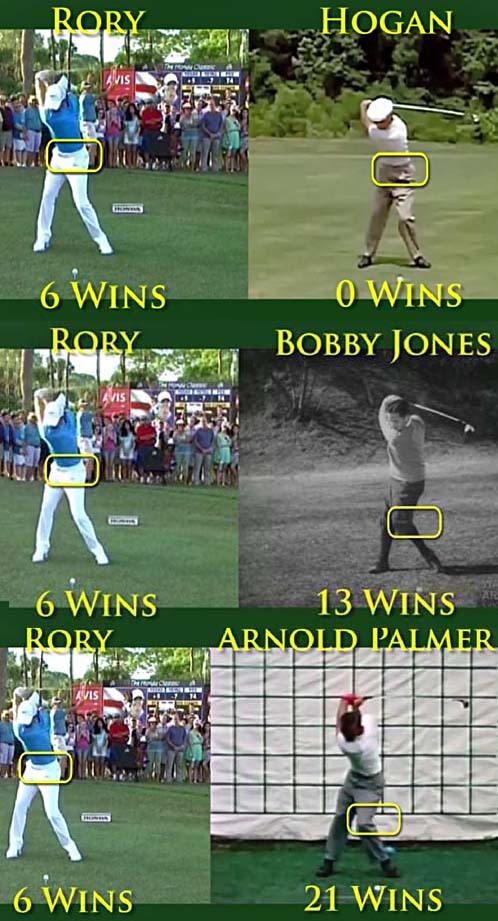
Downswing sequence in a number of professional golfers - capture images from the SPI video
Note that the SPI presenter has drawn a yellow-colored box around Rory McIlroy's and Ben Hogan's pelvis and he claims that they both start the downswing with a pelvic lateral-bump motion (stage 2), while he has drawn a yellow-colored box around the left knee of Bobby Jones and Arnold Palmer to indicate that they start their downswing with their left knee (stage 1). Note that both Bobby Jones and Arnold Palmer have their left thigh more adducted and their left femur less externally rotated at their end-backswing position (when compared to Rory McIlroy and Ben Hogan), and that means that there must automatically/naturally be more lateral motion of the left knee in a targetwards direction at the start of the downswing. However, how can one rationally equate a greater degree of targetwards motion of the left knee during the P4=>P5 early downswing time period with increased swing power (derived from the legs) and a better multi-stage swing sequence?What causes the left knee to move targetwards at the start of the downswing and how does it increase swing power?
I believe that the left knee moves targetwards at the start of the downswing due to activation of the lateral pelvic rotator muscles in the left buttocks that cause the left femur to become externally rotated, while the left thigh is simultaneously being abducted by the left hip abductor muscles. I consider these muscles to be pelvic girdle muscles and I think that their activation is part-and-parcel of the pelvic motion that represents stage 2 of SPI's 5-stage sequence. I think that it may be reasonable to consider the "targetwards motion of the left knee" as a separate stage-action if it visibly precedes the rotary motion of the pelvis (that is secondary to activation of the lateral pelvic rotator muscles in the left and right buttocks) - as can be seen in Bubba Watson's animated gif image. The SPI golfer (who presumably is representative of the SPI-recommended swing action) also manifests this pattern.
SPI golfer (face-on view) swing video - https://www.youtube.com/watch?v=w70V7IAwBIQ
Here are capture images from his transition.
SPI golfer's stage 1 move - capture image from his swing video
Image 1 shows the SPI golfer at his end-backswing position.Image 2 shows how his left knee moves overtly targetwards as he starts his downswing action - seondary to activation of the lateral pelvic rotator muscles in his left buttocks combined with the simultaneous activation of his left hip abductor muscles. It gives him the appearance of "sitting on a horse with his knees spread-eagled apart". It may be somewhat reasonable to classify this "targetwards left knee motion" as a separate stage in the downswing sequence if it becomes overtly manifest (as seen in the SPI golfer), but I don't believe that it can increase swing power. How can it? Note that his pelvis has already started to rotate counterclockwise due to activation of the lateral pelvic rotator muscles in his right buttocks, which causes his pelvis to rotate counterclockwise away from his right femur, and I would classify both actions as being a stage 2 pelvic motion (due to bilateral activation of the lateral pelvic rotator muscles in both the left and right buttocks) and the only difference (relative to Rory McIlroy) is the "fact" that his left femur abducts more during the initiation of the rotary pelvic motion process, which starts the downswing action. However, I personally cannot understand the advantage of classifying a greater degree of left femur abduction (that happens during the pelvic rotary motion stage) as being a separate stage (leg power stage)! It is certainly not required to drive the ball a long distance, because many long-drive competitors do not manifest this exaggerated left femur abduction phenomenon. Consider again the example of Jeff Flagg, who won the 2014 ReMax long-drive competition.
Jeff Flagg swing video - https://www.youtube.com/watch?v=OsRLqnef1Xo
Here are capture images of his downswing action.
Jeff Flagg's downswing action - capture images from his swing video
Image 1 shows Jeff Flagg at his end-backswing position and image 2 shows him at the P5 position - note that his left knee didn't move targetwards to an exaggerated degree during the P4=>P5 time period, and note that his "left knee action" looks similar to that seen in Rory McIlroy's and Ben Hogan's early downswing action. Also, note how he bumps his pelvis left-laterally (like Rory McIlroy and Ben Hogan) at the start of his early downswing.There is another/alternative mental conception of "leg power" that I can understand, and that relates to the "fact" that a skilled golfer can lose ~25% of his ball flight carry distance if he drives the ball while sitting-on-his-knees. Here is an example - Lucas Wald.
Lucas Wald driver swing video (performed while sitting-on-his-knees) - https://www.youtube.com/watch?v=Yh_lfB1MhGY
Here are capture images from his swing video.
Lucas Wald's downswing action while sitting-on-his-knees - capture images from his swing video
I have traced his hand arc path in blue, and it looks similar to his hand arc path when driving while standing. However, he can only drive the ball about 250 yards when sitting-on-his-knees - compared to 330 yards when standing. That represents a loss of about 25% of his potential driving distance (which is about "average" when I looked at a number of videos of other professional golfers who drive from a "sitting-on-one's-knees" position), and many golfers may consider that 25% loss as being due to a loss of the "leg power" contribution to swing power. However, I think that it really represents a loss of pelvic rotary motion power - because it is very difficult to rotate the pelvis very efficiently and very fast when driving from a sitting-on-one's-knees position. Standing up in the standard address posture (with the knees slightly flexed and biomechanically "lively") allows the pelvis to rotate much more efficiently and much faster during the downswing's P4=>P6 time period, and I consider the 25% loss of carry distance as being representative of a loss of pelvic motion power (and not a loss of leg power). In other words, although I do not believe that the legs actually power the golf swing, they can certainly enable the pelvis to shift-rotate in a maximally efficient manner.The SPI presenter defines separation as being the "amount of time between each stage in the downswing", and he claims that Rory McIlroy starts his downswing with stage 2 and that he then fires all the remaining stages simultaneously with no visible separation between stages 3, 4 or 5. He, unfortunately, didn't elaborate on this topic, so I have no idea what he means when he asserts that Rory McIlroy fires stages 3, 4 and 5 at the same time. I therefore regard his personal opinions regarding the topic of Rory McIlroy's separation as being meaningless gobbledegook!
The SPI presenter them moves on to a discussion of speed, which he defines as hip speed. The SPI presenter thinks of the rotating pelvis as being a great multiplier that can increase the speed of movement of the left arm-club unit by a factor of 25X and he uses an analogy of a propeller attached to a metal shaft. That propeller analogy is over-simplistic, and not useful, because the left arm-club unit is not directly attached to a single-torso-axial shaft unit that rotates as a single unit. Also, the left arm can move independently in the left shoulder socket due to activation of the left shoulder girdle muscles, which is not part of his over-simplistic propeller unit analogy. The SPI presenter also asserts that for every fractional moment-in-time that Rory McIlroy bumps his pelvis left-laterally, he is losing time that could be fruitfully used to rotate his pelvis efficiently. That argument is wrongheaded because Rory McIlroy bumps his pelvis left-laterally at the start of his downswing while he is simultaneously rotating his pelvis counterclockwise. The TPI presenter also seemingly doesn't understand that Rory McIlroy only bumps his pelvis left-laterally to a very small degree because he starts his downswing from a right-loaded pelvic motion P4 position, and he needs to first center his pelvis so that he can efficiently perform a rotary pelvic motion where his pelvis remains roughly centralised between his feet during the remainder of his downswing action.
Here are capture images of Rory McIlroy's downswing action.
Rory McIlroy's downswing action - capture images from his swing video
Image 1 - I have drawn green lines alongside the outer border of Rory McIlroy's pelvis and upper thighs at his end-backswing position. Note that his pelvis is not perfectly centered and it is closer to his right foot, which means that he is using a right-centered pelvic motion loading technique during his backswing action.Image 2 shows Rory McIlroy at the P5 position. Note that he has shifted his pelvis targetwards to a small degree, so that his pelvis becomes roughly centered between his feet by the end of his early downswing.
Image 3 shows Rory McIlroy at impact. I have drawn a red arrowed line vertically downwards from the outer border of his left pelvis and it strikes the ground just inside his left foot.
The SPI presenter then shows a video of the SPI golfer performing a downswing action, and he seemingly implies that the SPI golfer doesn't bump his pelvis left-laterally (like Rory McIlroy). However, he is obviously wrong!
Consider this series of capture images of the SPI golfer's downswing action.
SPI golfer's downswing action - capture images from the SPI video presentation
Image 1 shows the SPI golfer at his end-backswing position. I have drawn red lines alongside the outer border of his pelvis/upper thighs. Note that his pelvis is not perfectly centered between his feet and it is closer to his right foot, which means that he is using a right-centered pelvic motion loading technique during his backswing action.Image 2 shows the SPI golfer at the P5 position. Note how much he has shifted his pelvis targetwards during his early downswing action in order to center his pelvis by the end of his early downswing. It may "look" like he is not bumping his pelvis targetwards because he manifests an exaggerated left femur abduction/external rotation maneuver that causes his left femur to be slanted away from the target.
Image 3 shows the SPI golfer at impact. Note how much he has shifted his pelvis targetwards during the P4=>P7 time period, and it is similar in degree to the amount of pelvic shift manifested by Rory Mcilroy. I have drawn a green arrowed line vertically downwards from the outer border of his left pelvis, and it strikes the ground just inside his left foot. The outer border of his left pelvis is located slightly more inside his left foot (when compared to Rory McIlroy) because his left femur is slanted more away from the target than Rory McIlroy's left femur. However, there is very little difference in the total amount of targetwards pelvic shift happening in his downswing (versus Rory McIlroy's downswing) - even though the SPI presenter implies that the SPI golfer doesn't bump his pelvis targetwards during his downswing action!
The SPI presenter then proceeds to define hip speed as the amount the pelvis rotates (in angular degrees) during the downswing action, and he compares Rory McIlroy to the SPI golfer.
Hip speed comparison - capture images from the SPI video
The SPI presenter uses the term "hip speed" when it is biomechanically more correct to use the term "pelvic rotational speed". He then amazingly, and wrongheadedly, claims that one can measure pelvic rotational speed by measuring the change in pelvic rotational angles between the P4 and P7 positions. Rory McIlroy's pelvis is rotated 45 clockwise at the P4 position, and it is 45 degrees open to the target at impact, which means that his pelvis rotates 90 degrees during his downswing action. By contrast, the SPI golfer's pelvis is rotated 45 degrees clockwise at the P4 position, and it is 60 degrees open at impact, which means that his pelvis rotates 105 degrees during his downswing action. However, those values represent the total angular range of pelvic rotational motion that happens during the downswing action, and it has nothing to do with pelvic rotational speed. Pelvic rotational speed usually reaches its maximal value during the mid-downswing (or early phase of the late downswing) and Rory McIlroy has an extremely fast pelvic rotational speed of ~700 degrees/second while the average professional golfer has a pelvic rotational speed of 550 degrees/second - as shown in ESPN's Sports Science video. The SPI presenter is mixing up two different concepts, and he is wrongly asserting that Rory McIlroy has a low pelvic rotational speed when the true reality is that Rory McIlroy rotates his pelvis at a blazingly fast speed between P4 and P6+.The SPI presenter then discusses the topic of stability and he has a strange definition of stability, which he states is measured by the "change in right knee angle between address and impact". He amazingly claims that Rory McIlroy's stability score is 97-425% more unstable compared to famous major winners (like Bobby Jones, Jack Nicklaus, Arnold Palmer, Larry Nelson and Tiger Woods).
The SPI presenter measures the right knee angle at the address position, P4 position, P5 position and impact position.
So, the right knee angle measurements for Rory McIlroy are 168 degrees (address), 165 degrees (P4 position), 134 degrees (P5 position) and 165 degrees (impact).
Here is a comparison between Rory McIlroy and Arnold Palmer.
Right knee angle measurement comparison - capture image from the SPI video
Note that both Rory McIlroy and Arnold Palmer have flexed knees at the P5 position, and there is only a 6 degree difference between the two golfers.However, they have different right knee angle measurements at impact - 165 degrees for Rory McIlroy and 149 degrees for Arnold Palmer.
The SPI presenter is therefore concluding that Rory McIlroy bobs "down-and-then-up" too much during his downswing action, and he concludes that this represents a marked degree of instability. Now, although I have also expressed the same ideological belief that it is not a good idea for a golfer to bob "down-and-then-up" too much during the downswing, I think that it is mistake to use the right knee angle for measurements of the degree of bobbing - because the right knee angle at P5 and at impact is affected by too many confounding variables (eg. how open the pelvis is at impact; whether one lifts one's right heel up a lot during the early downswing or whether one simply rolls the right ankle inwards; whether one gets up onto the toes of ones' right foot at P5 (like Jeff Flagg) or whether one keeps one's right foot more grounded at the P5 position; whether one actively "kicks-in" the right knee at the start of the downswing). I think that it is much more accurate to evaluate the degree of pelvic bobbing motion that is happening during the downswing by simply evaluating how much the pelvis lowers-and-then-elevates on a face-on swing video.
Here is an example - featuring Rory McIlroy.
Rory McIlroy's bobbing motion - capture images from his face-on swing video
Image 1 shows Rory McIlroy at address. I have drawn a blue line at the top of his head, and two red lines at the level of his pelvic crest.Image 2 shows Rory McIlroy at his end-backswing position - note that his pelvis has dropped down (groundwards) due to increased bilateral knee flexion. Note that it causes his head to drop by roughly the same amount.
Image 3 shows Rory McIlroy at the P5 position. Note that his pelvis has not dropped down more (compared to its P4 position), but his head had dropped down more due to increased flexion at the level of his hip joints and due to his loss of the arch-extension manuever (left thoracic spine extension maneuver).
Image 4 shows Rory McIlroy at impact. Note that his pelvis has elevated a few inches (and it is back to its P1 position pelvic height level). I think that the extent of Rory McIlroy's pelvic elevation (that happens between P5 and impact) is not markedly excessive and I think that it not much more than the amount seen in many other professional golfers. Although I personally don't approve of Rory McIlroy's significant degree of pelvic bobbing ("down-and-then-up") motion during his downswing action, I think that it is ridiculously wronheaded to claim that Rory McIlroy has a 97-425% greater degree of instability (relative to other professional golfers) when it comes to evaluating the degree of vertical motion of his pelvis during his downswing action!
After discussing the topic of stability, the SPI presenter goes on to discuss the topic of alignment - which refers to spine alignment in two dimensions (face-on and DTL).
The SPI presenter refers to the degree of rightwards tilt of the spine (as seen on a face-on view video), which is equivalent to the degree of secondary axis tilt in the downswing, as the first source for his measurement of alignment.
Here is Rory McIlroy's spinal alignment measurement.
Rory McIlroy's degree of secondary axis tilt during his late downswing - capture image from the SPI video
Rory McIlroy has a spinal tilt measurement of 26 degrees at impact, which is similar to the amount seen in the artist-drawn image of Ben Hogan in Ben Hogan's book [6].The SPI presenter wrongheadedly claims that acquiring a large degree of secondary axis tilt during the late downswing causes a greater loss of accuracy than "anything else during the swing". He claims that a large degree of secondary axis tilt causes an open clubface at impact. However, I disagree! I think that many professional golfers have a large degree of secondary axis tilt in their late downswing - especially golfers who use the reverse group pattern of weight-pressure shift during their late downswing action (like Bubba Watson and Jamie Sadlowski) and they have a much greater degree of secondary axis tilt than Rory McIlroy in their late downswing, and they do not have an open clubface at impact. I think that having an open clubface at impact, when it is causally associated with a large amount of secondary axis tilt, is most likely due to a "hanging back" problem where the golfer leans away from the target during his late downswing and where the hands are not driving actively through the immediate impact zone. I can readily agree that the swing fault of "hanging back" may cause an open clubface at impact, but that's a swing fault mainly seen in amateur golfers, and not professional golfers. I think that there is no evidence that Rory McIlroy has an inclination to have an open clubface at impact due to a "hanging back" swing fault, and I do not believe that he has to "rescue the shot" by using some type of hand manipulation technique through impact.
By the way, note that the SPI golfer has much more secondary axis tilt than Rory McIlroy - here are capture images from his swing video.
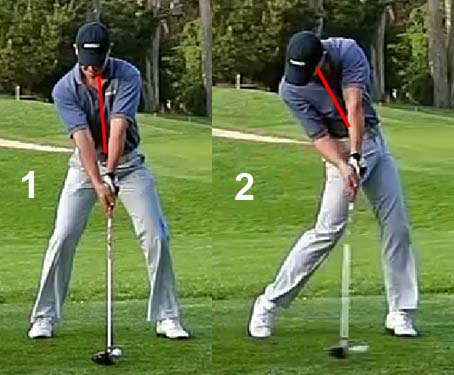
SPI golfer's degree of secondary axis tilt at impact - capture images from his swing video
Image 1 is at address, and image 2 is at impact. The red line is drawn down the length of his spine. Note that the SPI golfer has much more secondary axis tilt than Rory McIlroy at impact (~35 degrees of secondary axis tilt) and he doesn't have an open clubface at impact!The SPI presenter then moves onto a discussion of the spine bend angle as viewed from a DTL perspective.
The SPI presenter claims that Rory McIlroy changes his spine angle from 27 degrees at address to 9 degrees at impact.
Spine bend angle as measured by the SPI - capture images from the SPI video
The SPI presenter states that Rory McIlroy has to change his spine bend angle during his downswing, and become more erect at impact, in order to avoid mishitting the ball.Consider the SPI presenter's wrongheaded line-of-reasoning-: The SPI presenter notes that Rory McIlroy has his left arm hanging down near-vertically from his left shoulder socket at address, which means that that he has a finite accumulator #3 angle at address. He then claims that the clubhead will be generating a centrifugal (outward-pulling) force of 100lbs at impact, and that the CF force will invariably pull the left arm-clubshaft into a straight-line relationship (thereby decreasing the accumulator #3 angle) and that this "outward-pulling" phenomenon will add 7 inches to the radius of his clubhead arc. Therefore, he wrongheadedly reasons that Rory McIlroy must lose his spine bend angle in his later downswing, as he nears impact, by becoming more erect, so that he can still contact the ball with the sweetspot of the clubface (which is "supposedly" 7 inches further from his left shoulder socket at impact). I think that his flawed reasoning is wrongheaded from many perspectives.
First of all, I believe that the CF ("outward-pulling") force of 100lbs only occurs for a fractional moment-in-time after the club releases, and it lasts for such a short time period that a golfer cannot even "feel" any outward pull of the club. Also, many professional golfers (like Ben Hogan and Hunter Mahan and Keegan Bradley) get their hands back down to the hand plane at impact, and there is no significant change in the distance of their hands from the ball (relative to address) or any change in their accumulator #3 angle - despite the presence of a CF-force of 100lbs being operant during their late downswing. The SPI presenter also doesn't take into account the fact that the left shoulder socket is further away from the ball at impact (relative to address), which means that a golfer automatically/naturally adjusts for any increase in the length of the left arm-clubshaft unit due to any decrease in the accumulator #3 angle. So, in Rory McIlroy's particular case, he has a slightly smaller accumulator #3 angle at impact (relative to address) because his club is on the elbow plane through impact (when it was on the hand plane at address), but the increased length of the left arm-clubshaft unit is automatically/naturally countered by the fact that his left shoulder socket at impact is further away from the ball than it was at address. In other words, Rory McIlroy does not have to significantly change his spine bend angle from address to impact by becoming more erect. In fact, I don't think that Rory McIlroy even changes his spine bend angle at all during his downswing action, and I believe that the SPI presenter's yellow lines (in the above capture image) don't really measure Rory McIlroy's spine bend angle. Note that he has drawn a yellow line parallel to Rory McIlroy's lumbar spine in image 1 (address image) and that yellow line also reflects his thoracic spine bend angle because his lumbar spine is in a straight-line relationship with his thoracic spine, but the yellow line in image 2 (impact image) does not reflect his spine bend angle, and it only *partly reflects his lumbar spine bend angle.
(* I use the adverb "partly" because the camera angle is not really perpendicular to his lumbar spine at impact, and it cannot therefore accurately reflect his lumbar spine angle)
I think that there is much better way of understanding, and measuring, a golfer's spine bend angle.
Spine bend angle measured correctly - capture images from the SPI video
The red dotted line represents Rory McIlroy's spine bend angle - using my technique of representing the "overall" spine bend angle with a straight line that is drawn from the L5 vertebra (bottom of the spine) to the T1 vertebra (top of the thoracic spine) at address (image 1), and also at impact (image 2). My "spine bend angle drawing" technique takes into account variations in the degree of right lateral bend, and variations in the degree of secondary axis tilt, that different golfers manifest during their downswing action. Using my technique, one can clearly see that Rory McIlroy doesn't significantly change his spine bend angle during his downswing action.The SPI presenter then claims that there is a solution to Rory McIlroy's spine bend alignment problem, and his solution is to recommend that all golfers make sure that their left arm-clubshaft is in a straight line relationship at address. The SPI golfer is used as a model for this "strange" technique.
The SPI' s concept of a swingplane - capture images from the SPI video
The yellow line represents an "idealised" swingplane, which is roughly equivalent to the TSP. The SPI presenter states that a golfer should get his left arm and clubshaft to become straight-line-aligned at address, so that the straight left arm-clubshaft unit lies along that yellow line. Then, he recommends that the golfer should take his left arm/clubshaft up that yellow swingplane line during the backswing, and then come down that same yellow swingplane line during the downswing - like an Iron Byron machine. I think that his recommendation is nonsensical because it is biomechanically unnatural and biomechanically very difficult to move the wrists in a biomechanically-natural manner using that "artificial" technique - while maintaining an intact LAFW/GFLW. I am therefore not surprised that professional golfers do not routinely use that technique! Ironically, even the SPI golfer does not use that Iron Byron technique.
SPI golfer versus an Iron Byron machine - capture image from the SPI video
Note that the SPI golfer's clubshaft goes way under the yellow swingplane line as he transitions from his P1 to his P3 position. That phenomenon likely has to happen if a golfer maintains an intact LAFW/GFLW during the takeaway swivel action and if the back of the GFLW is rotated clockwise so that it becomes parallel to the inclined plane during the P2-3 time period. As the SPI presenter often states in the SPI video, "feel" is not "real", and I think that the SPI presenter should also heed his often-expressed advice!Note also that the SPI golfer has his left arm and clubshaft on that yellow swingplane line at address (image 1) - and that he "artificially" has to ulnar-deviate his left wrist at address to accomplish that "artificial" goal. Also, note that his left arm is angled more groundwards at impact, and his left arm-clubshaft has a small accumulator #3 angle at impact that is identical to the magnitude of Rory McIlroy's accumulator #3 angle at impact. Also, note that both golfers have their clubshaft on the elbow plane, and not the TSP, at impact. Finally, note that both golfers have their right upper arm vertical at impact with their right forearm angled slightly flatter than the angle of the clubshaft at impact. I think that both Rory McIlroy and the SPI golfer are using a very similar pivot action and a very similar right arm/RFFW action in their downswing action!
What is also interesting is that the SPI golfer maintains his spine bend angle - despite acquiring a lot of secondary axis tilt and right lateral bend during his late downswing action - in the same manner as Rory McIlroy.
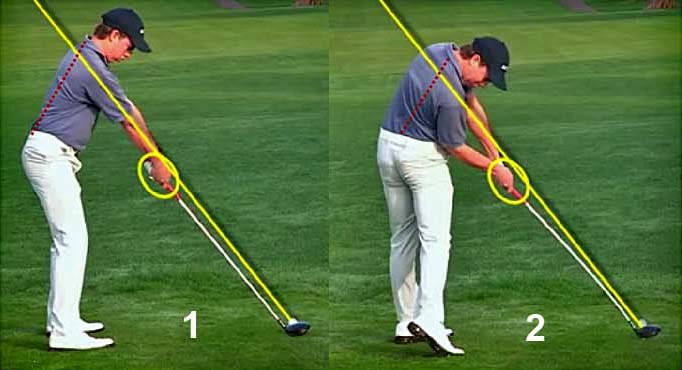
SPI golfer's spine angle - capture images from the SPI video
The red dotted line represents the SPI golfer's spine bend angle - using my technique of representing the "overall" spine bend angle with a straight line that is drawn from the L5 vertebra (bottom of the spine) to the T1 vertebra (top of the thoracic spine) at address (image 1), and also at impact (image 2). My "spine bend angle line" technique takes into account variations in the degree of right lateral bend, and variations in the degree of secondary axis tilt, that different golfers manifest during their downswing action. Using my technique, one can clearly see that the SPI golfer doesn't significantly change his spine bend angle during his downswing action - despite acquiring a lot of secondary axis tilt and right lateral bend during his late downswing action - and he looks very similar to Rory McIlroy at impact (except for the fact that his pelvis is more open to the target).
The SPI presenter ends his SPI video presentation by advising Rory McIlroy to get "rid of his bad swing". I disagree with his proferred advice! I think that Rory McIlroy should keep his "great" (but not "perfect") golf swing, and I think that you-tube golf video viewers should ignore all the wrongheaded opinions expressed in that SPI video.
Jeffrey Mann.
First version: January 2015.
References:
1. 1a. Spine Engine swing: Lateral Bend. Kelvin Miyahira.
Available at http://kelvinmiyahira.com/articles/54-2010-04-spine-engine-swing-lateral-bend
1b. Second Magical Key to the Spine Engine: Lumbar Lordosis. Kelvin Miyahira.
Available at http://kelvinmiyahira.com/articles/1-micro-moves-of-a-correct-backswing
2. The Spinal Engine. Serge Gracovetsky.
3. Serge Gracovetsky - Fascia Congress Part #1 of 3 - Boston 2007.
Available at https://www.youtube.com/watch?v=B-SMUA3QfVw&list=PL5DC2627D5F32C664
4. Interview with Serge Gracovetsky. "The spine engine: An unified theory of the spine?".
Available at http://www.somatics.de/Gracevetsky_Interview.pdf
5. The CIBA Collection. Musculoskeletal System. Frank H. Netter.Available at http://www.amazon.com/Collection-Medical-Illustrations-Musculoskeletal-System/dp/0914168142
6. Ben Hogan's Five Easy Lessons. Ben Hogan.
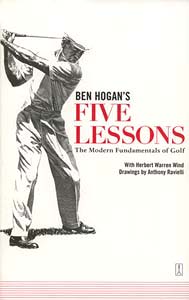
7. The Final Missing Piece of Ben Hogan's Secret Puzzle. VJ Trolio.

8. The Fundamentals of Hogan. David Leadbetter.

9. Jeffy golf forum thread; Jamie Sadlowski's hip rotation into impact. Jeff Martin = Jeffy.Available at http://jeffygolf.com/showthread.php?518-Jamie-Sadlowski-s-hip-rotation-into-impact
10. Weight Transfer Styles in The Golf Swing: Individual and Group Analysis. Kevin Ball. (PhD thesis, Victoria University, Australia, 2006).Available online at http://vuir.vu.edu.au/1432/1/Ball.pdf
11. Jeff Martin's post #56 in a thread in his Jeffy golf forum.See http://jeffygolf.com/showthread.php?775-What-s-wrong-with-this-picture
12. Parametric Acceleration - The Effect of Inward Pull of the Golf Club at Impact Stage. K Miura. Sports Engineering (May 2001) 4: 75-86.Abstract available at http://onlinelibrary.wiley.com/doi/10.1046/j.1460-2687.2001.00071.x/abstract
13. Brian Manzella's "Ideas About The Release" swing video - http://www.brianmanzella.com/shop
14. The X factor Swing. Jim McLean.
15. Losing one's Spine Angle. Kelvin Miyahira.
Available at http://www.aroundhawaii.com/lifestyle/health_and_fitness/2012-03-losing-your-spine-angle.html
16. GolfWRX.com golf forum thread: Kelvin Miyahira: pro or con.
Available at http://www.golfwrx.com/forums/topic/1082799-kelvin-miyahira-pro-or-con/page__st__690
17. Engineering Biomechanics of Human Motion. Robert L. Williams II. page 27.
Available at http://www.ohio.edu/people/williar4/html/PDF/Supplement4670.pdf
18. Bret Contreras' transcribed interview of Stuart McGill (one of the world's foremost spinal biomechanists).
Available at http://bretcontreras.com/transcribed-interview-with-stu-mcgill
Stuart McGill's CV - www.ahs.uwaterloo.ca/kin/documents/McGill%20Full%20Sept%202011.pdf
19. Second Magical Key to the Spine Engine: Lumbar Lordosis. Kelvin Miyahira.
20. Lecture by Serge Gracovetsky - "Is the Lumbodorsal Fascia Necessary?'
Available at http://functionalanatomyblog.com/2011/03/07/lecture-by-serge-gracovetsky-is-the-lumbodorsal-fascia-necessary/
21. Manuel de Los Santos official website - http://manueldelossantos.com/us
